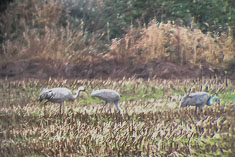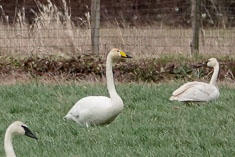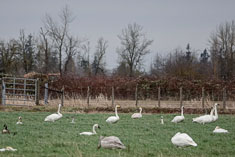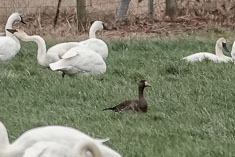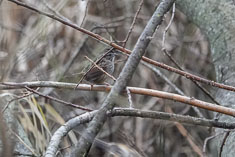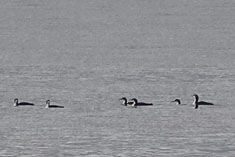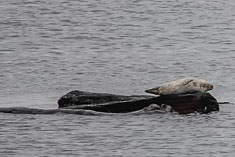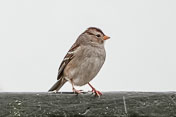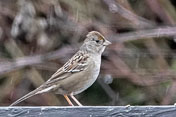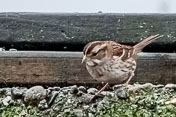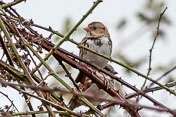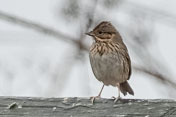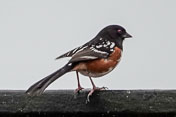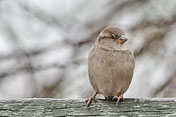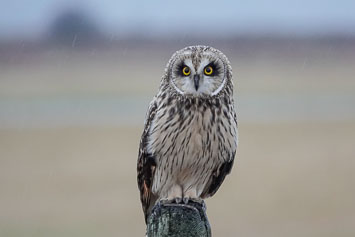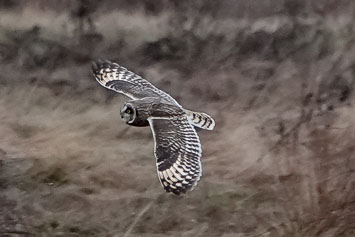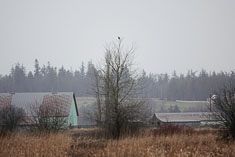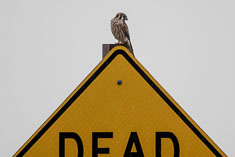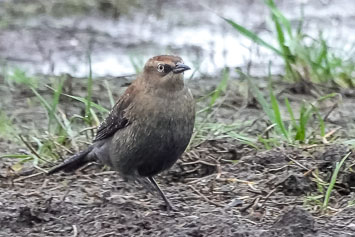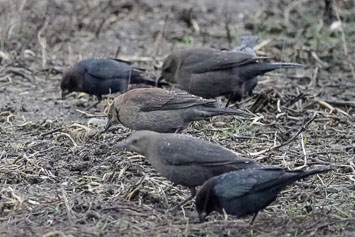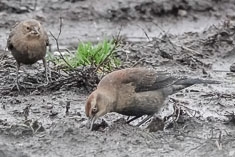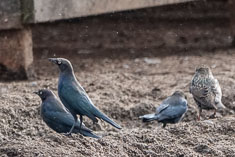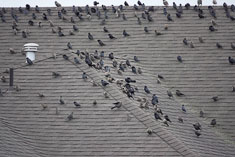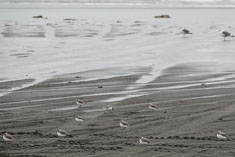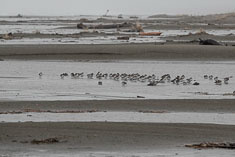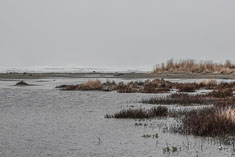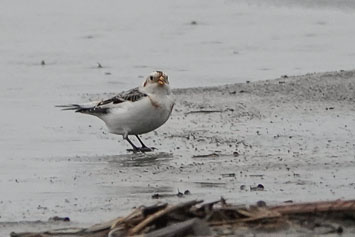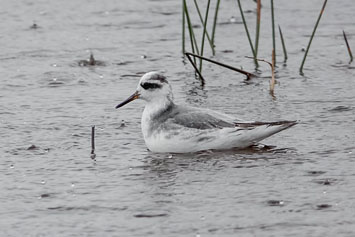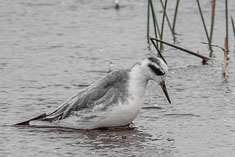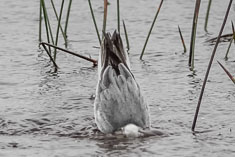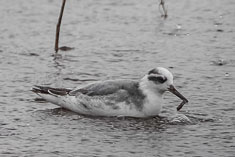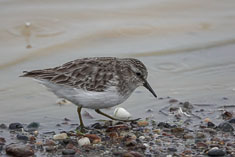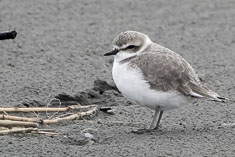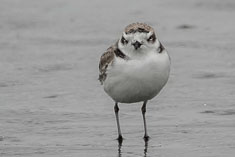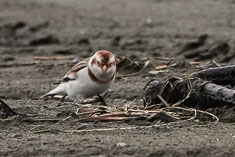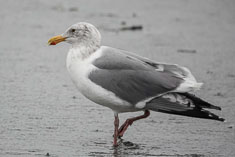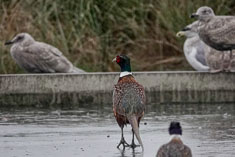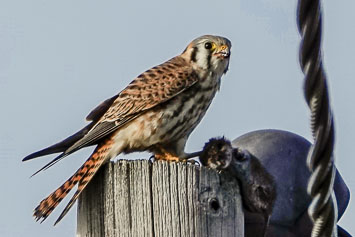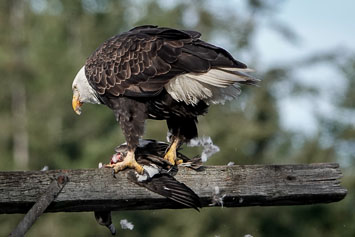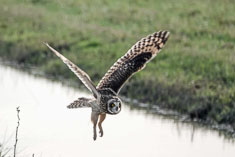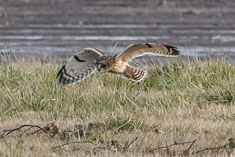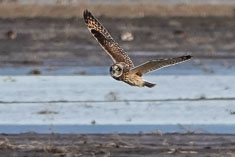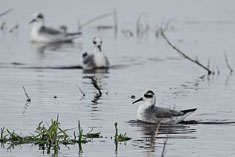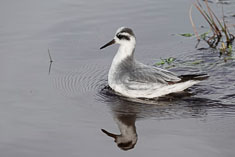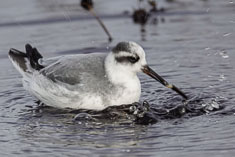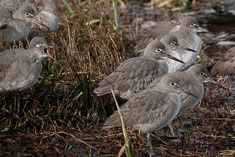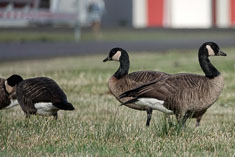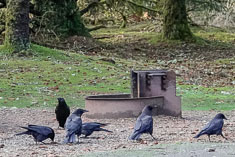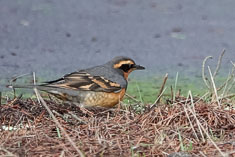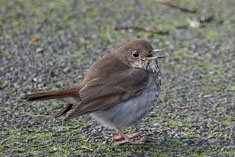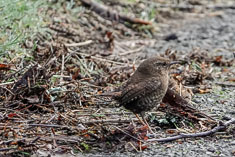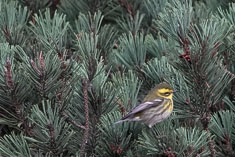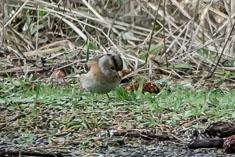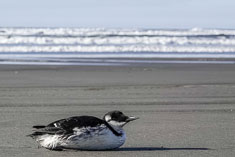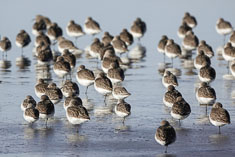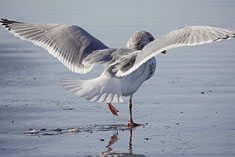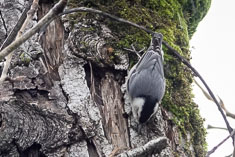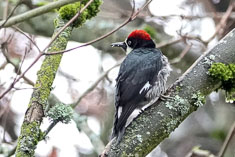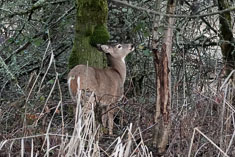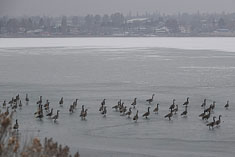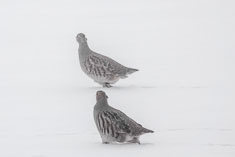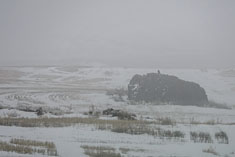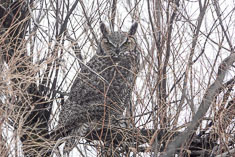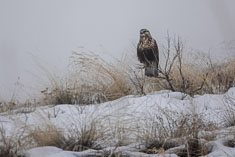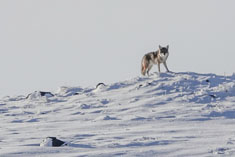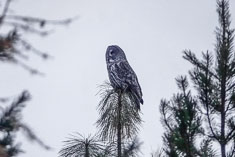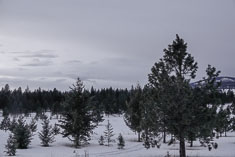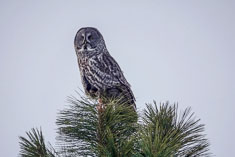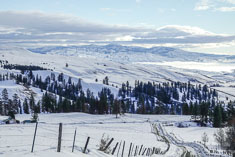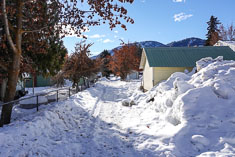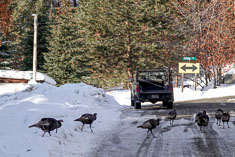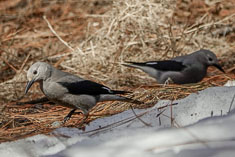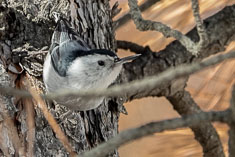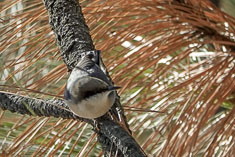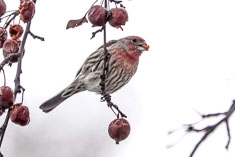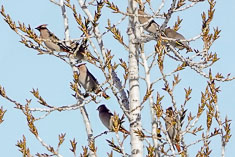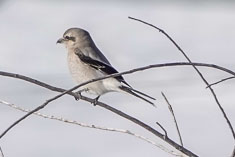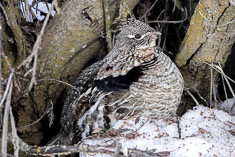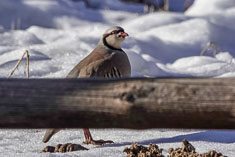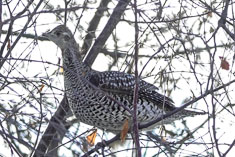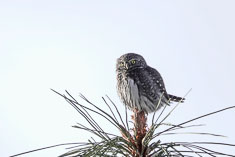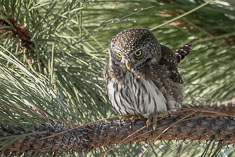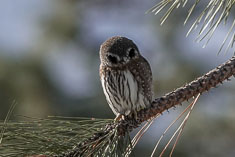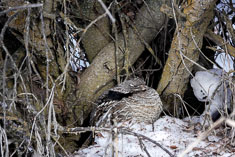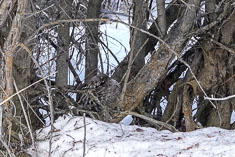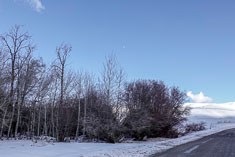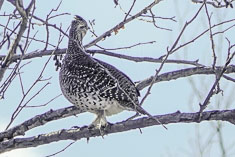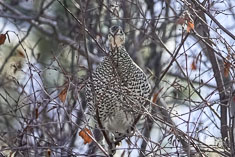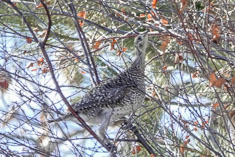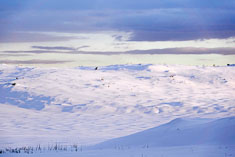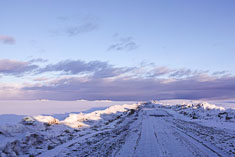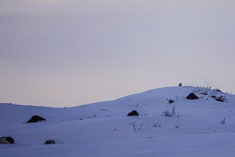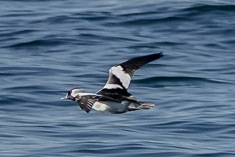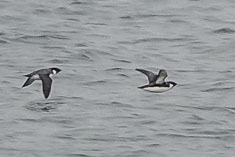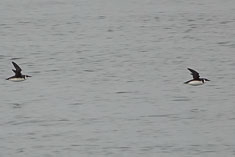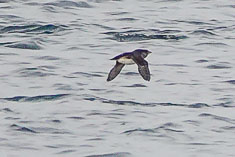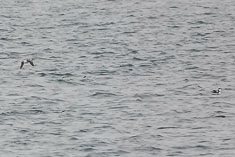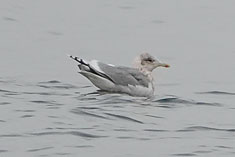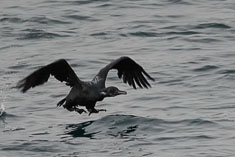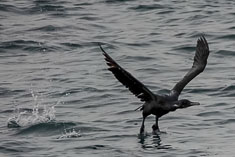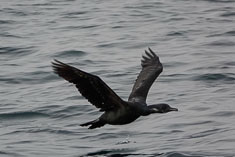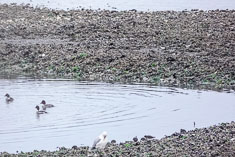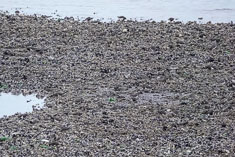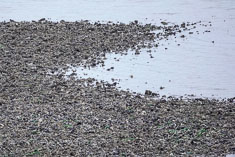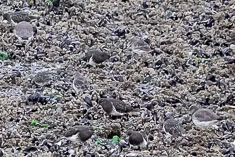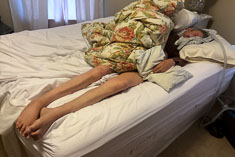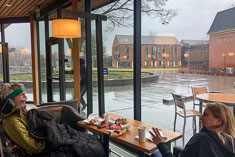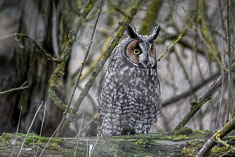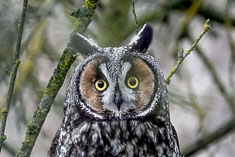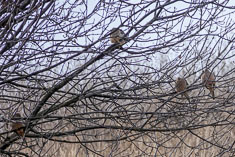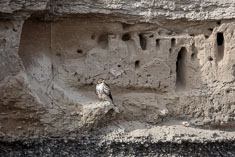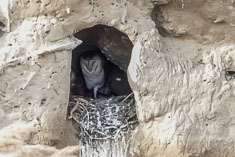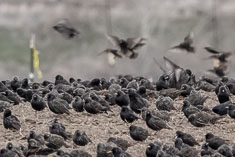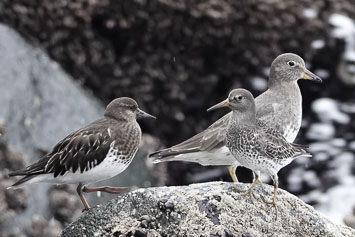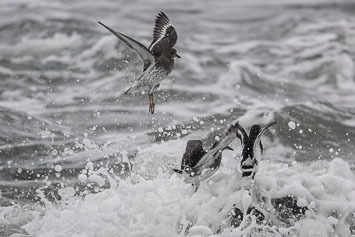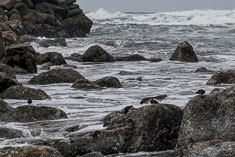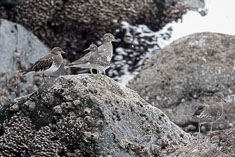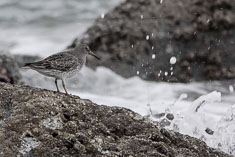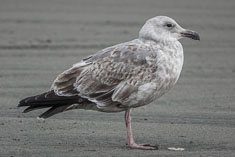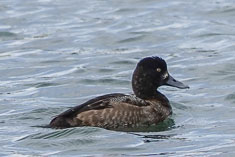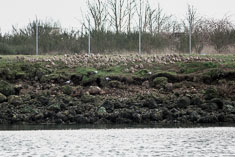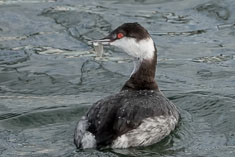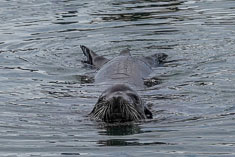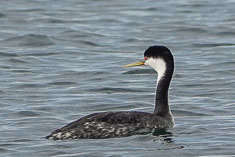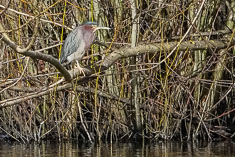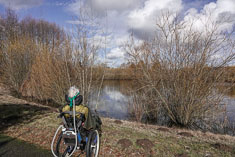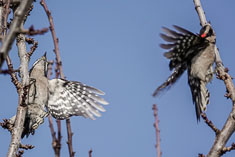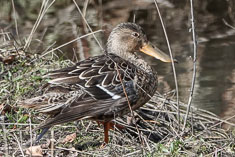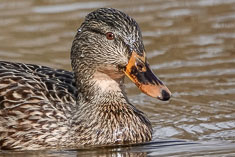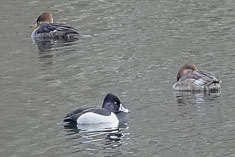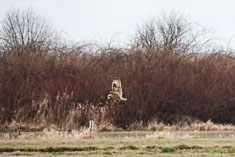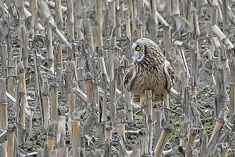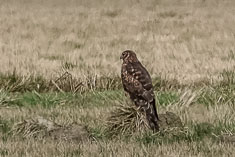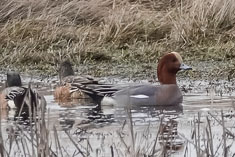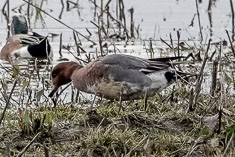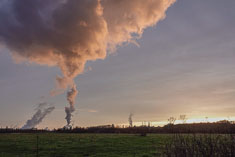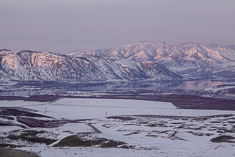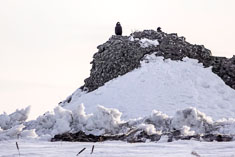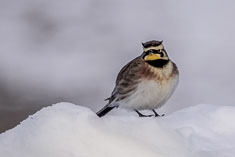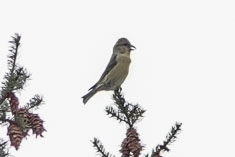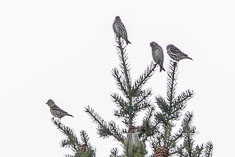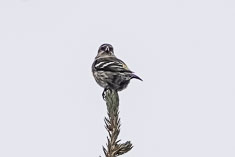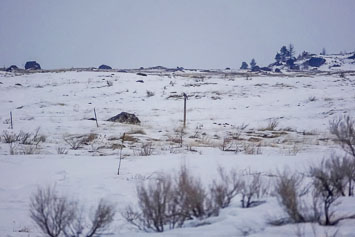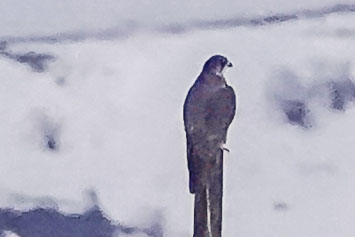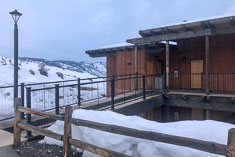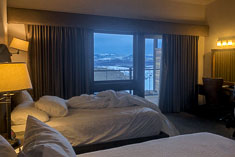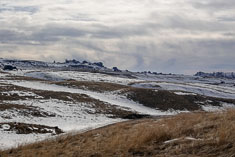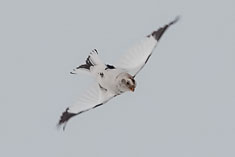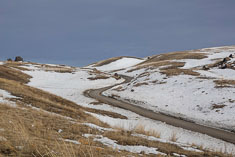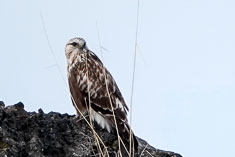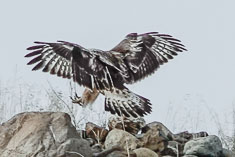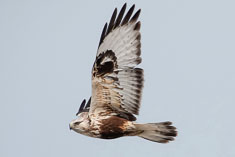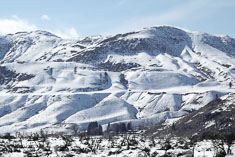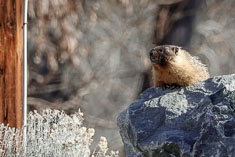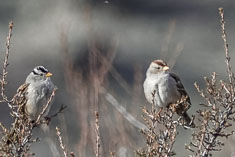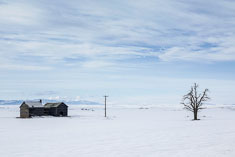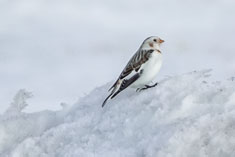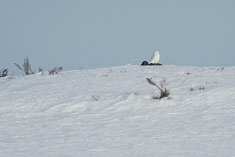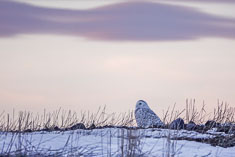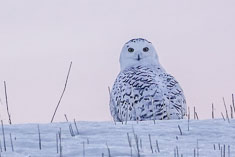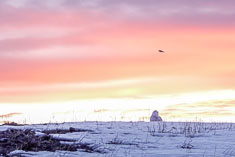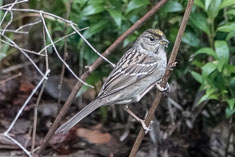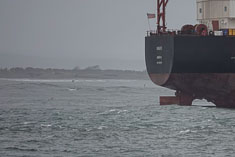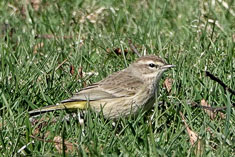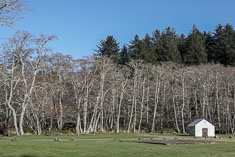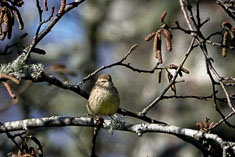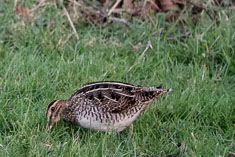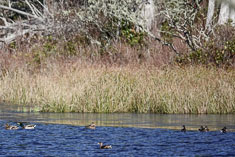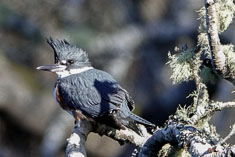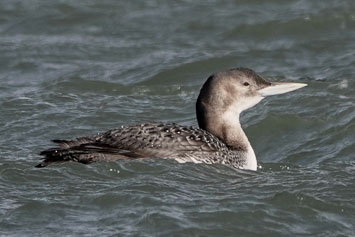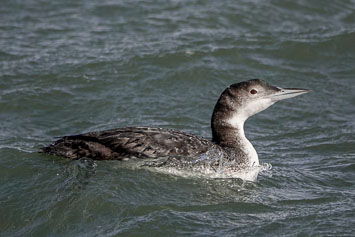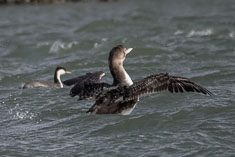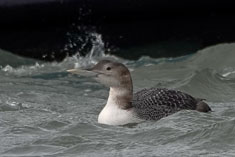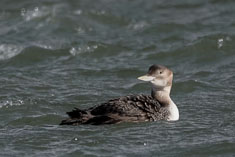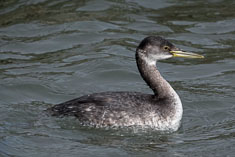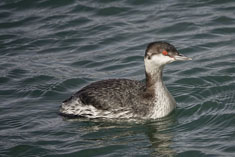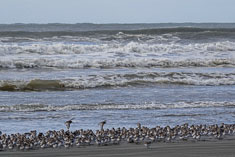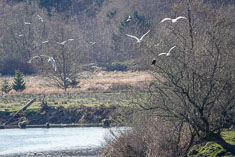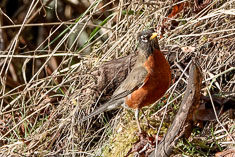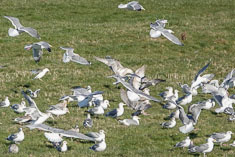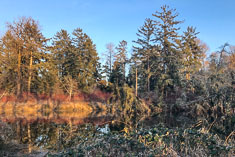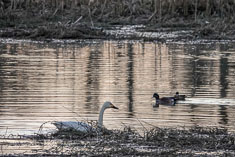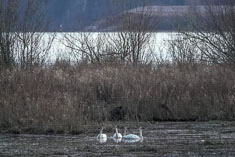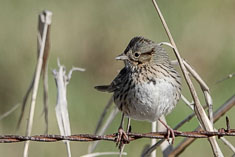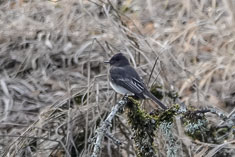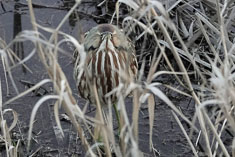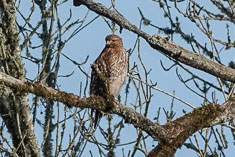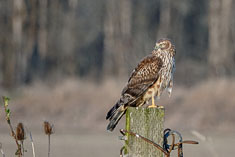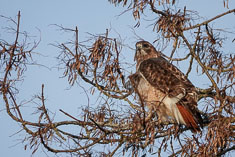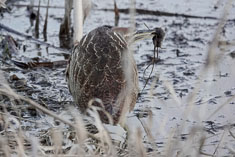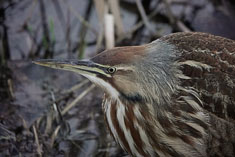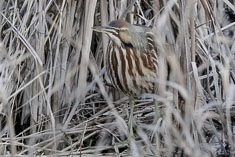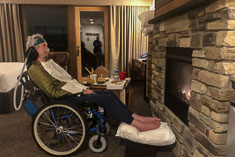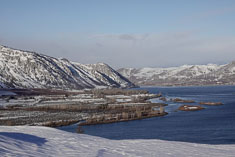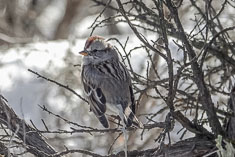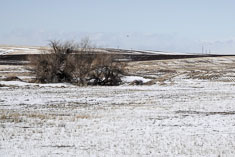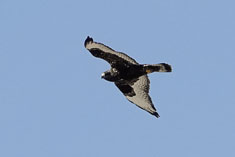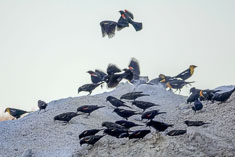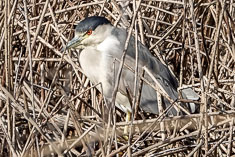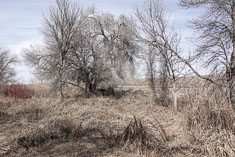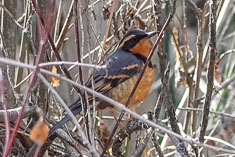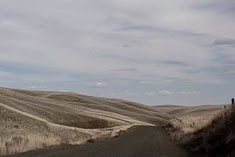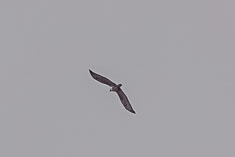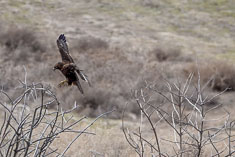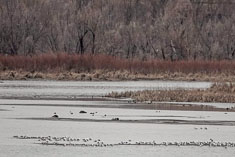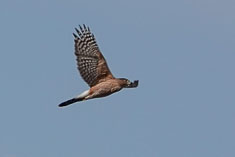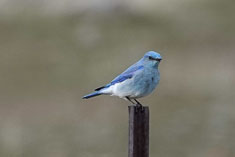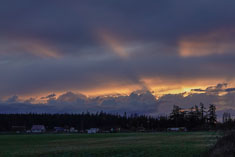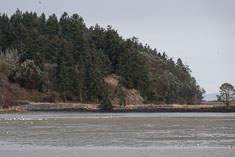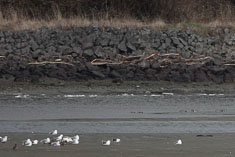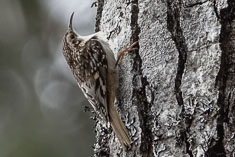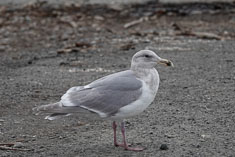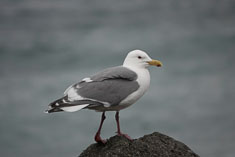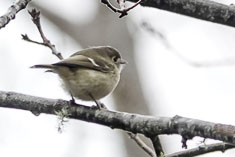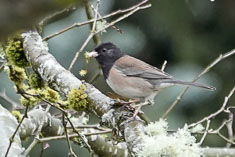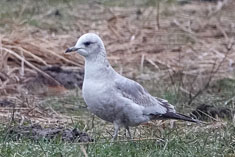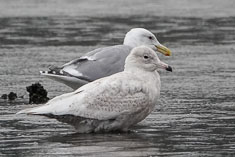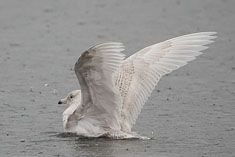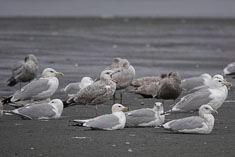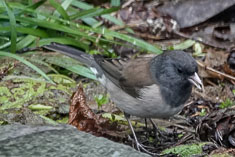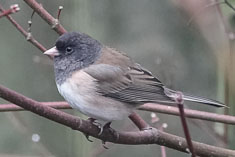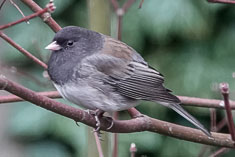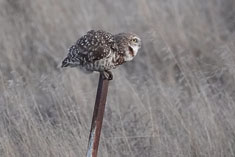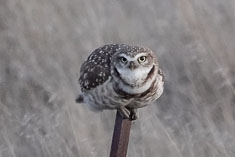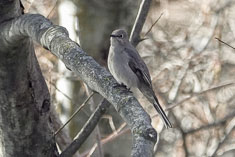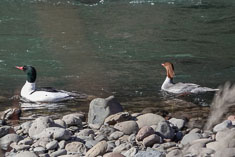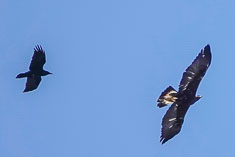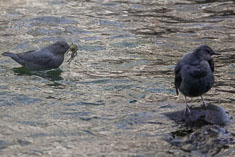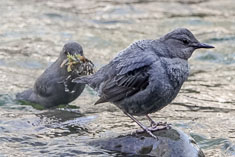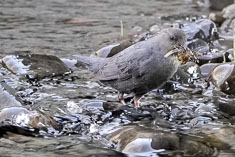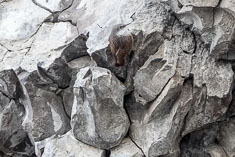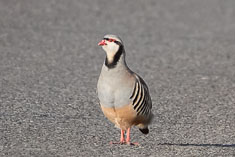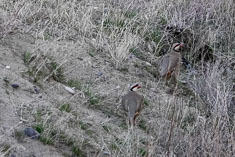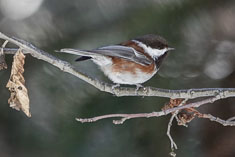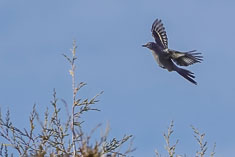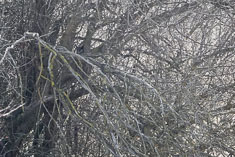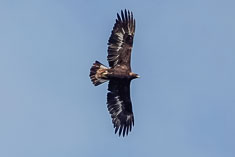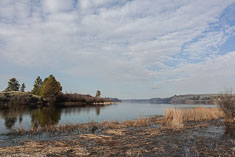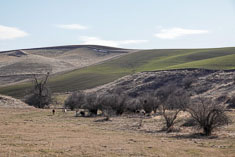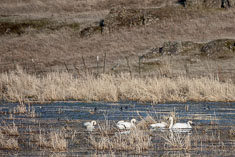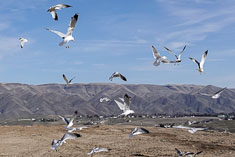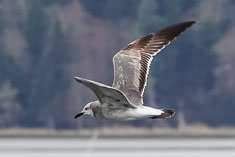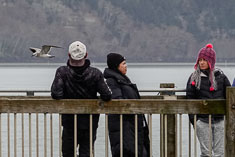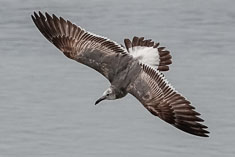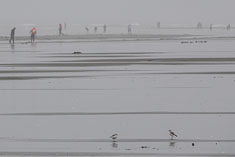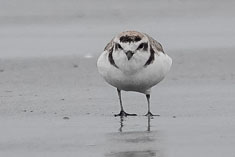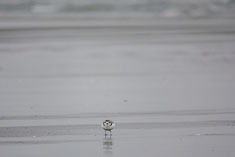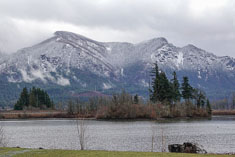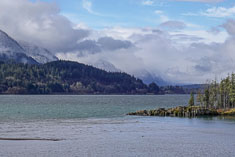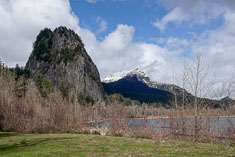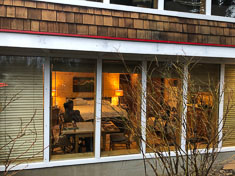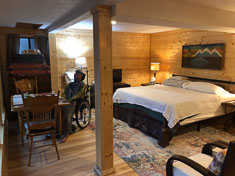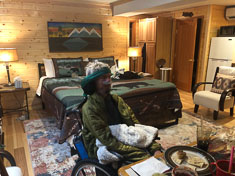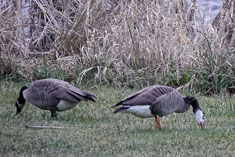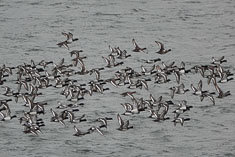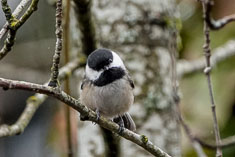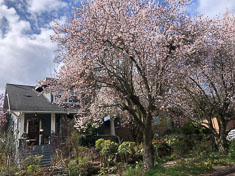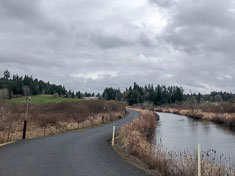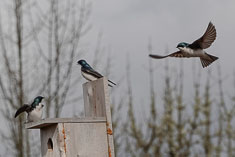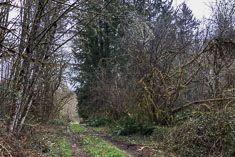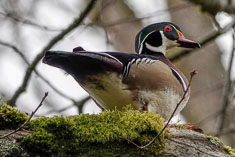1/01/2023 Not a very big day (link to here)
Happy New Year! We did not go birding today.
Were it not now two weeks later, I might have been able to remember what we did instead. I remember that I lay in bed one morning reflecting on the year past, which was good, and the year ahead, which might not be. It might not have been on New Year's morning that I was doing that reflecting, but it was close. Our big year project, to see or hear as many birds as we could in Washington state in one year, was over. I had anticipated feeling a big letdown once it was over, but what I felt instead was very satisfied. The project gave structure to the year, a beginning as well as a clear ending, and left me with a sense of really having done something during that 365 day period. Now that the project was over, the new year really felt like a new beginning. For the first time in a year, there was no need to go out and look for a bird. I did not even look out the window at one, all day long, though I think I did accidentally see a Junco fly by.
Happy New Year! We did not go birding today.
Were it not now two weeks later, I might have been able to remember what we did instead. I remember that I lay in bed one morning reflecting on the year past, which was good, and the year ahead, which might not be. It might not have been on New Year's morning that I was doing that reflecting, but it was close. Our big year project, to see or hear as many birds as we could in Washington state in one year, was over. I had anticipated feeling a big letdown once it was over, but what I felt instead was very satisfied. The project gave structure to the year, a beginning as well as a clear ending, and left me with a sense of really having done something during that 365 day period. Now that the project was over, the new year really felt like a new beginning. For the first time in a year, there was no need to go out and look for a bird. I did not even look out the window at one, all day long, though I think I did accidentally see a Junco fly by.
1/02/2023 Merry Christmas (link to here)
Ben and Sally and the kids, along with Ben's dad John, arrived around 5PM on New Year's Day. Richard and Donna had planned to come as well but Richard had tested positive for Covid on Christmas Eve and we all agreed he should quarantine a bit longer. Sally and Darchelle took the kids shopping for Christmas presents at Darchelle's two favorite Goodwills. The kids each picked out something they wanted then Darchelle wrapped everything and put the presents under the tree, without labels. After dinner we all sat down in the living room and opened one present each in order. As each gift was opened everyone guessed for whom it was intended. The children proved to be quite skilled at this game but we all enjoyed it, and in the end everyone was pretty happy with what they had received.
Ben and Sally and the kids, along with Ben's dad John, arrived around 5PM on New Year's Day. Richard and Donna had planned to come as well but Richard had tested positive for Covid on Christmas Eve and we all agreed he should quarantine a bit longer. Sally and Darchelle took the kids shopping for Christmas presents at Darchelle's two favorite Goodwills. The kids each picked out something they wanted then Darchelle wrapped everything and put the presents under the tree, without labels. After dinner we all sat down in the living room and opened one present each in order. As each gift was opened everyone guessed for whom it was intended. The children proved to be quite skilled at this game but we all enjoyed it, and in the end everyone was pretty happy with what they had received.
1/04/2023 Common Crane (link to here)
To kick off a new year of birding, the bird I most wanted to see was the Common Crane which Liam
discovered along the Brady Loop
Road l+ about 40 hours too late for us to include it in last year's big year list +. We found it easily thanks to David
S and other birders who were already watching it but
it was far out in a field. Although we had forgotten to bring the camera Darchelle was able to get a
few shots through the scope with her phone. I had a brief view when she leaned the tripod up against
my chair then I was ready to head home, but Darchelle wanted to stop at
Theler Wetlands l+
to see the Long-eard Owls which everyone has been reporting there. Even Ed and Delia had gone to
see them, which was fortunate for us because Delia was able to tell us exactly where to go. We went
straight there, after a few wrong turns, and found no owls, at least at first. Then Darchelle,
walking down the trail about 30 yards beyond the spot, flushed one and I saw it. She did not, but
returned to search the official spot more thoroughly and soon spotted the other owl. It would have
been a great photo op if she'd had the camera but once again she had to make do with her phone.
With her help I was able to discern the bird as well, but only because it was preening and I could
to see the movement. Good enough!
1/05/2023 Whooper Swan (link to here)
Flush with yesterday's successes we drove down to Enumclaw this morning to see the rare Whooper Swan
grazing with a group of Trumpeters and a "Tule" White-fronted Goose in
a field l+ along the south side
of the 15-mile route I used to ride and run back when I used to live in that area. When I used to
run that route I always kept an eye out for a rare bird but I had in mind a Snowy Owl and would
probably have run right by the swan. Regardless, I knew my way around and we didn't have much
trouble locating the Whooper. Wayne S and Marcus
R, friends from the Tacoma birding club, were already
there looking at it.
We followed them over to Dejong's Dairy Farm l+ to look for the Rusty Blackbird which Raphael had photographed the day before but none of us were able to relocate it. Darchelle did photograph an apparent case of interspecific grooming behavior - a female Red-winged Blackbird preening a male Brown-headed Cowbird. Researching it later I discovered that this odd behavior is a thing with cowbirds. As documented in an article by R K Selander and C J La Rue + in the October 1961 issue of The Auk, a cowbird will approach an individual of certain other species, including Red-winged Blackbirds, by persistently sidling up to the target individual with its beak pointing downward to expose the back of its head to the target, inducing the target, perhaps after several attempts, to preen the instigator. It is apparently not a case of mistaken identity; cowbirds do not commonly invite preening from other cowbirds, nor will a cowbird typically respond to such an invitation by preening the initiator. The authors speculate that the behavior is related to brood parasitism by the cowbirds, in part because cowbirds do not invite preening from species larger than those which they parasitize. The benefit, unproven, to the cowbird might be to reduce hostility from a potential victim of the brood parasite.
We followed them over to Dejong's Dairy Farm l+ to look for the Rusty Blackbird which Raphael had photographed the day before but none of us were able to relocate it. Darchelle did photograph an apparent case of interspecific grooming behavior - a female Red-winged Blackbird preening a male Brown-headed Cowbird. Researching it later I discovered that this odd behavior is a thing with cowbirds. As documented in an article by R K Selander and C J La Rue + in the October 1961 issue of The Auk, a cowbird will approach an individual of certain other species, including Red-winged Blackbirds, by persistently sidling up to the target individual with its beak pointing downward to expose the back of its head to the target, inducing the target, perhaps after several attempts, to preen the instigator. It is apparently not a case of mistaken identity; cowbirds do not commonly invite preening from other cowbirds, nor will a cowbird typically respond to such an invitation by preening the initiator. The authors speculate that the behavior is related to brood parasitism by the cowbirds, in part because cowbirds do not invite preening from species larger than those which they parasitize. The benefit, unproven, to the cowbird might be to reduce hostility from a potential victim of the brood parasite.
1/06/2023 Swamp Sparrow, finally (link to here)
For the past month or so we have been seeing reports of a Swamp Sparrow at the Edmonds Marsh l+. Quite a few people were actually seeing it as opposed to just hearing it. Swamp Sparrow being a species which I did not see but only heard last year, I have been eager to get up there and try my luck. Under threat of rain this morning we wheeled out to the observation deck by the tennis courts and after waiting a few minutes for two photographers to get out of the way, played a few Song Sparrow calls. At least five of the local Song Sparrows popped up into the line of Willows between the trail and the marsh before I spotted another sparrow among them, a little smaller, a little more gray with a darker cap. It took me almost a minute to get the others on the little bird but when they found it, they confirmed my suspicion that it was the bird we sought.
For the past month or so we have been seeing reports of a Swamp Sparrow at the Edmonds Marsh l+. Quite a few people were actually seeing it as opposed to just hearing it. Swamp Sparrow being a species which I did not see but only heard last year, I have been eager to get up there and try my luck. Under threat of rain this morning we wheeled out to the observation deck by the tennis courts and after waiting a few minutes for two photographers to get out of the way, played a few Song Sparrow calls. At least five of the local Song Sparrows popped up into the line of Willows between the trail and the marsh before I spotted another sparrow among them, a little smaller, a little more gray with a darker cap. It took me almost a minute to get the others on the little bird but when they found it, they confirmed my suspicion that it was the bird we sought.
1/07/2023 Four Zonos Redux (link to here)
Forty nine weeks after we first encountered all four Washington Zonotrichias on the same day +, we found them all again in the same place - a dairy farm on Thomle Road l+ in Stanwood. Ed and Delia followed us up there and once again shared their spotting skills with us by announcing each appearance of the White-throated and Harris's Sparrows, facilitating Darchelle's photography efforts. Even with their help it took us two hours to finally photograph the Harris's so that we could get on our way up to the Samish flats.
In the meantime Darchelle got photos of some of the less exciting sparrows also present.
Our primary objective in the Samish Flats l+ was the large falcon which we saw there last March and which has apparently returned to hang out in the same area as last year. On our way to the spot we were distracted by half a dozen Short-eared Owls between East and West 90. The weather being unfavorable, we did not have to share our close-up views with other photographers so we took our time.
It was within an hour of sunset on an already dark day when Darchelle set up the scope along Bay View Edison Road to scan for the large falcon. It did not take her long to find a promising candidate. We both believe it was the bird although the photo is inconclusive. I could not pick it out without optics but Darchelle described it as follows:
Forty nine weeks after we first encountered all four Washington Zonotrichias on the same day +, we found them all again in the same place - a dairy farm on Thomle Road l+ in Stanwood. Ed and Delia followed us up there and once again shared their spotting skills with us by announcing each appearance of the White-throated and Harris's Sparrows, facilitating Darchelle's photography efforts. Even with their help it took us two hours to finally photograph the Harris's so that we could get on our way up to the Samish flats.
In the meantime Darchelle got photos of some of the less exciting sparrows also present.
Our primary objective in the Samish Flats l+ was the large falcon which we saw there last March and which has apparently returned to hang out in the same area as last year. On our way to the spot we were distracted by half a dozen Short-eared Owls between East and West 90. The weather being unfavorable, we did not have to share our close-up views with other photographers so we took our time.
It was within an hour of sunset on an already dark day when Darchelle set up the scope along Bay View Edison Road to scan for the large falcon. It did not take her long to find a promising candidate. We both believe it was the bird although the photo is inconclusive. I could not pick it out without optics but Darchelle described it as follows:
Large raptor with wingtips shorter than tail. Gray above including crown, uniformly pale below, too
distant to see markings. Face mostly gray possibly with some pattern. White on breast appeared to
extend onto side of neck. Seemed too large for Peregrine, wingtips too short and face too plain.
Too bulky and dark above for Harrier. Too gray for Red-tailed with no belly band (as noted through
scope on Red-tailed behind it). Too uniformly pale below for Rough-legged.
1/09/2023 Rusty Blackbird, finally (link to here)
I did not see the Rusty Blackbird on our visit to the Dejong's Dairy Farm four days ago so we tried
again today. When we arrived we found only a flock of 300 starlings around
the farm l+ but spotted a
couple of apparent birdwatchers up the road to the east. I don't remember their names but they were
also looking for the blackbird. They had not found it, though they had located more blackbirds
around the barn and the house at the top of the hill. From the road those birds were hard to see;
they were mostly foraging behind the house or down on the slope away from the road, but after about
a half-hour of searching through the flocks when they appeared, we were confident that the Rusty was
not among them.
We continued to follow the rather skittish flocks from the farm up to the house on the hill and back again for another couple of hours before Darchelle finally spotted the Rusty Blackbird. The birds were all down at the farm at that point and their numbers seemed to have multiplied. We estimated over 100 Brewer's Blackbirds and about that half that number of Red-winged Blackbirds and a large number of Brown-headed Cowbirds. From a series of photos of the birds on the roof I later counted 342 cowbirds, of which at least one female was apparently being groomed by a female Brewer's Blackbird and a male was inviting the same from a female Red-winged Blackbird. Those photos did not show the Rusty Blackbird which we had seen briefly then lost again. After another 25 minutes Darchelle found it again and this time she got photos, though unfortunately by that time a heavy rain shower had replaced the earlier sunbreak. As for me, I enjoyed two brief and nearly-identifying views of the bird as Darchelle pointed it out to me.
We continued to follow the rather skittish flocks from the farm up to the house on the hill and back again for another couple of hours before Darchelle finally spotted the Rusty Blackbird. The birds were all down at the farm at that point and their numbers seemed to have multiplied. We estimated over 100 Brewer's Blackbirds and about that half that number of Red-winged Blackbirds and a large number of Brown-headed Cowbirds. From a series of photos of the birds on the roof I later counted 342 cowbirds, of which at least one female was apparently being groomed by a female Brewer's Blackbird and a male was inviting the same from a female Red-winged Blackbird. Those photos did not show the Rusty Blackbird which we had seen briefly then lost again. After another 25 minutes Darchelle found it again and this time she got photos, though unfortunately by that time a heavy rain shower had replaced the earlier sunbreak. As for me, I enjoyed two brief and nearly-identifying views of the bird as Darchelle pointed it out to me.
1/12/2023 Grayland Beach (link to here)
First, the ALS clinic. We did not expect any dramatic announcements or alarming prognostications and we did not receive any. Not much has changed since our last clinic back in September except that Jen the charmingly intense respiratory therapist has moved to a new job and Myca the social worker is on maternity leave so Addis, whom we liked, is filling in for her. With Dr. Elliott we discussed installation of a feeding tube (risky operation which would not completely mitigate aspiration risks), excess saliva issues (prescription for glycopyrrolate using one-half pill as needed to reduce salivation) and oral Radicava (only $35,000 with Medicare drug supplement plan, $150,000 without, not $265,000 as insurance website indicated, but benefits likely to be imperceptible for someone as advanced as I am). With Addis we discussed therapy (she'll suggest a few names) and caregiving assistance (she recommended McDonald Employment Service + for on-call and flexible assistance). Addis was intrigued by my dream catalog and thought I should consider publishing it. With Simon we discussed ultra-running and Hoyer lift alternatives, but did not come up with much. Fortunately my legs, though shaky, remain strong enough that manual lifts will work for the time being. We did an FRS score (11 or 12) but not an FVC test because it has likely not changed from the last visit when I managed .39L, 9% of normal.
In a sign of the times, this was our first visit for which we did not have to take an Covid test.
The forecast called for an atmospheric river so we knew it would be wet but Darchelle loves birding on the beach in the rain so west we went, leaving directly (and early) from the clinic and pausing only to pick up Ed and Delia on our way out of town. The immediate attraction was the Red Phalaropes reported the previous day at Grayland Beach l+; I don't know who reported those birds but phalaropes were first found in the area on Damon Point on the 10th. We had initially decided not to try for them but independently changed our minds so were in agreement about today's outing.
It turned out to be a good one. Not only did we find the Red Phalaropes right next to the car as we started out onto the beach but Ed picked out several Snow Buntings in the wrack line and the pale little birds roosting in the center of the track just beyond the buntings proved to be Snowy Plovers. The pelagic phalaropes get blown ashore only once or twice a year. Snow Buntings, which typically winter in large flocks on the snow-covered wheatfields of Eastern Washington, are rarely seen on the coastal beaches and even the Snowy Plovers can be quite difficult to find, though their numbers seem to have increased over the past few years. To see all three at once within a few feet of each other, well, that doesn't happen very often.
The phalaropes rarely stick around for more than a day or two after the storm which blew them ashore but these birds seemed to be foraging successfully, paddling around the shallow brackish ponds at the edge of the dune grass and periodically rearing up then plunging headfirst into the water to pop up again pinching a little stick in their beaks. They would thrash their prey in the water for a few moments then it would disappear, presumably swallowed. Even from the photos I could not make out what they were catching but I suspect it was something like a Caddisfly larva, a little worm encased in a protective tube of detritus.
The phalaropes mostly stuck to their ponds but the beach was alive with other shorebirds. In addition to the Snowy Plovers we saw hundreds of Dunlin along with a loose flock of Least Sandpipers (which we've affectionately christened "Leastie Beasties") and a handful of Western Sandpipers. All except the Dunlin were new for this year for all of us. Isn't January wonderful!
Over Ed's objections we decided to drive the beach but after fording several streams in just the first
hundred yards we reconsidered and settled for a (very) short drive south from the access road in
an unsuccessful attempt to relocate the Snow Buntings. We found lots of large puddles in which to rinse
off the undercarriage of the car on our way back up to Westport. After checking
Westhaven State Park l+ for
rare gulls (where we found mostly Western Gulls along with a couple of pheasants) and the marina for
godwits, we parked for a few minutes by the observation tower to watch the waves, which were
crashing over the top of the breakwater every minute or so. A city employee was walking around in a
yellow raincoat picking up the rocks in the street and tossing them into a pile by the side of the
road. Pretty soon another city employee in a yellow raincoat pulled up alongside us in a white
pickup truck and motioned for us to move along, so we did. Before leaving town we picked up takeout
at Bennett's Fish Shack +.
Move over Bigginz. I ordered Codfish and Chips and they were the best ever, though just the
same I think I might've preferred the Fish Soft Tacos.
First, the ALS clinic. We did not expect any dramatic announcements or alarming prognostications and we did not receive any. Not much has changed since our last clinic back in September except that Jen the charmingly intense respiratory therapist has moved to a new job and Myca the social worker is on maternity leave so Addis, whom we liked, is filling in for her. With Dr. Elliott we discussed installation of a feeding tube (risky operation which would not completely mitigate aspiration risks), excess saliva issues (prescription for glycopyrrolate using one-half pill as needed to reduce salivation) and oral Radicava (only $35,000 with Medicare drug supplement plan, $150,000 without, not $265,000 as insurance website indicated, but benefits likely to be imperceptible for someone as advanced as I am). With Addis we discussed therapy (she'll suggest a few names) and caregiving assistance (she recommended McDonald Employment Service + for on-call and flexible assistance). Addis was intrigued by my dream catalog and thought I should consider publishing it. With Simon we discussed ultra-running and Hoyer lift alternatives, but did not come up with much. Fortunately my legs, though shaky, remain strong enough that manual lifts will work for the time being. We did an FRS score (11 or 12) but not an FVC test because it has likely not changed from the last visit when I managed .39L, 9% of normal.
In a sign of the times, this was our first visit for which we did not have to take an Covid test.
The forecast called for an atmospheric river so we knew it would be wet but Darchelle loves birding on the beach in the rain so west we went, leaving directly (and early) from the clinic and pausing only to pick up Ed and Delia on our way out of town. The immediate attraction was the Red Phalaropes reported the previous day at Grayland Beach l+; I don't know who reported those birds but phalaropes were first found in the area on Damon Point on the 10th. We had initially decided not to try for them but independently changed our minds so were in agreement about today's outing.
It turned out to be a good one. Not only did we find the Red Phalaropes right next to the car as we started out onto the beach but Ed picked out several Snow Buntings in the wrack line and the pale little birds roosting in the center of the track just beyond the buntings proved to be Snowy Plovers. The pelagic phalaropes get blown ashore only once or twice a year. Snow Buntings, which typically winter in large flocks on the snow-covered wheatfields of Eastern Washington, are rarely seen on the coastal beaches and even the Snowy Plovers can be quite difficult to find, though their numbers seem to have increased over the past few years. To see all three at once within a few feet of each other, well, that doesn't happen very often.
The phalaropes rarely stick around for more than a day or two after the storm which blew them ashore but these birds seemed to be foraging successfully, paddling around the shallow brackish ponds at the edge of the dune grass and periodically rearing up then plunging headfirst into the water to pop up again pinching a little stick in their beaks. They would thrash their prey in the water for a few moments then it would disappear, presumably swallowed. Even from the photos I could not make out what they were catching but I suspect it was something like a Caddisfly larva, a little worm encased in a protective tube of detritus.
The phalaropes mostly stuck to their ponds but the beach was alive with other shorebirds. In addition to the Snowy Plovers we saw hundreds of Dunlin along with a loose flock of Least Sandpipers (which we've affectionately christened "Leastie Beasties") and a handful of Western Sandpipers. All except the Dunlin were new for this year for all of us. Isn't January wonderful!
1/14/2023 No large falcon (link to here)
Armed with our new scope, which we bought last October but set up just this morning in a slightly painful operation in the kitchen, we mounted a second expedition to the Samish Flats l+ in search of the large falcon which I did not see last week. Despite the impeccable performance of the new optics, neither of us saw the large falcon this time. Darchelle got some nice photos though.
After searching for a couple of hours we revised our objective in order to try to record 100 species of birds in the first two weeks of the year. With an hour to spare before sunset, we hit up the Swinomish Casino Estuary, a.k.a. the Bingo Hall Lagoon l+ and the loop road around March Point l+ and achieved our goal with a couple of species to spare.
Armed with our new scope, which we bought last October but set up just this morning in a slightly painful operation in the kitchen, we mounted a second expedition to the Samish Flats l+ in search of the large falcon which I did not see last week. Despite the impeccable performance of the new optics, neither of us saw the large falcon this time. Darchelle got some nice photos though.
After searching for a couple of hours we revised our objective in order to try to record 100 species of birds in the first two weeks of the year. With an hour to spare before sunset, we hit up the Swinomish Casino Estuary, a.k.a. the Bingo Hall Lagoon l+ and the loop road around March Point l+ and achieved our goal with a couple of species to spare.
1/16/2023 Tulalip (link to here)
For three of the past four years, we have found our first Ruddy Turnstone at the Tulalip Bay Marina, but never this early in the year. Not because the Turnstone has not been present; as far as I know the same bird has wintered there at least since 2018-2019, but rather because it has not been much of a priority. Last year we did not even look for it until mid-March, by which time it had been gone for a week or two. Its unexpected return inspired us to get up there promptly, before it could disappear again. I don't know what inspired us to look for it so early this year, but we did, and Darchelle found it without much difficulty. That has not always been the case.
For me the outing was not without some difficulty. During lunch before we left I aspirated a bit of roast chicken, about the size of a small pea as it turned out when I finally choked it back up again in the parking lot at the marina while Darchelle was scoping the log boom in search of the Turnstone and I was attempting to converse with Kurt J despite the mucus dripping out of my mask and the saliva pooling in my mouth, both stimulated by my body's effort to expel the offending particle of poultry. Complicating that effort, I was not sitting in our own car but in a loaner while the Subaru was in the shop for its overdue 60,000 mile tune-up. My usual head support was in the shop with the Subaru and the strap Darchelle had jury-rigged instead insisted that my head either flop forward or tilt back too far to manage that saliva. I never did get more than a sidelong glance at Kurt, though he took that in stride along with everything else about my condition.
Our conversation flowed more easily after I spit up that chicken bit. Kurt had been one of the first people to complement us on our big year. "That couple", he and his wife called us as they tracked the progress of our apparent attempt to beat the big year record and our apparent competition with Maxine for first place in the standings. They were thrilled when we finally reached 380 at (actually slightly past) the end of the year. He sympathized with my disability, having lost his own ability to run (2 marathons to his credit) and climb and hike. When he lost the ability to dive, and to skipper his own boat. "Like you", he told me, "I have a good wife." During the Vietnam War she was his caseworker in a hospital in Japan after he was left for dead in the battlefield and only rescued when they were picking up the bodies. "You're going home to the US" they told him and he said "No! Send me to Japan instead; that's where my girlfriend works." So they did, and he has been with her ever since. He had been in the Navy and still enjoyed pelagic trips with Phil and Chris out of Westport; in fact he had been on the trip this summer when they saw the Thick-billed Murre. "Phil stopped the boat for this murre, just another one of many out there as far as I could tell but the spotters are all talking it over, these really smart birders, trying to decide what it was." "I had no idea", he continued, "but that was fine with me. I've always liked having smart people around me." When about that time Darchelle spotted the Turnstone and offered to Kurt to look through our scope, he was delighted. More smart people around him.
For three of the past four years, we have found our first Ruddy Turnstone at the Tulalip Bay Marina, but never this early in the year. Not because the Turnstone has not been present; as far as I know the same bird has wintered there at least since 2018-2019, but rather because it has not been much of a priority. Last year we did not even look for it until mid-March, by which time it had been gone for a week or two. Its unexpected return inspired us to get up there promptly, before it could disappear again. I don't know what inspired us to look for it so early this year, but we did, and Darchelle found it without much difficulty. That has not always been the case.
For me the outing was not without some difficulty. During lunch before we left I aspirated a bit of roast chicken, about the size of a small pea as it turned out when I finally choked it back up again in the parking lot at the marina while Darchelle was scoping the log boom in search of the Turnstone and I was attempting to converse with Kurt J despite the mucus dripping out of my mask and the saliva pooling in my mouth, both stimulated by my body's effort to expel the offending particle of poultry. Complicating that effort, I was not sitting in our own car but in a loaner while the Subaru was in the shop for its overdue 60,000 mile tune-up. My usual head support was in the shop with the Subaru and the strap Darchelle had jury-rigged instead insisted that my head either flop forward or tilt back too far to manage that saliva. I never did get more than a sidelong glance at Kurt, though he took that in stride along with everything else about my condition.
Our conversation flowed more easily after I spit up that chicken bit. Kurt had been one of the first people to complement us on our big year. "That couple", he and his wife called us as they tracked the progress of our apparent attempt to beat the big year record and our apparent competition with Maxine for first place in the standings. They were thrilled when we finally reached 380 at (actually slightly past) the end of the year. He sympathized with my disability, having lost his own ability to run (2 marathons to his credit) and climb and hike. When he lost the ability to dive, and to skipper his own boat. "Like you", he told me, "I have a good wife." During the Vietnam War she was his caseworker in a hospital in Japan after he was left for dead in the battlefield and only rescued when they were picking up the bodies. "You're going home to the US" they told him and he said "No! Send me to Japan instead; that's where my girlfriend works." So they did, and he has been with her ever since. He had been in the Navy and still enjoyed pelagic trips with Phil and Chris out of Westport; in fact he had been on the trip this summer when they saw the Thick-billed Murre. "Phil stopped the boat for this murre, just another one of many out there as far as I could tell but the spotters are all talking it over, these really smart birders, trying to decide what it was." "I had no idea", he continued, "but that was fine with me. I've always liked having smart people around me." When about that time Darchelle spotted the Turnstone and offered to Kurt to look through our scope, he was delighted. More smart people around him.
1/19/2023 Cape Disappointment (link to here)
Last January, even though we were not planning to do a big year, we prioritized the pursuit of rare birds then present in the state, particularly species which we might not have an opportunity to see later on. That strategy paid off; of the 22 rare/difficult species + we had seen by the end of the month, there were eight which we did not see again later in the year. Had we missed any of them, we would not have tied the state record. This month we are pursuing a similar strategy but without quite the same intensity. We will settle for missing a bird or two. In that vein, we succeeded in missing at least two of our targets on this three day trip to Pacific and Clark counties, though to be fair, we anticipate additional opportunities for both of them.
The big attraction was a Brambling at Cape Disappointment State Park. Brambling was our final new species last year. A colorful finch from Siberia, it had not been on our list of least unlikely possibilities for the last month of the year when one turned up in Port Angeles in early December. Although not without some effort, we saw that one a few days later, and another one out at Neah Bay 10 days after that. The appeal of the Cape Disappointment bird is therefore a little difficult to explain and in fact, we were initially not planning to chase it but without even much discussion, we both changed our minds.
The opportunity to get better photos of the very cute Red Phalaropes at Grayland Beach l+ on our way south probably had something to do with our change of heart. The day was dry and even occasionally sunny and the phalaropes very cooperative, almost confiding, when we arrived to take their pictures.
The quality time we spent with the phalaropes probably cost us the Brambling later that afternoon, but we were prepared for that possibility so made a couple of other stops on our way down to Ilwaco, at Tokeland l+ to pick up the resident Willets and at Bay Center l+ to try for the Hooded Oriole.
While we were parked outside the Trump house wondering how long we should wait for the oriole, Rick came out and volunteered that he had not seen it since 9 days ago. He told us that in years past it had also taken a little vacation in January before leaving for good sometime around the end of the month. We concluded that we had missed it and checked the other house instead, but we did not see it there and found no one home to ask. The oriole has not been reported this year on eBird, which is a little surprising. The Brambling has had dozens of visitors since it was discovered about two weeks ago while the Hooded Oriole a half hour to the north and no less rare though perhaps more predictable, has apparently had none. In other news, someone had taken down the Trump signs which had been prominently displayed in the front windows of the Trump house when we were there last November. I was curious why but did not ask Rick about it. I guess I'm just not the kind of person who asks Trump supporters about Trump.
After not finding the Brambling in the damp and mossy Sitka Spruce forest sheltering the A and B loops of the campground l+, we sprinkled birdseed in a couple of the campsites from which the bird had been reported before driving back to Ilwaco to book a room at Heidi's Inn +. We had stayed there back in 2020 and remembered it favorably but that was before the wheelchair. Darchelle had already paid for the room when we discovered that the chair would not fit through the bathroom door. That didn't turn out to be a problem; we just used the pee bottle, but the room took forever to warm up and the refrigerator did not have a freezer section to chill the ice packs for our cooler. On the other hand, the bed was very comfortable for me and the refrigerator was cold enough to freeze everything anyhow. I would stay there again, but Darchelle might not.
Last January, even though we were not planning to do a big year, we prioritized the pursuit of rare birds then present in the state, particularly species which we might not have an opportunity to see later on. That strategy paid off; of the 22 rare/difficult species + we had seen by the end of the month, there were eight which we did not see again later in the year. Had we missed any of them, we would not have tied the state record. This month we are pursuing a similar strategy but without quite the same intensity. We will settle for missing a bird or two. In that vein, we succeeded in missing at least two of our targets on this three day trip to Pacific and Clark counties, though to be fair, we anticipate additional opportunities for both of them.
The big attraction was a Brambling at Cape Disappointment State Park. Brambling was our final new species last year. A colorful finch from Siberia, it had not been on our list of least unlikely possibilities for the last month of the year when one turned up in Port Angeles in early December. Although not without some effort, we saw that one a few days later, and another one out at Neah Bay 10 days after that. The appeal of the Cape Disappointment bird is therefore a little difficult to explain and in fact, we were initially not planning to chase it but without even much discussion, we both changed our minds.
The opportunity to get better photos of the very cute Red Phalaropes at Grayland Beach l+ on our way south probably had something to do with our change of heart. The day was dry and even occasionally sunny and the phalaropes very cooperative, almost confiding, when we arrived to take their pictures.
The quality time we spent with the phalaropes probably cost us the Brambling later that afternoon, but we were prepared for that possibility so made a couple of other stops on our way down to Ilwaco, at Tokeland l+ to pick up the resident Willets and at Bay Center l+ to try for the Hooded Oriole.
While we were parked outside the Trump house wondering how long we should wait for the oriole, Rick came out and volunteered that he had not seen it since 9 days ago. He told us that in years past it had also taken a little vacation in January before leaving for good sometime around the end of the month. We concluded that we had missed it and checked the other house instead, but we did not see it there and found no one home to ask. The oriole has not been reported this year on eBird, which is a little surprising. The Brambling has had dozens of visitors since it was discovered about two weeks ago while the Hooded Oriole a half hour to the north and no less rare though perhaps more predictable, has apparently had none. In other news, someone had taken down the Trump signs which had been prominently displayed in the front windows of the Trump house when we were there last November. I was curious why but did not ask Rick about it. I guess I'm just not the kind of person who asks Trump supporters about Trump.
After not finding the Brambling in the damp and mossy Sitka Spruce forest sheltering the A and B loops of the campground l+, we sprinkled birdseed in a couple of the campsites from which the bird had been reported before driving back to Ilwaco to book a room at Heidi's Inn +. We had stayed there back in 2020 and remembered it favorably but that was before the wheelchair. Darchelle had already paid for the room when we discovered that the chair would not fit through the bathroom door. That didn't turn out to be a problem; we just used the pee bottle, but the room took forever to warm up and the refrigerator did not have a freezer section to chill the ice packs for our cooler. On the other hand, the bed was very comfortable for me and the refrigerator was cold enough to freeze everything anyhow. I would stay there again, but Darchelle might not.
1/20/2023 Brambling (link to here)
The morning was beautiful, sunny and clear and just a little frosty. Over at
the campground l+
we reported to campsite B112 at 8:30 AM to find a murder of crows devouring our birdseed. Joey
M had arrived before us and was
stalking through the woods between the campers with his camera at the ready. He had seen the bird
and shortly afterwards pointed it out to Darchelle but I was sitting in the car and may or may not
have spotted it among the crowd of juncos.
Two hours later after looking elsewhere in the campground for the Palm Warbler last seen four days
earlier (and never seen again), we returned to the B loop and had a nice and clear, though brief,
view of the Brambling.
Before heading east to Vancouver we drove north as far as we could on the "longest beach in the world", which it is not, but it does make the list in Wikipedia +. That turned out to be about 16 miles though we tired of counting birds after the first six miles north from the Seaview Approach l+. We picked up four new year birds on the beach, giving us a total of about 120. On the way back down the peninsula I spotted a sign advertising oyster stew + so Darchelle agreed to turn around and check it out for me. It had thawed by the time we got home and tasted almost as good as homemade, maybe a little too intense since I enjoyed it more after mixing with our homemade potato soup. Nonetheless I would not hesitate to get more next time we're down there.
Had we read the forecast in advance, we probably would have just driven home. Our plan had been to stay in Vancouver and visit Steigerwald NWR in the morning to look for a Lapland Longspur. Something about staying in Vancouver consistently depresses me, even though the Comfort Inn and Suites just off 13th is reasonably comfortable and accessible. Arriving after dark, we checked in then sat in our room and considered takeout options, ultimately ordering nothing. The bed was too soft so I did not sleep well.
Before heading east to Vancouver we drove north as far as we could on the "longest beach in the world", which it is not, but it does make the list in Wikipedia +. That turned out to be about 16 miles though we tired of counting birds after the first six miles north from the Seaview Approach l+. We picked up four new year birds on the beach, giving us a total of about 120. On the way back down the peninsula I spotted a sign advertising oyster stew + so Darchelle agreed to turn around and check it out for me. It had thawed by the time we got home and tasted almost as good as homemade, maybe a little too intense since I enjoyed it more after mixing with our homemade potato soup. Nonetheless I would not hesitate to get more next time we're down there.
Had we read the forecast in advance, we probably would have just driven home. Our plan had been to stay in Vancouver and visit Steigerwald NWR in the morning to look for a Lapland Longspur. Something about staying in Vancouver consistently depresses me, even though the Comfort Inn and Suites just off 13th is reasonably comfortable and accessible. Arriving after dark, we checked in then sat in our room and considered takeout options, ultimately ordering nothing. The bed was too soft so I did not sleep well.
1/21/2023 Vancouver (link to here)
Another sunny morning, though not for long. We left our comfortable room early, almost in time to
watch the sunrise. Seeking a recently reported American Tree Sparrow we did not go directly to
Steigerwald but instead drove west under a thickening layer of haze and altostratus which began to
spit particles of snow as we arrived at the Shilapoo Lake trailhead l+ where the sparrow had been seen associating with
Golden-crowns. Failing to find the Tree Sparrow we drove over to
Frenchman's Bar l+ and watched
a flock of juncos a foraging along the edge of a cornfield full of cranes. Nothing rare there though
a close-up view of a White-breasted Nuthatch was a nice treat. Continuing out
Lower River Road l+ looking for
a pipit, we encountered a large flock of blackbirds and rejoiced that we did not have to search
through them for a Rusty. We did not find a pipit but by playing recordings of a Red-shouldered
Hawk, we persuaded one to vocalize a few times. We could not spot it in the tall cottonwoods along
the slough but because it sounded just like the recording, we counted it. They winter in small
numbers in southwest Washington as far north as Puget Sound but in my experience, are generally not
easy to find.
Deterred from visiting Steigerwald by the slush spattering on the windshield, we decided to head up to Ridgefield instead. At Steigerwald we would have had to wheel out some distance on the dike trail to find the Longspur, an intimidating prospect given the weather, while at Ridgefield we would be able to see lots of birds from the comfort of our car. At my urging, we stopped at Fort Vancouver l+ on the way out of town and found our favorite woodpecker with little difficulty. A little colony of Acorn Woodpeckers appears to be accumulating there, probably attracted by the groves of mature oaks on the grounds of the old fort.
At Ridgefield l+ we spotted 50 species of birds along with half a dozen Nutria +, a pair of River Otters and several White-tailed Deer. Of those 50 species, seven were new for me for the year, putting my total at 133. Darchelle also saw a Cinnamon Teal which I missed, so she is now at 135. We drove the 4 mile loop quite slowly with frequent stops then repeated the circuit at sunset in order to view the Short-eared Owls which had caused such a traffic jam on our first time around. I worried that the automatic gate would have closed by the time we would be leaving the refuge but Darchelle was unconcerned. The gate was still open and we were rewarded for our daring with good looks at several of the glamorous owls.
Deterred from visiting Steigerwald by the slush spattering on the windshield, we decided to head up to Ridgefield instead. At Steigerwald we would have had to wheel out some distance on the dike trail to find the Longspur, an intimidating prospect given the weather, while at Ridgefield we would be able to see lots of birds from the comfort of our car. At my urging, we stopped at Fort Vancouver l+ on the way out of town and found our favorite woodpecker with little difficulty. A little colony of Acorn Woodpeckers appears to be accumulating there, probably attracted by the groves of mature oaks on the grounds of the old fort.
At Ridgefield l+ we spotted 50 species of birds along with half a dozen Nutria +, a pair of River Otters and several White-tailed Deer. Of those 50 species, seven were new for me for the year, putting my total at 133. Darchelle also saw a Cinnamon Teal which I missed, so she is now at 135. We drove the 4 mile loop quite slowly with frequent stops then repeated the circuit at sunset in order to view the Short-eared Owls which had caused such a traffic jam on our first time around. I worried that the automatic gate would have closed by the time we would be leaving the refuge but Darchelle was unconcerned. The gate was still open and we were rewarded for our daring with good looks at several of the glamorous owls.
1/26/2023 Owls, Chickens and Little Birds (link to here)
Three days is not quite long enough for a winter Okanogan trip but that's what I was willing to devote to it. Darchelle would probably have spent a third night out and I might have gone along with that had we not found our target birds. We had worked out what those were. She definitely did not want to go home without a Snowy Owl sighting. Inspired by a couple of recent reports of a Great Gray Owl at the Havillah Sno-park we planned to try for that one too but with less confidence of success. We both had our hearts set on seeing a Sharp-tailed Grouse. Bohemian Waxwing was another priority since we missed the one three miles from home at Magnuson Park. Winter finches have been scarce this season so we did not expect to find Redpolls, Pine Grosbeaks, Rosy Finches or White-winged Crossbills but we would look for them anyhow, along with American Tree Sparrows which have also not been reported but should be there. Finally, a Northern Goshawk and or a Ruffed Grouse would be nice. Other people see them in Okanogan County in the winter. Why couldn't we?
Given our priorities, we worked out a suitable itinerary. On day 1 we would drive over to the Waterville Plateau by way of Soap Lake and search for the Snowy Owl after picking up lunch at Cloudview Kitchen. We would spend day 2 in the highlands looking for everything else on our list. After a quick visit to Conconully on the morning of day 3 we would drive over to the Methow Valley to look for the recently reported Goshawks and Waxwings if we were still missing either of those species. Then we would drive home. That was the plan; here's how it worked out:
Three days is not quite long enough for a winter Okanogan trip but that's what I was willing to devote to it. Darchelle would probably have spent a third night out and I might have gone along with that had we not found our target birds. We had worked out what those were. She definitely did not want to go home without a Snowy Owl sighting. Inspired by a couple of recent reports of a Great Gray Owl at the Havillah Sno-park we planned to try for that one too but with less confidence of success. We both had our hearts set on seeing a Sharp-tailed Grouse. Bohemian Waxwing was another priority since we missed the one three miles from home at Magnuson Park. Winter finches have been scarce this season so we did not expect to find Redpolls, Pine Grosbeaks, Rosy Finches or White-winged Crossbills but we would look for them anyhow, along with American Tree Sparrows which have also not been reported but should be there. Finally, a Northern Goshawk and or a Ruffed Grouse would be nice. Other people see them in Okanogan County in the winter. Why couldn't we?
Given our priorities, we worked out a suitable itinerary. On day 1 we would drive over to the Waterville Plateau by way of Soap Lake and search for the Snowy Owl after picking up lunch at Cloudview Kitchen. We would spend day 2 in the highlands looking for everything else on our list. After a quick visit to Conconully on the morning of day 3 we would drive over to the Methow Valley to look for the recently reported Goshawks and Waxwings if we were still missing either of those species. Then we would drive home. That was the plan; here's how it worked out:
Day 1 (1/26) Owls
The mountains were wreathed in mist as we drove over Snoqualmie Pass, where the formerly robust snowpack looked depressed, furrowed and flattened by recent heavy rains. Keechelus Lake was unexpectedly ice-free, the water level expectedly low in anticipation of spring snowmelt. Somewhere east of there we spotted our first bird of the trip, a raven. As it usually does, our first trip bird inspired us to consider keeping a trip list but as usual, we decided not to bother.
Gas was $3.89 a gallon at the Safeway in Cle Elum. Having brought coffee, we did not stop at Pioneer, or did we? I think we did because I remember thinking that the espresso was better than I had remembered. The temperature on Ryegrass Summit was 44F, 12° warmer than Vantage. The basalt plateau east of the Columbia River was shrouded in fog and stratus and the cliffs on either side of the Lower Grand Coulee were in the clouds. So was the Waterville Plateau; we ran into dense fog as soon as we started up US 2. With visibility around 50 yards, our prospects for spotting a Snowy Owl were dim. We tried anyhow, searching west and north on 1 Road NE and L Road NE respectively, but most of the time we could not even tell where the snow ended and the fog began. Now and then a rock would drift by, apparently suspended in the air, as we slowly passed the little rise on which it sat. No Snowy Owls drifted by.
The fog lifted a bit farther north on L/Heritage Road l+ (where we did see one owl, a Great Horned) but settled in again when we reached H Road north of Hwy 17 where we suspected that another owl might be hiding. It was well hidden and although the fog dissipated not far north and west of Mansfield, I did not think there was much chance that the owl areas would clear anytime soon. Time for a change of plans. We could revisit the Waterville on our way home if we swapped days 2 and 3, but that would mean we would have to leave the highlands by early afternoon, eliminating our opportunity to try for the Great Gray Owl unless we drove up to the Sno-park this evening, which would also allow us to drive the Cameron Lakes Road l+ this afternoon. Will saw a large falcon there last year. We of course did not see the large falcon, nor did we see the Prairie Falcon which others would see a few days later. We saw almost no birds at all but the desolate snow-covered uplands dotted with dark boulders and a few charred pine trees were beautiful in themselves. We did see a large canine on a distant hilltop and believed it to be a Wolf but I think maybe the photo shows a Coyote.
We reached the turnoff to the Sno-park right about at sunset. The meadow was blanketed with at
least a foot of snow though the trees were bare. As we turned onto the snow-packed Sno-park road
Darchelle looked across the meadow and announced, "There it is!" She watched as the owl floated like
a huge gray moth over
a grove of young pines m+
before dropping down behind them and disappearing. If it had landed on the ground, it would be
right next to the road. We drove slowly up towards the grove of pines and as we approached it,
spotted the Great Gray Owl perched on the very top of one of them. Darchelle took photos, drove a
little farther, took more photos. We watched as the owl slipped off the top of the pine tree,
floated down with outstretched wings and silently plopped onto the snow. It appeared to dig in the
snow with its feet before flapping softly up again, long feathered legs dangling down, yellow claws
empty. Back on top of a pine tree, the owl appeared to be scanning the ground, looking everywhere
but at us. Later we realized that it was listening, and whatever sounds we were making were not
what it was listening for. We watched it for about a half-hour. A couple of cars came by, both
stopping to inquire if we were okay, Darchelle explaining and pointing to the owl. They were both
local and already knew about it but seemed pleased to see it. So were we.
As far as we know no one else saw the owl over the next few days. It is an illustration of the serendipity of birding that it was only because we missed seeing the Snowy Owl in the fog that we were able to experience the encounter with the Great Gray.
The mountains were wreathed in mist as we drove over Snoqualmie Pass, where the formerly robust snowpack looked depressed, furrowed and flattened by recent heavy rains. Keechelus Lake was unexpectedly ice-free, the water level expectedly low in anticipation of spring snowmelt. Somewhere east of there we spotted our first bird of the trip, a raven. As it usually does, our first trip bird inspired us to consider keeping a trip list but as usual, we decided not to bother.
Gas was $3.89 a gallon at the Safeway in Cle Elum. Having brought coffee, we did not stop at Pioneer, or did we? I think we did because I remember thinking that the espresso was better than I had remembered. The temperature on Ryegrass Summit was 44F, 12° warmer than Vantage. The basalt plateau east of the Columbia River was shrouded in fog and stratus and the cliffs on either side of the Lower Grand Coulee were in the clouds. So was the Waterville Plateau; we ran into dense fog as soon as we started up US 2. With visibility around 50 yards, our prospects for spotting a Snowy Owl were dim. We tried anyhow, searching west and north on 1 Road NE and L Road NE respectively, but most of the time we could not even tell where the snow ended and the fog began. Now and then a rock would drift by, apparently suspended in the air, as we slowly passed the little rise on which it sat. No Snowy Owls drifted by.
The fog lifted a bit farther north on L/Heritage Road l+ (where we did see one owl, a Great Horned) but settled in again when we reached H Road north of Hwy 17 where we suspected that another owl might be hiding. It was well hidden and although the fog dissipated not far north and west of Mansfield, I did not think there was much chance that the owl areas would clear anytime soon. Time for a change of plans. We could revisit the Waterville on our way home if we swapped days 2 and 3, but that would mean we would have to leave the highlands by early afternoon, eliminating our opportunity to try for the Great Gray Owl unless we drove up to the Sno-park this evening, which would also allow us to drive the Cameron Lakes Road l+ this afternoon. Will saw a large falcon there last year. We of course did not see the large falcon, nor did we see the Prairie Falcon which others would see a few days later. We saw almost no birds at all but the desolate snow-covered uplands dotted with dark boulders and a few charred pine trees were beautiful in themselves. We did see a large canine on a distant hilltop and believed it to be a Wolf but I think maybe the photo shows a Coyote.
As far as we know no one else saw the owl over the next few days. It is an illustration of the serendipity of birding that it was only because we missed seeing the Snowy Owl in the fog that we were able to experience the encounter with the Great Gray.
Day 2 (1/27) Little Birds
We got an early start but as Darchelle feared, not early enough to see the Sharp-tailed Grouse at Scotch Creek. I'm not sure an earlier start would have helped; on this bright sunny day the grouse may not have come down into the Water Birches along the creek at all. The day was not sunny down in the valley; we left the Omak Inn under a low overcast and tried for the Chukars and the Canyon Wren in the fog along the Riverside Cutoff Road. Neither responded.
Conconully l+ was clogged with snow. The streets were paved with rutted and frozen snow and unused cars were buried up to their door handles. Snowbanks composed of chunks of snow as big as coffee tables blocked our views into the backyards where we suspected the birds must be because they certainly were not anywhere we could see them. Nor were the usually abundant Wild Turkeys and Mule Deer anywhere in sight.
When two medium-sized dogs trotted across the street in front of us, we did not suspect they might be responsible until a town truck pulled up next to us and asked if we had seen two stray hunting dogs. "They're not local", the driver explained, "and they're chasing the deer around." Shortly after that we ran into the turkeys, 61 of them, so apparently the dogs had not done them any harm.
We found a few deer up the hill on the back side of town, along with the birds we were looking for. Most of them anyhow; we did not see any finches other than Red Crossbills and we never did find the Townsend's Solitaire other people had reported behind the post office. Nonetheless, Conconully gave us seven new year birds.
Over in the Methow Valley neither the birding nor the food were as good as I remembered but worth the trip anyhow. We found a Northern Shrike surveying a large flock of House Sparrows at Finley Canyon Road l+, and a flock of Bohemian Waxwings, thanks to Darchelle, along Hwy 20 l+ just before Twisp. Pearrygin Lake SP, where Maxine had found a Goshawk a few days earlier, was a bust - no birds at all - though it was a scenic drive. Back in Twisp we stopped at the the Twisp River Tap House + Darchelle ordered me the grilled Panini with three cheeses and Mama Lil's Mildly Spicy Peppers +. The best sandwich in Washington wasn't the same as I remembered, perhaps because they no longer use the same mix of cheeses. Still good though, just not the best in Washington anymore. Maybe we will pick up some peppers, caramelize some shallots and try to make it ourselves with Manchego, Gouda and sharp Cheddar cheeses and a little Dijon mustard. Could be amazing!
On the way down to Pateros I managed to spot a Dipper in the river. We turned around as soon as we could but could not relocate it for Darchelle. Where the river flows into the lake at Pateros we drove by a Canvasback. Darchelle did not see that one either. We had taken the longer route back to Omak so that we could check for a Northern Saw-whet Owl at Bridgeport State Park. Suspecting that snow might prevent us from accessing the trees where the owls roost, we stopped by after sunset hoping to hear one, and we did.
We got an early start but as Darchelle feared, not early enough to see the Sharp-tailed Grouse at Scotch Creek. I'm not sure an earlier start would have helped; on this bright sunny day the grouse may not have come down into the Water Birches along the creek at all. The day was not sunny down in the valley; we left the Omak Inn under a low overcast and tried for the Chukars and the Canyon Wren in the fog along the Riverside Cutoff Road. Neither responded.
Conconully l+ was clogged with snow. The streets were paved with rutted and frozen snow and unused cars were buried up to their door handles. Snowbanks composed of chunks of snow as big as coffee tables blocked our views into the backyards where we suspected the birds must be because they certainly were not anywhere we could see them. Nor were the usually abundant Wild Turkeys and Mule Deer anywhere in sight.
When two medium-sized dogs trotted across the street in front of us, we did not suspect they might be responsible until a town truck pulled up next to us and asked if we had seen two stray hunting dogs. "They're not local", the driver explained, "and they're chasing the deer around." Shortly after that we ran into the turkeys, 61 of them, so apparently the dogs had not done them any harm.
We found a few deer up the hill on the back side of town, along with the birds we were looking for. Most of them anyhow; we did not see any finches other than Red Crossbills and we never did find the Townsend's Solitaire other people had reported behind the post office. Nonetheless, Conconully gave us seven new year birds.
Over in the Methow Valley neither the birding nor the food were as good as I remembered but worth the trip anyhow. We found a Northern Shrike surveying a large flock of House Sparrows at Finley Canyon Road l+, and a flock of Bohemian Waxwings, thanks to Darchelle, along Hwy 20 l+ just before Twisp. Pearrygin Lake SP, where Maxine had found a Goshawk a few days earlier, was a bust - no birds at all - though it was a scenic drive. Back in Twisp we stopped at the the Twisp River Tap House + Darchelle ordered me the grilled Panini with three cheeses and Mama Lil's Mildly Spicy Peppers +. The best sandwich in Washington wasn't the same as I remembered, perhaps because they no longer use the same mix of cheeses. Still good though, just not the best in Washington anymore. Maybe we will pick up some peppers, caramelize some shallots and try to make it ourselves with Manchego, Gouda and sharp Cheddar cheeses and a little Dijon mustard. Could be amazing!
On the way down to Pateros I managed to spot a Dipper in the river. We turned around as soon as we could but could not relocate it for Darchelle. Where the river flows into the lake at Pateros we drove by a Canvasback. Darchelle did not see that one either. We had taken the longer route back to Omak so that we could check for a Northern Saw-whet Owl at Bridgeport State Park. Suspecting that snow might prevent us from accessing the trees where the owls roost, we stopped by after sunset hoping to hear one, and we did.
Day 3 (1/28) Chickens
Having learned our lesson yesterday we were out of the Omak Inn before the day finished dawning, but to no avail. We found no Chukars at Fancher Flats l+ and no Sharp-tailed Grouse along Siwash Creek l+. Thinking the latter might show up after the sun reached the Water Birches, we drove up and down the canyon for almost two hours. Two other parties of birdwatchers drove by but they had not seen any grouse either.
Returning to Havillah Road l+ we pulled over at last year's White-headed Woodpecker spot and played a few calls but only a Hairy Woodpecker showed up. And one of the parties of birders we had met along Siwash Creek. Trading notes, they told us they had just passed a Northern Pygmy-Owl a half-mile down the road. Although the Okanogan Highlands are one of the best places in the state to see that bird, no one had reported them recently so we had not been looking for them. We immediately went to look for this one and there it was, sitting on top of a pine tree almost at eye level by the road. The other birders, one of whom was Asia who feeds the hummingbirds in Cle Elum, joined us and we all took photos. I stayed in the car but had good views just the same.
With only a couple of hours to survey the Highlands l+, we drove Nealy and Chesaw Roads to Chesaw, then Chesaw and Mary Ann Creek Roads to Molson. Bright sunshine, dark trees and rolling white hills. Not much bird activity - no finches except Red Crossbills and no hawks at all. Unsure how to get back to Havillah, we turned left on Molson Road and followed it until we hit Chesaw Road, turned left again and reached Havillah Road l+ after a few miles at which point I knew where I was. We also knew that Ruffed Grouse had been reported in the strip of aspens and thick brush at that corner, so we drove up and down along the road and looked out for grouse. And lucked out with grouse. Darchelle spotted first one then another hunkered down on the snow at the bases of old willow clumps, fluffed up in the sunshine between the trunks, right by the road.
We were running late so did not take time to check the feedlots at Teas Road and may thereby have
missed Rosy Finches, but we will probably have another opportunity for them. We did take the time
to revisit Fancher Flats l+
where we found two Chukars poking around in a snow-covered corral. Then Darchelle proposed one other
stop, a quick detour up Siwash
Creek Road l+ to look once again for the Sharp-tailed Grouse. I have not known them to be out
in the Water Birches in the middle of the day, until today. Perhaps blinded by the sun in our eyes,
we did not see them on the way up but on the way back down Darchelle announced "Got one!" And not
just one, but six, clambering around on the the flimsy branches of the birches. We had our fifth
and final chicken of the trip.
Up on the Waterville Plateau l+ two hours later, we parked at the junction of H Road NE and 16 Road NE east of Mansfield while Darchelle scanned the horizon off to the northeast, in part because that's where we thought the owl might be and in part to avoid the glare of the setting sun on the snow. It didn't take her long to find an owl. The owl was just a dark rounded bump on a low snow-covered hill, barely discernible with the naked eye and even through binoculars not clearly distinguishable from a rock. It was unusually dark for a Snowy Owl; finely barred with black above and below, only the face was white. We had heard about this bird and were happy to see it, our fifth and final owl of the trip.
Having learned our lesson yesterday we were out of the Omak Inn before the day finished dawning, but to no avail. We found no Chukars at Fancher Flats l+ and no Sharp-tailed Grouse along Siwash Creek l+. Thinking the latter might show up after the sun reached the Water Birches, we drove up and down the canyon for almost two hours. Two other parties of birdwatchers drove by but they had not seen any grouse either.
Returning to Havillah Road l+ we pulled over at last year's White-headed Woodpecker spot and played a few calls but only a Hairy Woodpecker showed up. And one of the parties of birders we had met along Siwash Creek. Trading notes, they told us they had just passed a Northern Pygmy-Owl a half-mile down the road. Although the Okanogan Highlands are one of the best places in the state to see that bird, no one had reported them recently so we had not been looking for them. We immediately went to look for this one and there it was, sitting on top of a pine tree almost at eye level by the road. The other birders, one of whom was Asia who feeds the hummingbirds in Cle Elum, joined us and we all took photos. I stayed in the car but had good views just the same.
With only a couple of hours to survey the Highlands l+, we drove Nealy and Chesaw Roads to Chesaw, then Chesaw and Mary Ann Creek Roads to Molson. Bright sunshine, dark trees and rolling white hills. Not much bird activity - no finches except Red Crossbills and no hawks at all. Unsure how to get back to Havillah, we turned left on Molson Road and followed it until we hit Chesaw Road, turned left again and reached Havillah Road l+ after a few miles at which point I knew where I was. We also knew that Ruffed Grouse had been reported in the strip of aspens and thick brush at that corner, so we drove up and down along the road and looked out for grouse. And lucked out with grouse. Darchelle spotted first one then another hunkered down on the snow at the bases of old willow clumps, fluffed up in the sunshine between the trunks, right by the road.
Up on the Waterville Plateau l+ two hours later, we parked at the junction of H Road NE and 16 Road NE east of Mansfield while Darchelle scanned the horizon off to the northeast, in part because that's where we thought the owl might be and in part to avoid the glare of the setting sun on the snow. It didn't take her long to find an owl. The owl was just a dark rounded bump on a low snow-covered hill, barely discernible with the naked eye and even through binoculars not clearly distinguishable from a rock. It was unusually dark for a Snowy Owl; finely barred with black above and below, only the face was white. We had heard about this bird and were happy to see it, our fifth and final owl of the trip.
1/30/2023 Three Ferries (link to here)
I'm guessing there are not many places in the country where you can drive a one-day loop which includes three one-way ferry trips but Puget Sound is one of those places and today we drove one of those loops. It was an outing preceded by much indecision and initiated by a dilatory departure but otherwise successfully executed. We got the birds we were going for. I wanted to see an Ancient Murrelet and because I have generally seen them no later than early February, I wanted to go soon. Darchelle wanted to see Rockpipers, in whose company we spent a delightful hour at the Ocean Shores jetty on 27 January last year. If we had been able to get there by 0830 this morning we would have encountered similar conditions of tide and weather and might have been able to enjoy a reunion with that same company, after which we could have driven around Grays Harbor to Westport to perhaps see the rare and beautiful Yellow-billed Loon in the marina. It was a compelling possibility but would have compelled us to get out of bed by 0500, which did appear possible early yesterday evening but much less possible by the time we actually got into bed around midnight.
While the rockpiper/loon trip to the coast had still appeared possible we had called Ed and Delia and canceled our previously-planned outing to the Peninsula with them to try for Ancient Murrelets. We had invited them to join us on the trip to the coast instead wbut they had already seen the loon a few days earlier and weren't interested. Then we went to the Peninsula today after all.
I suggested the beach at Fort Flagler l+ as a spot from which to search for Ancient Murrelets. It's a relatively short drive from the Kingston ferry terminal and we've seen them there before. Darchelle scoped first and reported small groups of acids, "posses" she called them, flying south low over the water and far enough out in the channel that heat waves were a problem.
She noted at my prompting that the birds in some of the groups were clearly smaller, and flew with faster wingbeats, than those in other groups. We had murrelets! All dark above? Check! Dark gray with a white collar? Check! We had Ancient Murrelets! It took about 15 minutes to set me up in the wheelchair and position the scope so that I could watch a stationary piece of the channel. Darchelle's "heat waves" took the form of a bright mirage along the horizon in which every flying bird appeared to be glued to its reflection, a visual distortion induced by 37F air floating over 47F water. Activity had slowed down somewhat but I nonetheless was able to see at least one pair of murrelets fly by. I did not see any field marks so I concluded from the absence of white scapulars that they were Ancients. Through the scope Darchelle had also picked out a few Long-tailed Ducks and Brant, both also new for the year for us. She directed me to the correct tiny dark dots out on the bay so that I could claim to have seen them as well. "Leader identified birds" is what those dark dots are called in the birding world.
Having seen our target species I was ready to head home but Darchelle was not. She had her heart
set on seeing the rockpipers a second ferry ride l+ away on Whidbey Island so I consented to prolonging
our trip. As is often the case, that turned out to be a very good thing. When we flashed our
disabled tag at the man in the ferry ticket booth he directed us to the ferry head of the line. We
boarded immediately and Darchelle hopped out with the camera in hopes of snagging photos of the ferry
same birds we had been attempting to identify through the scope out in the middle of Admiralty Inlet
an hour earlier.
She was successful and her photos both confirmed the Ancient Murrelets and added Marbled Murrelets, while at the same time calling into question my murrelet identification skills. Those white scapulars are not as obvious on Marbled Murrelets in flight as I had assumed so my prior Ancients might have been Marbled. Regardless, I added both to my year list, this time as "photo identified birds" since from my front row seat in the car I was able to see every rapidly-moving tiny dark dot that she was able to photograph, and then some.
The Brandt's Cormorant above, one of several which Darchelle photographed from the ferry, illustrates
something about them which I had never noticed before. The cormorants, like other heavy-bodied diving
birds, use their feet to help them get airborne when they take off from the surface of the water but
unlike many other birds, they do not run across the water, they hop.
By the time we located the rockpiper flock the light was fading behind a high overcast.
Penn Cove l+ is not a
favorable location for wheelchair birding but because I saw the flock of rockpipers several times
and because Darchelle was able to photograph Surfbirds and
Rock Sandpipers + within it, I added both
to my year list. Later I counted the birds in her photos. I had estimated 120 rockpipers and found
about 160 in the photos.
Our third ferry ride, back to Mukilteo, was in the dark so we sat in the car and looked at photos.
We considered ordering takeout to celebrate but settled for homemade potato zucchini soup and a tin
of Spanish razor clams which Daniel had given me for Christmas. Peculiar little things, the shape and
color of old-fashioned clothespins, they tasted like an ocean breeze with a hint of clam and a faintly
metallic aftertaste. Better than they probably sound.
I'm guessing there are not many places in the country where you can drive a one-day loop which includes three one-way ferry trips but Puget Sound is one of those places and today we drove one of those loops. It was an outing preceded by much indecision and initiated by a dilatory departure but otherwise successfully executed. We got the birds we were going for. I wanted to see an Ancient Murrelet and because I have generally seen them no later than early February, I wanted to go soon. Darchelle wanted to see Rockpipers, in whose company we spent a delightful hour at the Ocean Shores jetty on 27 January last year. If we had been able to get there by 0830 this morning we would have encountered similar conditions of tide and weather and might have been able to enjoy a reunion with that same company, after which we could have driven around Grays Harbor to Westport to perhaps see the rare and beautiful Yellow-billed Loon in the marina. It was a compelling possibility but would have compelled us to get out of bed by 0500, which did appear possible early yesterday evening but much less possible by the time we actually got into bed around midnight.
While the rockpiper/loon trip to the coast had still appeared possible we had called Ed and Delia and canceled our previously-planned outing to the Peninsula with them to try for Ancient Murrelets. We had invited them to join us on the trip to the coast instead wbut they had already seen the loon a few days earlier and weren't interested. Then we went to the Peninsula today after all.
I suggested the beach at Fort Flagler l+ as a spot from which to search for Ancient Murrelets. It's a relatively short drive from the Kingston ferry terminal and we've seen them there before. Darchelle scoped first and reported small groups of acids, "posses" she called them, flying south low over the water and far enough out in the channel that heat waves were a problem.
She noted at my prompting that the birds in some of the groups were clearly smaller, and flew with faster wingbeats, than those in other groups. We had murrelets! All dark above? Check! Dark gray with a white collar? Check! We had Ancient Murrelets! It took about 15 minutes to set me up in the wheelchair and position the scope so that I could watch a stationary piece of the channel. Darchelle's "heat waves" took the form of a bright mirage along the horizon in which every flying bird appeared to be glued to its reflection, a visual distortion induced by 37F air floating over 47F water. Activity had slowed down somewhat but I nonetheless was able to see at least one pair of murrelets fly by. I did not see any field marks so I concluded from the absence of white scapulars that they were Ancients. Through the scope Darchelle had also picked out a few Long-tailed Ducks and Brant, both also new for the year for us. She directed me to the correct tiny dark dots out on the bay so that I could claim to have seen them as well. "Leader identified birds" is what those dark dots are called in the birding world.
She was successful and her photos both confirmed the Ancient Murrelets and added Marbled Murrelets, while at the same time calling into question my murrelet identification skills. Those white scapulars are not as obvious on Marbled Murrelets in flight as I had assumed so my prior Ancients might have been Marbled. Regardless, I added both to my year list, this time as "photo identified birds" since from my front row seat in the car I was able to see every rapidly-moving tiny dark dot that she was able to photograph, and then some.
1/31/2023 The Numbers (link to here)
We wrap up January with 69,387 miles on the car, 63 checklists and 160 birds for the year to date (2 more for Darchelle), 15 Louise Penny novels listened to in the past year (the 16th All The Devils Are Here underway) and a still-functioning husband. During the month we spent at least part of 16 days birdwatching, stayed 4 nights in motels, listened to 1 Louise Penny mystery (A Better Man), took 6,211 photos and acquired 2 new favorite coffees (Walnut Street + and Astoria Coffee's Bowline Blend +) We ordered takeout once, I think. Maybe we just thought about it. We hosted family or friends on a total of 4 days, so a pretty active social life considering all the birdwatching. We got the car tuned up and the new scope set up. I guess that's enough for one month.
We wrap up January with 69,387 miles on the car, 63 checklists and 160 birds for the year to date (2 more for Darchelle), 15 Louise Penny novels listened to in the past year (the 16th All The Devils Are Here underway) and a still-functioning husband. During the month we spent at least part of 16 days birdwatching, stayed 4 nights in motels, listened to 1 Louise Penny mystery (A Better Man), took 6,211 photos and acquired 2 new favorite coffees (Walnut Street + and Astoria Coffee's Bowline Blend +) We ordered takeout once, I think. Maybe we just thought about it. We hosted family or friends on a total of 4 days, so a pretty active social life considering all the birdwatching. We got the car tuned up and the new scope set up. I guess that's enough for one month.
2/3-6/2023 Walla Walla (link to here)
For the first weekend of February we combined birding on the east side with a visit to Darchelle's folks in Walla Walla. We drove over on Friday with stops at the Columbia Park Marina l+ in Richland to look for the Slaty-backed Gull and on Smith Springs Road l+ to look for an American Tree Sparrow, but did not find either bird.
We fared better with the Mockingbird on Byrnes Road l+ near Touchet. After supper Friday evening we sat in front of the gas fireplace and talked about the book that Donna is working on - an explanation of the prophecies in the books of Daniel and Revelation in the Bible. Her interpretation differs somewhat from the traditional Adventist perspective so she was attempting to explain it to us but the hour grew late and we were too sleepy to follow along. We'll try again another time. Sabbath morning we slept in and enjoyed a leisurely breakfast, then postponed watching church while we took Donna and Richard over to Touchet to look for the Mockingbird with us. Darchelle was the one who spotted it first, in a bare fruit tree 100 yards away across a fallow wheat field. We never did get a very close look but at least we did see it.
We had planned a birthday lunch for Donna but didn't quite pull it off. Ben and Sally and the kids came over for a while after supper, I think.
Sunday it rained. At a reasonable hour we picked up Sally and drove over to Cleveland Commons on the Whitman College campus to hang out for an hour or two. From a previous visit I remembered it as a spacious coffee shop with a Northwest varnished beams and glass atmosphere and a gas fireplace in the center of the room. It turns out to be a high-end dining hall for college students and staff which is also open to the public. We soon found a table by the windows where we could watch students coming and going in the rain. They seemed older then I remembered, and more of them were wearing shorts than I would have expected given the 39F temperature outside. Darchelle picked up coffee and pastries while Sally and I visited; what we talked about I do not recall, maybe my current condition?
Recalling that David's daughter Emily is a student there,I had Darchelle text David who in turn contacted Emily who in turn came by a few minutes later to say hi. She had been in the library working on a paper and seemed happy to take a little break to see us. It feels trite to describe her as poised and gracious but to no one's surprise, that's how she came across. She had come with David to our wedding on Orcas Island in 2016 and had helped Sally with her children, so they knew each other as well.
We had planned to I have Ben and Sally and the children come over to Richard and Donna's for a birthday supper but a hour or two beforehand Sally called to report that K had started throwing up. I'm not sure if I could handle vomiting while on the ventilator so I felt fortunate that we had avoided exposure to a stomach bug.
Monday morning we left fairly early and drove north to Prescott to search for the American Tree
Sparrow on Smith Springs Road l+
again, but again we could not find it. Along the way though, Darchelle got some nice photos of the
Long-eared Owls in their traditional thicket. Before again dipping on the Slaty-backed Gull, we
drove out Dodd Road to find the Barn Owl in its hole and about 10,000 starlings where we had hoped
to find blackbirds. Down by the poop piles we found MerryLynn who told us that she had just seen
Yellow-headed Blackbirds with the starlings so we turned around and found them too.
Our final new bird of the trip was a Western Screech Owl which was hooting at the Roza Recreation Area as we drove into the parking lot around 7PM. We had looked for one on the University campus on Friday evening but had not been able to find it.
For the first weekend of February we combined birding on the east side with a visit to Darchelle's folks in Walla Walla. We drove over on Friday with stops at the Columbia Park Marina l+ in Richland to look for the Slaty-backed Gull and on Smith Springs Road l+ to look for an American Tree Sparrow, but did not find either bird.
We fared better with the Mockingbird on Byrnes Road l+ near Touchet. After supper Friday evening we sat in front of the gas fireplace and talked about the book that Donna is working on - an explanation of the prophecies in the books of Daniel and Revelation in the Bible. Her interpretation differs somewhat from the traditional Adventist perspective so she was attempting to explain it to us but the hour grew late and we were too sleepy to follow along. We'll try again another time. Sabbath morning we slept in and enjoyed a leisurely breakfast, then postponed watching church while we took Donna and Richard over to Touchet to look for the Mockingbird with us. Darchelle was the one who spotted it first, in a bare fruit tree 100 yards away across a fallow wheat field. We never did get a very close look but at least we did see it.
We had planned a birthday lunch for Donna but didn't quite pull it off. Ben and Sally and the kids came over for a while after supper, I think.
Sunday it rained. At a reasonable hour we picked up Sally and drove over to Cleveland Commons on the Whitman College campus to hang out for an hour or two. From a previous visit I remembered it as a spacious coffee shop with a Northwest varnished beams and glass atmosphere and a gas fireplace in the center of the room. It turns out to be a high-end dining hall for college students and staff which is also open to the public. We soon found a table by the windows where we could watch students coming and going in the rain. They seemed older then I remembered, and more of them were wearing shorts than I would have expected given the 39F temperature outside. Darchelle picked up coffee and pastries while Sally and I visited; what we talked about I do not recall, maybe my current condition?
Recalling that David's daughter Emily is a student there,I had Darchelle text David who in turn contacted Emily who in turn came by a few minutes later to say hi. She had been in the library working on a paper and seemed happy to take a little break to see us. It feels trite to describe her as poised and gracious but to no one's surprise, that's how she came across. She had come with David to our wedding on Orcas Island in 2016 and had helped Sally with her children, so they knew each other as well.
We had planned to I have Ben and Sally and the children come over to Richard and Donna's for a birthday supper but a hour or two beforehand Sally called to report that K had started throwing up. I'm not sure if I could handle vomiting while on the ventilator so I felt fortunate that we had avoided exposure to a stomach bug.
Our final new bird of the trip was a Western Screech Owl which was hooting at the Roza Recreation Area as we drove into the parking lot around 7PM. We had looked for one on the University campus on Friday evening but had not been able to find it.
2/9/2023 The Coast (link to here)
Inspired by reports of a Yellow-billed Loon at Westport and Black-legged Kittiwakes at Ocean Shores,
we left early (or at least promptly once we woke up) this morning for a day trip to the coast. We
found neither of our targets but Darchelle got a few great rockpiper photos, definitely good enough
to justify the entire excursion, and we did manage to pick up a couple of year birds.
The tide was on the way in when we arrived at the Point Brown jetty l+ in Ocean Shores around 11AM. Our chances for close rockpiper
encounters would have been better had we been there at 9AM with an ebbing tide so our expectations
were modest but the birds were present and the combination of incoming tide and robust surf pushed
them right up to Darchelle's feet before they got wise and moved farther off the beach. I sat in
the car parked at the line in the sand left by the highest recent wave and worried that Darchelle
would get so involved in photographing the birds that she would fail to notice the advancing waves
until the Subaru with me in it began to float down the beach on the outwash from the next really big
wave. Worry always enhances my already familiar feeling of helplessness; perhaps it is a measure of
the creativity I exercise in my worries that what I worry about never comes to pass. In any case, I
comforted myself with the thought that Darchelle could not fail to notice the approach of a wave big
enough to carry me out to sea; it would be well above the top of her boots.
Returning to the car with dry feet, Darchelle showed me a few of her photos then we drove north
along the beach but birds, particularly gulls, were scarce so we left Ocean Shores on schedule and
arrived in Westport with plenty of time to scan the waters both inside and outside
the marina l+ for the loon, but
to no avail. Peter Z was looking for it as well; he did
not find it either but he did point out to us the Marbled Godwits roosting above the rocks at the
south end of the marina. They and the Eared Grebe were our two new birds. Darchelle rewarded my
indecision by buying me both the Fried Oysters and the Fish Soft Tacos at Bennett's on our
way out of town. The tacos were not as good as I anticipated but the oysters did not disappoint.
On our way home we re-listened to the last 10 or so chapters of All The Devils Are Here; we've been meaning to do that with the last few Louise Penny mysteries and found the story no less satisfying despite already knowing the outcome.
On our way home we re-listened to the last 10 or so chapters of All The Devils Are Here; we've been meaning to do that with the last few Louise Penny mysteries and found the story no less satisfying despite already knowing the outcome.
2/12/2023 Afternoon Outings (link to here)
Having spent four days out of town last weekend, we were not inclined to spend nights away from home on this weekend. On the other hand Darchelle did not want to sit around all weekend either and while I might not be unhappy to do that, I also do not want her to be unhappy so we found some kind of balance by going out for the afternoon on Friday, Saturday and Sunday.
Having spent four days out of town last weekend, we were not inclined to spend nights away from home on this weekend. On the other hand Darchelle did not want to sit around all weekend either and while I might not be unhappy to do that, I also do not want her to be unhappy so we found some kind of balance by going out for the afternoon on Friday, Saturday and Sunday.
Friday we picked up Ed and Delia and drove down to Puyallup to chase the Green Heron at the
Levee Pond l+. It didn't require
much chasing; that bird seems to get easier to find every year. The sky being dry and the
temperature being in the low 50s, we wheeled around the pond on the paved trail and took photographs
of most of the birds, including the heron. The sum felt surprisingly warm on my face and bare feet
and even after an hour out in the elements, I was not chilled.
I did have to pee but it was one of those days where I was able to hold it until we got home three hours later, so I was okay with stopping at the Weyerhauser Pond l+ to look for Redheads - the bird kind not the human kind. We found 14 but only counted 11 in our checklist and even that was too many for eBird. That number would be unusual anywhere else in western Washington but a flock has been wintering on the Weyerhauser Pond for as long as I have been looking for them there.
I did have to pee but it was one of those days where I was able to hold it until we got home three hours later, so I was okay with stopping at the Weyerhauser Pond l+ to look for Redheads - the bird kind not the human kind. We found 14 but only counted 11 in our checklist and even that was too many for eBird. That number would be unusual anywhere else in western Washington but a flock has been wintering on the Weyerhauser Pond for as long as I have been looking for them there.
Sabbath morning I got in a little computer time then we ate a late breakfast before handing north to
the Skagit on our third attempt to find the large falcon. Breakfast was delicious. Darchelle
fixed a sort of frittata with vegetables and lots of al dente garlic; I paired it with lentil soup
and a new coffee, "Ratu Ketiara Gayo" + by Blossom Coffee Roasters. The coffee was one of six
packed in puffy brown stand-up envelopes in a gift box + from E and J and I enjoyed it very much
though Darchelle found it a little too green for her taste. In a new game we have started, I rated
the coffee 7/10 and described it as brown and fragrant with mild acidity and notes of maple twigs,
pine and chocolate. Darchelle only gave it a 3.
On our way north we drove by Stanwood and stopped at Big Ditch l+ to look for an American Pipit. They are fairly hard to find in the spring, much easier in the fall but Darchelle has not wanted to wait until then. As luck would have it, I saw the pipit but Darchelle did not. While she was photographing Short-eared Owls on her side of the car, a solitary smallish gray bird with a long tail flew by my side of the car. Although I did not hear it call I was fairly certain, given its size, shape and location over a muddy field of corn stubble, that it was a pipit so Darchelle urged me to count it and I did, #174 for the year.
At the entrance to the big ditch access road we met a white Fish and Wildlife service pickup truck. The driver, a young woman in uniform, waved us to stop and asked if we had our Discover Pass. Darchelle replied that we have a disabled permit instead and hung it on the mirror for her to see. "That works for state parks", the woman told us, "but for wildlife areas you still need the Discover Pass. That should be changed and we have been working with Olympia to make it happen but for now you still need the pass. I might be able to get an exemption for you if you want." Darchelle told her no, we would be happy to buy a pass but for today, could we just drive down the road and back. "No problem", the woman told us, so we did so, twice, but could not relocate the pipit.
We could not locate the large falcon up at Samish Flats l+ either, nor could we find a White-winged Scotor at March Point though the exhaust plumes from the refinery loomed over us like mushroom clouds in the sunset.
On our way north we drove by Stanwood and stopped at Big Ditch l+ to look for an American Pipit. They are fairly hard to find in the spring, much easier in the fall but Darchelle has not wanted to wait until then. As luck would have it, I saw the pipit but Darchelle did not. While she was photographing Short-eared Owls on her side of the car, a solitary smallish gray bird with a long tail flew by my side of the car. Although I did not hear it call I was fairly certain, given its size, shape and location over a muddy field of corn stubble, that it was a pipit so Darchelle urged me to count it and I did, #174 for the year.
At the entrance to the big ditch access road we met a white Fish and Wildlife service pickup truck. The driver, a young woman in uniform, waved us to stop and asked if we had our Discover Pass. Darchelle replied that we have a disabled permit instead and hung it on the mirror for her to see. "That works for state parks", the woman told us, "but for wildlife areas you still need the Discover Pass. That should be changed and we have been working with Olympia to make it happen but for now you still need the pass. I might be able to get an exemption for you if you want." Darchelle told her no, we would be happy to buy a pass but for today, could we just drive down the road and back. "No problem", the woman told us, so we did so, twice, but could not relocate the pipit.
We could not locate the large falcon up at Samish Flats l+ either, nor could we find a White-winged Scotor at March Point though the exhaust plumes from the refinery loomed over us like mushroom clouds in the sunset.
Sunday morning I got in a little more computer time while Darchelle slept in then we savored our
second coffee, "Nectar" +, from our Blossom Coffee Roasters gift box. Light brown with mild
back of throat acidity and fragrant with flavors of dried field flowers (or new suitcase?), I rated
it 6/10.
Liam discovered a first year Glaucous Gull at KGY Point l+ in Olympia yesterday afternoon so we drove down there after lunch but as best we could tell, it was not present. We had a moment of distress on the way home when we saw that another birdwatcher who had been there at the same time we were had reported seeing the bird that we had been looking for, but the photos in the his checklist + showed not a Glaucous Gull but a pale second-winter Glaucous-winged Gull, distinguished from the Glaucous by its pale-gray mantle and generally dusky bill. By the time we got home, the checklist had already been corrected.
Liam discovered a first year Glaucous Gull at KGY Point l+ in Olympia yesterday afternoon so we drove down there after lunch but as best we could tell, it was not present. We had a moment of distress on the way home when we saw that another birdwatcher who had been there at the same time we were had reported seeing the bird that we had been looking for, but the photos in the his checklist + showed not a Glaucous Gull but a pale second-winter Glaucous-winged Gull, distinguished from the Glaucous by its pale-gray mantle and generally dusky bill. By the time we got home, the checklist had already been corrected.
2/14/2023 Valentine's Day (link to here)
We sat in the Jungle Room for breakfast and watched birds at our backyard feeders l+ while we sampled another coffee from our gift box, "First Light" +. I found it acidic and bright, initially less fragrant than the previous two but as I continued to drink it more fragrance developed, though just what the flavors were I couldn't really tell. Maybe nuts and tree bark, which were both more apparent after adding a little cream.
We sat in the Jungle Room for breakfast and watched birds at our backyard feeders l+ while we sampled another coffee from our gift box, "First Light" +. I found it acidic and bright, initially less fragrant than the previous two but as I continued to drink it more fragrance developed, though just what the flavors were I couldn't really tell. Maybe nuts and tree bark, which were both more apparent after adding a little cream.
2/16/2023 A large falcon at last! (link to here)
Having failed three times so far this year to find the large falcon reported to be roaming the Samish Flats northwest of Mount Vernon, we decided to take another tack. We drove over to Brewster yesterday evening, stayed at the Inn at Gamble Sands (more on that later) and set out early this morning to explore the Cameron Lakes Road. Will B found a large falcon there last winter. We were unable to repeat Will's feat last year but we hoped we might fare better this year. It takes a lot of hope to find a large falcon but Darchelle packs enough of it for both of us.
Our sources had informed us that the large falcon was seen twice last week at the north end of the Cameron Lakes Road between Timentwa Road and the upper end of Cameron Lakes Loop Road. That's five miles of gravel road traversing a stretch of high treeless and nearly uninhabited plateau dotted with basalt boulders and dissected by a few shallow canyons and valleys. Dryland wheat is planted where sufficient soil allows but much of the area supports only lichens, grass and weeds. In normal years the grasses and weeds furnish seeds which feed the rodents and overwintering birds upon which the falcon and other hawks prey. Heavy snowfall early this year blanketed the region, limiting the birds' access to seeds and the raptors' access to rodents so hawks were scarce in the highlands in January. Roads and south-facing hillsides have now melted out and the grass and weed seeds are luring lots of Horned Larks and Snow Buntings back into the area. I suspect that those birds in turn are feeding the large falcon, particularly since the larger grouse, both native and introduced, are scarce this year.
We left the Inn at sunrise, found a shortcut through the orchards to the Cameron Lakes Road l+ and climbed the hill to the plateau. Up on top we found lots of Horned Larks and Ravens and dallied a bit attempting to get photos. Most of them came out somewhat blurred; for some reason the camera seemed to be having problems with focus but we obtained a few satisfactory shots. We did not obtain a view of the large falcon. Perhaps we had arrived too late, Darchelle worried, but as far as I could tell we were no later than those fortunate birders who had seen it last week. After driving the loop road l+ where other birders had seen a Prairie Falcon but we did not, we drove back down Cameron Lakes Road l+ to Timentwa Road l+ and followed it all the way down off the plateau. We traversed lots of remote country, saw lots of Horned Larks and Ravens and decided that rather than returning to Cameron Lakes to continue the search for the large falcon, we would run up to the Okanogan Highlands l+ to look for winter finches.
Most winters the Highlands host at least seven species of winter finches, several of them relatively
difficult to find in the state. This year winter finches of any kind have been hard to find
anywhere in the state, including in the Okanogan, so we considered ourselves fortunate to find just
one of the four species we were particularly eager to see. Pine Siskins, normally numerous
throughout Western Washington, have been scarce this winter so they were also new for the year for
us but it was the White-winged Crossbill that made our afternoon.
Our plan was to come down out of the Highlands in time to reach the area along the Cameron Lakes Road where the large falcon had been seen by sunset. We didn't quite make it, in part because I missed the turn off Highway 97 south of Omak. That only cost us about 5 minutes but we suspected it might cost us the bird as well. it didn't.
Immediately south of the Loop Road the Cameron Lakes Road climbs up over the edge of the rimrock and out of the pine forest onto the open plateau. Expecting that the large falcon, if we found it at all, would be several miles beyond that point, we were moving at a good clip when barely 100 yards beyond the last pine tree, I glimpsed a large bird flying directly away from us and just visible over a low rise. The wings were pointed and the wingbeats stiff and rapid. It was clearly a large bird and just as clearly neither a Raven nor a Red-tail. "A big bird", I shouted, "on the right!" Not the most helpful of directions, I admit. When Darchelle promptly pulled over and the bird dropped out of sight behind the rise I shouted "Go! Go! Go!", and we did.
The pink color was draining out of the Altostratus overhead but the glow in the west was bathing the snow-covered hills with purple and mauve. The bird ahead of us was flat gray. Darchelle was the first to spot it after we topped the rise. Flying low along the right side of the road, it had pulled ahead of us by a little but was still less than 50 yards away. Darchelle watched it cut across to the left side of the road where I was able to get on it and we both watched it glide up to a wooden fence post right by the road. Darchelle immediately stopped the car and grabbed binoculars. There was really no mistaking that silhouette, long, broad-based but unmistakably pointed wings, a tail too long for a Buteo but not long enough for a Goshawk or Harrier, the entire upperparts uniformly slate gray, but just to make sure I demanded that Darchelle describe the facial pattern to me. That was a mistake; I should have asked her to get photos instead because this bird was obviously too large for a Prairie or Peregrine and too gray for the Prairie. But I didn't, and just as Darchelle was reaching for the camera, the bird took off again.
Darchelle was able to follow it as it flapped powerfully off to the south, again just a few feet over the snow, and landed on a post maybe 300 yards away. She took photos and although they are not the photos that we might have had, they show enough to make it clear we had indeed found our large falcon. Darchelle had noted that it was carrying prey but we couldn't tell exactly what. Apparently it finished dinner because it took off while we were jockeying for the best position from which to photograph it, and we did not see where it went. We reported our sighing to Shep and Liam, both of whom would try for it over the next few days, but it was not seen again.
In the gathering darkness we returned to our ADA room at the Inn at Gamble Sands +, switched on the gas fireplace and ordered takeout from
the restaurant on the grounds, the
Danny Boy Bar & Grill +, to celebrate our encounter with the large falcon. Darchelle ordered
the Sautéed Quinoa along with some French fries that tasted just like the ones she had in Africa
when she was a little girl. I ordered the Valentines Day special, a Caesar salad with a blackened
salmon filet. The Sockeye salmon was a touch overdone but the blackend spices were the best that
I've had. Our room had neither a microwave nor a freezer compartment in the spacious minifridge so
we felt as though we were staying in a really high end place but it only cost $140 a night. We
might even have been able to get it for $110 had we booked online but regardless, it felt like a
vacation to stay in a nice place where the bed was comfortable and the toilet accessible. The view
was pretty nice as well, out across the snow-covered golf course to the river and the ramparts of the
Waterville Plateau beyond.
Having failed three times so far this year to find the large falcon reported to be roaming the Samish Flats northwest of Mount Vernon, we decided to take another tack. We drove over to Brewster yesterday evening, stayed at the Inn at Gamble Sands (more on that later) and set out early this morning to explore the Cameron Lakes Road. Will B found a large falcon there last winter. We were unable to repeat Will's feat last year but we hoped we might fare better this year. It takes a lot of hope to find a large falcon but Darchelle packs enough of it for both of us.
Our sources had informed us that the large falcon was seen twice last week at the north end of the Cameron Lakes Road between Timentwa Road and the upper end of Cameron Lakes Loop Road. That's five miles of gravel road traversing a stretch of high treeless and nearly uninhabited plateau dotted with basalt boulders and dissected by a few shallow canyons and valleys. Dryland wheat is planted where sufficient soil allows but much of the area supports only lichens, grass and weeds. In normal years the grasses and weeds furnish seeds which feed the rodents and overwintering birds upon which the falcon and other hawks prey. Heavy snowfall early this year blanketed the region, limiting the birds' access to seeds and the raptors' access to rodents so hawks were scarce in the highlands in January. Roads and south-facing hillsides have now melted out and the grass and weed seeds are luring lots of Horned Larks and Snow Buntings back into the area. I suspect that those birds in turn are feeding the large falcon, particularly since the larger grouse, both native and introduced, are scarce this year.
We left the Inn at sunrise, found a shortcut through the orchards to the Cameron Lakes Road l+ and climbed the hill to the plateau. Up on top we found lots of Horned Larks and Ravens and dallied a bit attempting to get photos. Most of them came out somewhat blurred; for some reason the camera seemed to be having problems with focus but we obtained a few satisfactory shots. We did not obtain a view of the large falcon. Perhaps we had arrived too late, Darchelle worried, but as far as I could tell we were no later than those fortunate birders who had seen it last week. After driving the loop road l+ where other birders had seen a Prairie Falcon but we did not, we drove back down Cameron Lakes Road l+ to Timentwa Road l+ and followed it all the way down off the plateau. We traversed lots of remote country, saw lots of Horned Larks and Ravens and decided that rather than returning to Cameron Lakes to continue the search for the large falcon, we would run up to the Okanogan Highlands l+ to look for winter finches.
Our plan was to come down out of the Highlands in time to reach the area along the Cameron Lakes Road where the large falcon had been seen by sunset. We didn't quite make it, in part because I missed the turn off Highway 97 south of Omak. That only cost us about 5 minutes but we suspected it might cost us the bird as well. it didn't.
Immediately south of the Loop Road the Cameron Lakes Road climbs up over the edge of the rimrock and out of the pine forest onto the open plateau. Expecting that the large falcon, if we found it at all, would be several miles beyond that point, we were moving at a good clip when barely 100 yards beyond the last pine tree, I glimpsed a large bird flying directly away from us and just visible over a low rise. The wings were pointed and the wingbeats stiff and rapid. It was clearly a large bird and just as clearly neither a Raven nor a Red-tail. "A big bird", I shouted, "on the right!" Not the most helpful of directions, I admit. When Darchelle promptly pulled over and the bird dropped out of sight behind the rise I shouted "Go! Go! Go!", and we did.
The pink color was draining out of the Altostratus overhead but the glow in the west was bathing the snow-covered hills with purple and mauve. The bird ahead of us was flat gray. Darchelle was the first to spot it after we topped the rise. Flying low along the right side of the road, it had pulled ahead of us by a little but was still less than 50 yards away. Darchelle watched it cut across to the left side of the road where I was able to get on it and we both watched it glide up to a wooden fence post right by the road. Darchelle immediately stopped the car and grabbed binoculars. There was really no mistaking that silhouette, long, broad-based but unmistakably pointed wings, a tail too long for a Buteo but not long enough for a Goshawk or Harrier, the entire upperparts uniformly slate gray, but just to make sure I demanded that Darchelle describe the facial pattern to me. That was a mistake; I should have asked her to get photos instead because this bird was obviously too large for a Prairie or Peregrine and too gray for the Prairie. But I didn't, and just as Darchelle was reaching for the camera, the bird took off again.
Darchelle was able to follow it as it flapped powerfully off to the south, again just a few feet over the snow, and landed on a post maybe 300 yards away. She took photos and although they are not the photos that we might have had, they show enough to make it clear we had indeed found our large falcon. Darchelle had noted that it was carrying prey but we couldn't tell exactly what. Apparently it finished dinner because it took off while we were jockeying for the best position from which to photograph it, and we did not see where it went. We reported our sighing to Shep and Liam, both of whom would try for it over the next few days, but it was not seen again.
2/17/2023 Waterville Plateau (link to here)
We stayed up a bit too late watching Sex and the City, Season 3 I think.
I thought it was more interesting then the earlier two seasons, and perhaps better than the follow-up
movies as well. In the morning we drove back over the Cameron Lakes Road l+ hoping to see the large falcon again and
maybe get photos but it did not show. We got other photos instead, including a couple of a
Lapland Longspur
in a big Snow Bunting flock. The Longspur was a long shot; we had hoped to find one but considered
it unlikely, and did not even realize that we had seen it until after we got home. The Snow
Buntings were a treat as well, a diffuse flock of maybe 600 birds speckling the sky over our heads
as we drove up a little valley a few miles south of the
large falcon location m+.
Darchelle pulled over and I sat in the car by the side of the road while she disappeared over the
hill to photograph Snow Buntings. Through my open window I could hear the occasional high-pitched
"titititi" and "tsier" calls of the buntings as they flew overhead. At one point a small portion
of the flock had settled in the road ahead of us and from a photo Darchelle took I counted about
85 birds. In the field I estimated that the flock numbered about 400 while Darchelle thought it
contained about 600 and Andy two days later came up with 800. We christened the area where we found
them "Snow Bunting Alley".
Darchelle did not get many photos of the flock in flight so it is remarkable that she managed to capture not only the Longspur but also a Snow Bunting flying upside down. The Rough-legged Hawk was a bonus; it circled low overhead in the sunshine and her photos are better than any I was ever able to get.
Among the normally reliable species we have been unable to find on the high plateaus of Okanogan and
Douglas counties this winter is the American Tree Sparrow so when several were reported last week at
a riverside park near Chelan, we drove over there to check them out. We found most of the other
species which had been reported at Long Park l+ but instead of the American Tree Sparrows we found a flock of
White-crowned Sparrows. The juveniles in the flock looked very similar to the Tree Sparrows so we
concluded that the previous report had been mistaken.
We concluded our two day outing by returning to the Waterville Plateau where we thought we might
yet encounter a Prairie Falcon. We stopped first at H Road NE + east of Mansfield where we had seen one with Ed and Delia back in
December 2021
so we went there first. No Prairie this time but we did find a few Snow Buntings among the Horned
Larks at a BPI biosolids staging site near 16 Road NE. The staging sites scattered around the
plateau near Mansfield are areas perhaps 1/4 mile square where the snow cover has been plowed into
big snowbanks exposing muddy frozen ground on which dumptruck loads of compost have been deposited
in rectilinear arrays. At least it looks like compost, but it is actually the dried solid residue
shipped from waste treatment plants around the state. BPI stands for
Boulder Park Inc +, a farmer-owned and operated biosolids recycling business
based on the Waterville plateau. The biosolids themselves are used as soil amendments and
fertilizer for wheat and other dryland crops. It sounds a bit sketchy in my opinion but apparently
the benefits of biosolids outweigh the drawbacks, and the Horned Larks and Snow Buntings clearly
appreciate the bare ground this time of year. We had hoped to find a Lapland Longspur sharing their
gratitude as well, but no such luck.
Alerted to its presence by a cluster of birders' vehicles, Darchelle spotted a Snowy Owl gleaming in the late afternoon sunshine off to the east of H Road NE as we were leaving to look for a Longspur at another BPI site farther east on the plateau. Determined to get me on the bird, she turned the car crosswise in the road and I had a decent look through binoculars. When one of the cars down the road left the group and drove up to us, she prepared a justification for her unconventional parking job but it turned out to be Shep and his twin Subaru leading an early WOS field trip. He congratulated us on our large falcon sighting and we traded notes. We had found zero American Tree Sparrows but did have a White-winged Crossbill to offer. They had also found zero American Tree Sparrows but had seen a Lapland Longspur among Horned Larks and Snow Buntings on Heritage Road down near Road 1. "Thanks", we shouted over our shoulder as we took off. Well not quite, but we did skip the long drive out to the other BPI site.
Among the many Horned Larks we flushed as we were hurrying south on
Heritage Road l+ was a flock of
something different. Chunkier, slightly larger, shorter-tailed and generally brown with a wash of
pink somewhere on the upper parts, they were Gray-crowned Rosy-Finches, another Okanogan winter
finch we had failed to find. Actually Darchelle had seen a few at Fancher Flats back in January
but I had missed them, so I was hoping to look for them at Moses Coulee on the way home but we were
running out of daylight. In my opinion the Rosy-Finches were an even more desirable sighting than
a Lapland Longspur but we searched for the latter until dusk nonetheless. We might have heard one.
The Snowy Owl which Shep and his group had seen on their way north was perched quite close to the road,
perhaps admiring the sunset. We admired the owl as well as the sunset.
Darchelle did not get many photos of the flock in flight so it is remarkable that she managed to capture not only the Longspur but also a Snow Bunting flying upside down. The Rough-legged Hawk was a bonus; it circled low overhead in the sunshine and her photos are better than any I was ever able to get.
The kame terrace photo above portrays a prominent geologic feature of the Columbia River and
Okanogan River valleys from Wenatchee north to the Canadian border. Kame terraces are shelves of
sediment perched at multiple levels on the metamorphic bedrock framing the river valleys. Some
originate as interconnected deltas formed where tributary streams flow of the recently exposed land
into lakes abutting the stationary valley glacier. The lowest and widest set of these terraces
extending along the two rivers (primarily along the western side) has been called the "Great
Terrace". Among the higher elevation terraces, some are depositional like the "Great Terrace" and
others are erosional, composed of recessional outwash till (the "treads") washed off of the surface
of the glacier or out from under the ice, deposited onto the bedrock slopes of the valley then
eroded into steep slopes (the "risers") along the margins of the rapidly downwasting ice. Are any
kame terraces composed of lodgment till?
I'm not sure, but the answer can probably be found in one of the following helpful articles and websites elucidating aspects of Okanogan geology:
And now back to birding...I'm not sure, but the answer can probably be found in one of the following helpful articles and websites elucidating aspects of Okanogan geology:
Kame terrace article Discussion of Okanogan County kame terraces with lots of photos.
Okanogan County geology field trip + A geology field trip covering the Okanogan River valley and Okanogan Highlands.
Survey of geologists' opinions about Okanogan County terraces
Bedrock geology of Washington state + - A concise summary of the underlying geology of Eastern Washington
Geology of Steamboat Rock + A relic of much older Ice Age floods. Discussion includes impacts of both glaciation and the Ice Age floods on the monolith and surrounding area.
Glacial geology of the Tonasket area + Detailed description of various types of glacial deposits and landforms in the vicinity of Tonasket. Discussion of the "Great Terrace" begins around pg 72 and of other kame terraces around pg 95.
Pleistocene ice ages + Effects of continental glaciation on Washington in general and the Waterville Plateau in particular.
Map of Ice Age floods +
Okanogan County geology field trip + A geology field trip covering the Okanogan River valley and Okanogan Highlands.
Survey of geologists' opinions about Okanogan County terraces
Bedrock geology of Washington state + - A concise summary of the underlying geology of Eastern Washington
Geology of Steamboat Rock + A relic of much older Ice Age floods. Discussion includes impacts of both glaciation and the Ice Age floods on the monolith and surrounding area.
Glacial geology of the Tonasket area + Detailed description of various types of glacial deposits and landforms in the vicinity of Tonasket. Discussion of the "Great Terrace" begins around pg 72 and of other kame terraces around pg 95.
Pleistocene ice ages + Effects of continental glaciation on Washington in general and the Waterville Plateau in particular.
Map of Ice Age floods +
Alerted to its presence by a cluster of birders' vehicles, Darchelle spotted a Snowy Owl gleaming in the late afternoon sunshine off to the east of H Road NE as we were leaving to look for a Longspur at another BPI site farther east on the plateau. Determined to get me on the bird, she turned the car crosswise in the road and I had a decent look through binoculars. When one of the cars down the road left the group and drove up to us, she prepared a justification for her unconventional parking job but it turned out to be Shep and his twin Subaru leading an early WOS field trip. He congratulated us on our large falcon sighting and we traded notes. We had found zero American Tree Sparrows but did have a White-winged Crossbill to offer. They had also found zero American Tree Sparrows but had seen a Lapland Longspur among Horned Larks and Snow Buntings on Heritage Road down near Road 1. "Thanks", we shouted over our shoulder as we took off. Well not quite, but we did skip the long drive out to the other BPI site.
2/19/2023 Westport (link to here)
We did a day trip with Ed and Delia down to Westport to look for the Yellow-billed Loon which has been hanging out in the marina rewarding other birders with good views. It did not reward us but Ed and Delia, scoping north into the bay from the observation deck, discovered a flock of Black-legged Kittiwakes foraging around a cargo ship about a half-mile out. For us, that species is almost as difficult as the loon so we were grateful for his find. My view was less than ideal but Darchelle held the binoculars for me and I tracked the white dots passing the ship while Ed, viewing them through the scope, identified them for me.
We did a day trip with Ed and Delia down to Westport to look for the Yellow-billed Loon which has been hanging out in the marina rewarding other birders with good views. It did not reward us but Ed and Delia, scoping north into the bay from the observation deck, discovered a flock of Black-legged Kittiwakes foraging around a cargo ship about a half-mile out. For us, that species is almost as difficult as the loon so we were grateful for his find. My view was less than ideal but Darchelle held the binoculars for me and I tracked the white dots passing the ship while Ed, viewing them through the scope, identified them for me.
2/23/2023 Westport again (link to here)
We got the Yellow-billed Loon on this, our third try, then pressed on to Ilwaco and found the Palm Warbler which we had missed on our previous visit a month ago. Actually we missed the warbler again that afternoon but found it successfully just as we were about to leave the next morning, having spent over three hours searching the campsites in the vicinity of O'Neill Lake l+ and the entrance station in Cape disappointment State Park where the warbler had most often been reported.
We were passing the entrance station on our way out of the park when I suggested we stop in front of
the sewage dumping station because I thought I had seen a Black Phoebe in the trees nearby. I sat
in the car while Darchelle looked for and found the Phoebe. She was back in the car and we were
updating the checklist together when the warbler flew overhead and landed at the base of the big
Douglas Fir beyond the entrance station. I was able to identify it with the naked eye so rather than
driving me over there to try for better views, Darchelle got out and followed it around for a few
minutes to get photos before we departed for Wahkiakum County.
More on the loon in a minute but I want to mention the Best Western in Long Beach + where, eschewing the cheaper places in town where
we've stayed in the past, we spent the night. It was a good decision. Writing this a month later,
I cannot recall why I was so impressed but I remember that Best Western as the best motel in the
entire state. Part of my impression was no doubt the friendly woman at the front desk who offered
us an elevated plastic seat when we mentioned my difficulty with low toilets. It made using the
toilet a remarkably pleasant experience. The bed must have been unusually comfortable as well.
About the loon, Darchelle loved it and took lots of photos as we followed it around from one side of the marina + to the other. I watched the pale spot on the water as it bobbed up and down in the wind chop, knowing I had the right bird but not really able to identify it on my own.
Chasing Yellow-billed Loons is not my favorite form of birdwatching, as it usually requires peering
through a scope at a distant bird which is only slightly different from the much more common Common
Loons which commonly accompany it, so I had told Darchelle that this attempt would be my last for
this particular bird. Whether or not I would have kept my word, I'm not sure but fortunately, we
didn't have to find out.
We got the Yellow-billed Loon on this, our third try, then pressed on to Ilwaco and found the Palm Warbler which we had missed on our previous visit a month ago. Actually we missed the warbler again that afternoon but found it successfully just as we were about to leave the next morning, having spent over three hours searching the campsites in the vicinity of O'Neill Lake l+ and the entrance station in Cape disappointment State Park where the warbler had most often been reported.
About the loon, Darchelle loved it and took lots of photos as we followed it around from one side of the marina + to the other. I watched the pale spot on the water as it bobbed up and down in the wind chop, knowing I had the right bird but not really able to identify it on my own.
2/24/2023 Wahkiakum County (link to here)
Wahkiakum County m+ was the last county in the state, back in 2019, in which I had not seen any birds. Darchelle and I visited in early March that year, spent a night at The Inn at Crippen Creek +, enjoyed two delicious meals around a big table with our hosts and the other guests and spotted 61 species of birds in two days. I never wrote about it, though I should have because it was a delightful introduction to the rewards of county birding.
Other than about 25 miles of shoreline along the lower Columbia River and some farmland along a few tributaries, the county is mostly moist second-growth coniferous forest. The Washington Birder county checklist + has only 264 species and eBird +, only 7K checklists, reflecting both the lack of biodiversity and the county's distance from population centers, Both numbers would likely be lower were it not for the Julia Butler Hansen NWR. That was the place I remembered best from our first visit, an area of marshes, sloughs, fields and wooded copses, and lots of birds. What I did not remember was where it was located or what it was called, but when we drove in, I recognized it.
It was not our first stop in the county, but rather our last, excluding an incidental sighting of a Great Horned Owl perched on top of a young cottonwood outside Cathlamet at dusk. Delayed by our search for the Palm Warbler, we did not even get to Wahkiakum County until mid-afternoon and were not as organized in our approach to finding birds as we would be on subsequent county birding efforts. We just drove along the one and only highway through the county and stopped when we saw birds or interesting habitat.
Our first stop was near the Rosburg bridge l+ where we spotted a flock of gulls in a field. After scoping from the side of the highway for a few minutes and drove over to the bridge for a closer look and eventually identified seven different species. There must've been some kind of fish run in the river because another big flock of gulls was sitting in a field on the other side of the bridge and Bald Eagles were everywhere. I sat in the car on the riverbank and tried to identify gulls flying over while Darchelle walked up onto the bridge and took photos. Even with the photos, I'm not sure about the California Gulls we included on the checklist but I'm confident of the other six species. The four in the photo above are Iceland (Thayer's), Glaucous-winged, Herring and Short-billed, along with Glaucous-winged X Western, aka "Olympic", hybrids.
Our second stop was along Mullen Road l+, paved but little used, which runs about a half-mile north up the marshy valley of Kelly Creek before petering out a few hundred yards short of an abandoned farm. It turns out to be barely a mile from the Inn at Crippen Creek, though we did not realize that at the time. We stopped there because I thought we might find some little birds in the woods, which we did, but the highlight was a flock of 46 Wilson's Snipe in a pasture at the end of the road. I have never seen that many Snipe in one place.
Julia Butler Hansen NWR l+
felt wild and almost mystical as we drove the dike road out beyond the headquarters along a winding
marshy slough. We knew that both swans and a Northern Pygmy-Owl had recently been reported there,
and as we crept along the road we heard the owl and eventually spotted the swans. We did not have
the place to ourselves; a couple in a pickup truck were running their dogs along the road and another
birdwatcher was attempting to photograph a Black Phoebe in the dwindling light, but it felt wild
nonetheless.
Wahkiakum County m+ was the last county in the state, back in 2019, in which I had not seen any birds. Darchelle and I visited in early March that year, spent a night at The Inn at Crippen Creek +, enjoyed two delicious meals around a big table with our hosts and the other guests and spotted 61 species of birds in two days. I never wrote about it, though I should have because it was a delightful introduction to the rewards of county birding.
Other than about 25 miles of shoreline along the lower Columbia River and some farmland along a few tributaries, the county is mostly moist second-growth coniferous forest. The Washington Birder county checklist + has only 264 species and eBird +, only 7K checklists, reflecting both the lack of biodiversity and the county's distance from population centers, Both numbers would likely be lower were it not for the Julia Butler Hansen NWR. That was the place I remembered best from our first visit, an area of marshes, sloughs, fields and wooded copses, and lots of birds. What I did not remember was where it was located or what it was called, but when we drove in, I recognized it.
It was not our first stop in the county, but rather our last, excluding an incidental sighting of a Great Horned Owl perched on top of a young cottonwood outside Cathlamet at dusk. Delayed by our search for the Palm Warbler, we did not even get to Wahkiakum County until mid-afternoon and were not as organized in our approach to finding birds as we would be on subsequent county birding efforts. We just drove along the one and only highway through the county and stopped when we saw birds or interesting habitat.
Our first stop was near the Rosburg bridge l+ where we spotted a flock of gulls in a field. After scoping from the side of the highway for a few minutes and drove over to the bridge for a closer look and eventually identified seven different species. There must've been some kind of fish run in the river because another big flock of gulls was sitting in a field on the other side of the bridge and Bald Eagles were everywhere. I sat in the car on the riverbank and tried to identify gulls flying over while Darchelle walked up onto the bridge and took photos. Even with the photos, I'm not sure about the California Gulls we included on the checklist but I'm confident of the other six species. The four in the photo above are Iceland (Thayer's), Glaucous-winged, Herring and Short-billed, along with Glaucous-winged X Western, aka "Olympic", hybrids.
Our second stop was along Mullen Road l+, paved but little used, which runs about a half-mile north up the marshy valley of Kelly Creek before petering out a few hundred yards short of an abandoned farm. It turns out to be barely a mile from the Inn at Crippen Creek, though we did not realize that at the time. We stopped there because I thought we might find some little birds in the woods, which we did, but the highlight was a flock of 46 Wilson's Snipe in a pasture at the end of the road. I have never seen that many Snipe in one place.
2/25/2023 Clark County (link to here)
Clark County m+ has a population of 500,000 and two popular national wildlife refuges so it is not surprising that the Washington Birder county checklist + has 332 species and eBird +, 55K checklists. Ridgefield NWR is Darchelle's favorite but that was not the draw this trip. The reason we drove down to Vancouver when we left Skamania County yesterday evening instead of heading home was the American Tree Sparrow at Shillapoo Lake. We wanted that sparrow after missing it at that location a month ago and again in Walla Walla three weeks ago and again in the Okanogan last weekend. Most years they are easy to find if you know where to look. This year they are not.
Ed and Delia came down to help us out, even to the extent of booking an accessible room for us at our customary Comfort Inn and Suites, then waiting until we arrived so they could eat dinner in our room with us. Even with their help we were not able to find the Tree Sparrow. We made a valiant attempt to pick it out of the large Zono flock at the Shillapoo Lake Trailhead l+ so we at least felt good about that until a report came through that another birdwatcher had photographed the sparrow at the very same time that we were looking for it. "Why would they not have told us about it?" we wondered. Perhaps because they had not found it yet; as best I could tell they did not locate the sparrow until after we had departed.
After introducing Ed and Delia to the food trucks in Ridgefield, where both the mushroom taco and the fish taco were as good as I remembered, we caravaned through the refuge l+ together. Waterfowl numbers seemed low, perhaps because some of the ponds were partly iced over, but Darchelle got good photos of several local raptors including a Red-shouldered Hawk, our first visual of that bird this year.
The highlight of the day was an encounter with an American Bittern which Ed and Delia missed because they declined to join us on our second, and late, loop through the refuge. Actually we did not complete the loop but turned around after the Bittern, which they might've seen on the first loop anyhow.
Bitterns are not rare but they are, by design, difficult to see. Darchelle spotted this one standing perfectly motionless in the marsh right by the road, looking quite a bit like a striped football with a long pointed beak protruding from one end. She turned the car around so that I could see it and as I watched, the motionless bird suddenly stabbed the grass in front of it and pulled out a small gray rodent, or perhaps a shrew-mole. Moments later the mammal was gone and the bird again motionless. It did not wave goodbye to us.
Clark County m+ has a population of 500,000 and two popular national wildlife refuges so it is not surprising that the Washington Birder county checklist + has 332 species and eBird +, 55K checklists. Ridgefield NWR is Darchelle's favorite but that was not the draw this trip. The reason we drove down to Vancouver when we left Skamania County yesterday evening instead of heading home was the American Tree Sparrow at Shillapoo Lake. We wanted that sparrow after missing it at that location a month ago and again in Walla Walla three weeks ago and again in the Okanogan last weekend. Most years they are easy to find if you know where to look. This year they are not.
Ed and Delia came down to help us out, even to the extent of booking an accessible room for us at our customary Comfort Inn and Suites, then waiting until we arrived so they could eat dinner in our room with us. Even with their help we were not able to find the Tree Sparrow. We made a valiant attempt to pick it out of the large Zono flock at the Shillapoo Lake Trailhead l+ so we at least felt good about that until a report came through that another birdwatcher had photographed the sparrow at the very same time that we were looking for it. "Why would they not have told us about it?" we wondered. Perhaps because they had not found it yet; as best I could tell they did not locate the sparrow until after we had departed.
After introducing Ed and Delia to the food trucks in Ridgefield, where both the mushroom taco and the fish taco were as good as I remembered, we caravaned through the refuge l+ together. Waterfowl numbers seemed low, perhaps because some of the ponds were partly iced over, but Darchelle got good photos of several local raptors including a Red-shouldered Hawk, our first visual of that bird this year.
The highlight of the day was an encounter with an American Bittern which Ed and Delia missed because they declined to join us on our second, and late, loop through the refuge. Actually we did not complete the loop but turned around after the Bittern, which they might've seen on the first loop anyhow.
Bitterns are not rare but they are, by design, difficult to see. Darchelle spotted this one standing perfectly motionless in the marsh right by the road, looking quite a bit like a striped football with a long pointed beak protruding from one end. She turned the car around so that I could see it and as I watched, the motionless bird suddenly stabbed the grass in front of it and pulled out a small gray rodent, or perhaps a shrew-mole. Moments later the mammal was gone and the bird again motionless. It did not wave goodbye to us.
2/28/2023 February wrap-up (link to here)
We conclude the month with about 185 species for the year after spending at least part of 13 days in the field, not counting three or four checklists created over coffee and breakfast in front of the French doors of our Jungle Room, where the coffee cherries are ripening nicely. The Subaru now has 72,737 miles on the odometer and new tires on all four wheels, the old tires having inexplicably developed flat spots since they were rotated at our overdue 60,000 mile service a couple of weeks ago. The flat spots were apparently responsible for the disconcerting shimmy at low speeds during our southwest trip over the weekend. We concluded Louise Penny mystery #16, All The Devils Are Here, and started #17, The Madness Of Crowds. We spent 7 nights away from home, took about 6,000 photos and drank last month's favorite coffees. We also went through all six of the coffees in the gift box + which E and J gave us for Christmas, or maybe it was for my birthday. In any case, they were delicious.
This month we began our county birding project. I am short of 100 species in 9 of the 39 counties in Washington, and right at 100 in 3 more. The goal is to see or hear a a few species over 100 in all of them. We are currently working on my numbers, though at some point we may try to do the same for Darchelle, who is currently below 100 in 18 counties and just over 100 in two more. Here is where we stand on my counties:
Five months from now we will complete our county birding project, and not just for me but for Darchelle
as well. Here are the results.
We conclude the month with about 185 species for the year after spending at least part of 13 days in the field, not counting three or four checklists created over coffee and breakfast in front of the French doors of our Jungle Room, where the coffee cherries are ripening nicely. The Subaru now has 72,737 miles on the odometer and new tires on all four wheels, the old tires having inexplicably developed flat spots since they were rotated at our overdue 60,000 mile service a couple of weeks ago. The flat spots were apparently responsible for the disconcerting shimmy at low speeds during our southwest trip over the weekend. We concluded Louise Penny mystery #16, All The Devils Are Here, and started #17, The Madness Of Crowds. We spent 7 nights away from home, took about 6,000 photos and drank last month's favorite coffees. We also went through all six of the coffees in the gift box + which E and J gave us for Christmas, or maybe it was for my birthday. In any case, they were delicious.
This month we began our county birding project. I am short of 100 species in 9 of the 39 counties in Washington, and right at 100 in 3 more. The goal is to see or hear a a few species over 100 in all of them. We are currently working on my numbers, though at some point we may try to do the same for Darchelle, who is currently below 100 in 18 counties and just over 100 in two more. Here is where we stand on my counties:
County
Species Total
Added This Month
Columbia
50
-
Wahkiakum
78
17
Garfield
64
-
Franklin
68
-
Skamania
70
-
Mason
71
-
Cowlitz
77
-
Whitman
81
-
Asotin
98
-
Ferry
100
-
Lewis
101
-
Douglas
101
-
3/02/2023 Upper Grand Coulee (link to here)
Our destination for the weekend was Walla Walla but such was the lure of the American Tree Sparrow that when a few were reported up near Grand Coulee, we detoured several hours out of our way to look for them. We were not familiar with the location but fortunately two of the reporters were Andy and Ellen, whom we know well enough to interrogate for details. Which we did.
Since the sparrows were likely to be most active in the morning, and their reported location was more than four hours from home, we drove over the night before so as to get an early start. The opportunity to spend another night at the Inn at Gamble Sands sweetened the deal despite adding an hour to our drive. This time I ordered the Buffalo burger for dinner; it was okay but reminded me once again that I never enjoy burgers as much as I expect to.
The sparrows were not down in the coulee but up on the plateau l+ along a grassy wash through otherwise undistinguished sagebrush.
We drove slowly by the spot then turned around to make another pass and that was when I spotted a
sparrow flitting through a sagebrush bush. It proved to be the bird. The sun was bright and the
birds somehow always backlit but Darchelle did get photos. Continuing south we drove square loops
through the wheatfields, occasionally over crusty snow on roads which had not been plowed all
winter. No problem for our Subaru. No Prairie Falcon for us either, though two had been reported
in the area over the weekend. Instead we found Ravens, Rough-legged Hawks and Horned Larks, the
latter not accompanied by the Lapland Longspurs others had seen. "How do they do it?", we wondered.
"How do they see Prairie Falcons and Longspurs, and we don't?" We may not have had an answer to that
question, but at least we at last had an American Tree Sparrow.
On our way south we dropped by Othello l+ but were unable to coax a Tricolored out of the blackbird flock at the grain facility, despite driving into the yard on the authority of last year's verbal permission. No one intercepted us. After considering higher-priced alternatives we settled on the Airport Motel again. Better the devil you know... We arrived too late to eat takeout from the Desert Heat + but I had leftover burger to eat anyhow.
Our destination for the weekend was Walla Walla but such was the lure of the American Tree Sparrow that when a few were reported up near Grand Coulee, we detoured several hours out of our way to look for them. We were not familiar with the location but fortunately two of the reporters were Andy and Ellen, whom we know well enough to interrogate for details. Which we did.
Since the sparrows were likely to be most active in the morning, and their reported location was more than four hours from home, we drove over the night before so as to get an early start. The opportunity to spend another night at the Inn at Gamble Sands sweetened the deal despite adding an hour to our drive. This time I ordered the Buffalo burger for dinner; it was okay but reminded me once again that I never enjoy burgers as much as I expect to.
On our way south we dropped by Othello l+ but were unable to coax a Tricolored out of the blackbird flock at the grain facility, despite driving into the yard on the authority of last year's verbal permission. No one intercepted us. After considering higher-priced alternatives we settled on the Airport Motel again. Better the devil you know... We arrived too late to eat takeout from the Desert Heat + but I had leftover burger to eat anyhow.
3/03/2023 Franklin County (link to here)
Franklin County m+ sits wedged between the Columbia and Snake Rivers in the lower Columbia Basin. The western half of the county is mostly devoted to irrigated agriculture on soils derived from sediments deposited by the ancestral Columbia River and the Ice Age floods +. The eastern half of the county consists mostly of Palouse Hills loess resting on top of Columbia River basalt flows which are exposed primarily in coulees scoured out by those floods. Dryland farming predominates on the loess hills.
Not to slight Franklin County, but both people and birds apparently prefer neighboring Benton County. The Washington Birder Franklin County checklist + contains 303 species, 18 fewer than Benton, and the human population of Franklin is half that of Benton. EBird reports that birdwatchers also favor Benton County; Franklin + has recorded 278 species on 9K checklists while Benton + boasts 308 species on 27K checklists. In terms of checklists, I have not favored Benton over Franklin as much as your average eBirder but my efforts in Franklin County to date have not been nearly as successful as in Benton. We embarked on today's campaign with only 68 species in the county.
After a late start, we kicked off the morning with a quick stop at the Steptoe Roundabout Pond l+. Not in Franklin County, but we wanted that Black-crowned Night-Heron. Our next stop, the nearby Columbia Park Marina l+, was also in Benton County but there we did not find the Slaty-backed Gull we sought. We would have to go to Franklin County for that, tomorrow. We also did not see many water birds out on the river; the numbers of ducks, grebes and loons seemed much lower than during our visit a month ago. That did not bode well for our Franklin County prospects given that many of the birds we hoped to find were wintering waterfowl. After a quick check for the Glade Road Burrowing Owl (not home), we returned to the two sites along the river which our research indicated would offer the most number of species in the least amount of time. Richland Bend Habitat Management Unit l+, a narrow strip of riparian trees and brush along the river a few minutes from exit 7 off I-82 in Pasco, gave us 10 new species for the county including Black-capped Chickadee and Downy Woodpecker, both common residents in virtually every county in the state. Talk about low hanging fruit... Chiawana Park l+, on the other side of I-82, gave us another three, all wintering waterfowl.
Franklin County m+ sits wedged between the Columbia and Snake Rivers in the lower Columbia Basin. The western half of the county is mostly devoted to irrigated agriculture on soils derived from sediments deposited by the ancestral Columbia River and the Ice Age floods +. The eastern half of the county consists mostly of Palouse Hills loess resting on top of Columbia River basalt flows which are exposed primarily in coulees scoured out by those floods. Dryland farming predominates on the loess hills.
Not to slight Franklin County, but both people and birds apparently prefer neighboring Benton County. The Washington Birder Franklin County checklist + contains 303 species, 18 fewer than Benton, and the human population of Franklin is half that of Benton. EBird reports that birdwatchers also favor Benton County; Franklin + has recorded 278 species on 9K checklists while Benton + boasts 308 species on 27K checklists. In terms of checklists, I have not favored Benton over Franklin as much as your average eBirder but my efforts in Franklin County to date have not been nearly as successful as in Benton. We embarked on today's campaign with only 68 species in the county.
After a late start, we kicked off the morning with a quick stop at the Steptoe Roundabout Pond l+. Not in Franklin County, but we wanted that Black-crowned Night-Heron. Our next stop, the nearby Columbia Park Marina l+, was also in Benton County but there we did not find the Slaty-backed Gull we sought. We would have to go to Franklin County for that, tomorrow. We also did not see many water birds out on the river; the numbers of ducks, grebes and loons seemed much lower than during our visit a month ago. That did not bode well for our Franklin County prospects given that many of the birds we hoped to find were wintering waterfowl. After a quick check for the Glade Road Burrowing Owl (not home), we returned to the two sites along the river which our research indicated would offer the most number of species in the least amount of time. Richland Bend Habitat Management Unit l+, a narrow strip of riparian trees and brush along the river a few minutes from exit 7 off I-82 in Pasco, gave us 10 new species for the county including Black-capped Chickadee and Downy Woodpecker, both common residents in virtually every county in the state. Talk about low hanging fruit... Chiawana Park l+, on the other side of I-82, gave us another three, all wintering waterfowl.
3/04/2023 Slaty-backed Gull (link to here)
Other than the American Tree Sparrow, our most desired bird for this trip was the Slaty-backed Gull which is spending its sixth consecutive winter in Richland at its home base at the Columbia Park Marina. Unfortunately it has not been seen for several weeks now so we were not optimistic about our chances of finding it, although we did check the marina yesterday anyhow. As usual, it was not home.
This morning, anticipating Richard and Donna's afternoon absence at a potluck lunch, we decided to check out the Ferruginous Hawk nest platforms north of Touchet on Eureka Flat. Our Ferruginous Hawk sighting yesterday afternoon at Nine Mile Canyon was less than satisfactory so we hoped for a more definitive tick. We also thought we might stumble across a Prairie Falcon on the way. We didn't, but we did manage to get a (barely) diagnostic photo of the buteo. Compared to the ubiquitous Red-tailed Hawks in the area, the Ferruginous has longer wings and paler underparts with distinctive dark legs. Our candidate, a large bird soaring over the nest platforms, seemed to fit that description but was too far away to see the details even through binoculars. Fortunately Darchelle was able to get a few photos.
As we were sitting in the car by the side of the road examining her photos of the hawk, Darchelle noticed that the Slaty-backed Gull had just been rediscovered off the northern tip of Bateman Island, a location less than a mile upriver from its traditional hangout but considerably less accessible. We headed over there immediately. I doubted that we could find a spot on the west side of the river from which we could view the gull flock so we tried the east side instead and came across a perfectly situated vacant lot next door to 11408 W Court St l+ and pulled in to take a look. We spotted the gulls immediately, about 200 of them loafing on a sand bar l+ across the river. It was a distant view even through the scope, at least a third of a mile, but within a minute or two Darchelle announced "I've got it!". She described the location to me and I could see the gray and white dots to which she referred but could not pick out which particular dot was the Slaty-backed Gull. Unfortunately it flew before Darchelle could grab the camera and we were never able to relocate it. I counted it anyway.
Other than the American Tree Sparrow, our most desired bird for this trip was the Slaty-backed Gull which is spending its sixth consecutive winter in Richland at its home base at the Columbia Park Marina. Unfortunately it has not been seen for several weeks now so we were not optimistic about our chances of finding it, although we did check the marina yesterday anyhow. As usual, it was not home.
This morning, anticipating Richard and Donna's afternoon absence at a potluck lunch, we decided to check out the Ferruginous Hawk nest platforms north of Touchet on Eureka Flat. Our Ferruginous Hawk sighting yesterday afternoon at Nine Mile Canyon was less than satisfactory so we hoped for a more definitive tick. We also thought we might stumble across a Prairie Falcon on the way. We didn't, but we did manage to get a (barely) diagnostic photo of the buteo. Compared to the ubiquitous Red-tailed Hawks in the area, the Ferruginous has longer wings and paler underparts with distinctive dark legs. Our candidate, a large bird soaring over the nest platforms, seemed to fit that description but was too far away to see the details even through binoculars. Fortunately Darchelle was able to get a few photos.
As we were sitting in the car by the side of the road examining her photos of the hawk, Darchelle noticed that the Slaty-backed Gull had just been rediscovered off the northern tip of Bateman Island, a location less than a mile upriver from its traditional hangout but considerably less accessible. We headed over there immediately. I doubted that we could find a spot on the west side of the river from which we could view the gull flock so we tried the east side instead and came across a perfectly situated vacant lot next door to 11408 W Court St l+ and pulled in to take a look. We spotted the gulls immediately, about 200 of them loafing on a sand bar l+ across the river. It was a distant view even through the scope, at least a third of a mile, but within a minute or two Darchelle announced "I've got it!". She described the location to me and I could see the gray and white dots to which she referred but could not pick out which particular dot was the Slaty-backed Gull. Unfortunately it flew before Darchelle could grab the camera and we were never able to relocate it. I counted it anyway.
3/05/2023 Birthday Dinner (link to here)
We birded the south side of the valley for a few hours this afternoon hoping to find a Prairie Falcon but without success. It was a pleasant afternoon to be out just the same, not too cold and not too windy and the fields and pastures beginning to green up for spring. On Byrne's Road l+ we did find two Mountain Bluebirds, the first two reported in the county this year according to MerryLynn, whom we met as we were descending Nine Mile Canyon l+, where we had seen the Loggerhead Shrike again but not the Ferruginous Hawk.
Dropping me off at her folks, Darchelle dashed off to Walmart to buy party stuff for Donna's birthday. We canceled the party a month ago when Sally had sick kids but everybody was healthy this time. I don't recall exactly who did what but it was a successful affair.
We birded the south side of the valley for a few hours this afternoon hoping to find a Prairie Falcon but without success. It was a pleasant afternoon to be out just the same, not too cold and not too windy and the fields and pastures beginning to green up for spring. On Byrne's Road l+ we did find two Mountain Bluebirds, the first two reported in the county this year according to MerryLynn, whom we met as we were descending Nine Mile Canyon l+, where we had seen the Loggerhead Shrike again but not the Ferruginous Hawk.
Dropping me off at her folks, Darchelle dashed off to Walmart to buy party stuff for Donna's birthday. We canceled the party a month ago when Sally had sick kids but everybody was healthy this time. I don't recall exactly who did what but it was a successful affair.
3/09/2023 Lesser Black-backed Gull #200 (link to here)
Back in January we put together a wish list of 16 birds we wanted to see in Washington before the end of winter. All of them were present in the state at that point. At this point we have seen all but four of them. One of those four was a mis-identified hybrid and another appears to have left the state. Of the remaining two, one is up in the mountains beyond the reach of any plowed road but the other, a Lesser Black-backed Gull, is conveniently located over in Sequim where for two years in a row now it has wintered in the vicinity of a farm on the east edge of town. To see it often requires lingering on a narrow road subject to heavy truck traffic so we have been putting off the trip over there all winter. Recently though the gull has been seen repeatedly in a nearby lagoon where it is apparently possible to park and view it without irritating the locals. Judging by the dearth of photos, the new location does not allow close approach but Darchelle could apparently scope it and I could sit in the car and listen to her describe it. That's not my favorite style of birding but it is sometimes still better than sitting at the computer back at home. Sometimes.
To avoid having to get up early, we drove over to Sequim yesterday afternoon. We lingered on the narrow road long enough to verify that the gull was not present then drove over to the lagoon where the mudflats were submerged and the gull was also not present. Apparently the gulls had have gone to bed. We admired the sunset over a herd of elk grazing along Schmuck Road, checked into the Olympic View Inn + and picked up takeout at the Alderwood Bistro +. The bacon wrapped meatloaf was delicious and I ate the whole thing, accompanied by a pre-celebratory glass of "Even More Jesus" while we sat in our motel room and watched old episodes of Friends. We were pretty sure we were going to get the gull in the morning.
We did. It was not on any of the barn roofs at the farm nor in the nearby fields but when we checked the lagoon l+, Darchelle easily spotted it among the 150 or so gulls loafing on the mudflats. She got photos too, in which the Lesser Black-backed Gull is at least discernible, if not definitively identifiable. Thanks to a pair of Black Oystercatchers which landed briefly on the mudflat and claimed #199 while Darchelle was setting up the scope, the Lesser Black-backed Gull was our 200th species this year in Washington state. It is interesting, at least to me, to note that last year we reached 200 species three weeks earlier on 17 February, and the year before five days later on 14 March. That year, 2021, we reached 300 species on 4 June and 358 by the end of the year. Last year we reached 300 on 14 May and 376 for the year. This year I think we'll get to 300 sometime in May but regarding the end of the year, who knows? I might be dead.
With daylight to kill we thought we might drive up to Hurricane Ridge but the road was closed so we settled for our first-of-year Brown Creeper in the parking lot of the park headquarters l+ before driving down to Ediz Hook l+to look for seabirds out on the Strait and a Snow Bunting on the beach.
Back in January we put together a wish list of 16 birds we wanted to see in Washington before the end of winter. All of them were present in the state at that point. At this point we have seen all but four of them. One of those four was a mis-identified hybrid and another appears to have left the state. Of the remaining two, one is up in the mountains beyond the reach of any plowed road but the other, a Lesser Black-backed Gull, is conveniently located over in Sequim where for two years in a row now it has wintered in the vicinity of a farm on the east edge of town. To see it often requires lingering on a narrow road subject to heavy truck traffic so we have been putting off the trip over there all winter. Recently though the gull has been seen repeatedly in a nearby lagoon where it is apparently possible to park and view it without irritating the locals. Judging by the dearth of photos, the new location does not allow close approach but Darchelle could apparently scope it and I could sit in the car and listen to her describe it. That's not my favorite style of birding but it is sometimes still better than sitting at the computer back at home. Sometimes.
To avoid having to get up early, we drove over to Sequim yesterday afternoon. We lingered on the narrow road long enough to verify that the gull was not present then drove over to the lagoon where the mudflats were submerged and the gull was also not present. Apparently the gulls had have gone to bed. We admired the sunset over a herd of elk grazing along Schmuck Road, checked into the Olympic View Inn + and picked up takeout at the Alderwood Bistro +. The bacon wrapped meatloaf was delicious and I ate the whole thing, accompanied by a pre-celebratory glass of "Even More Jesus" while we sat in our motel room and watched old episodes of Friends. We were pretty sure we were going to get the gull in the morning.
We did. It was not on any of the barn roofs at the farm nor in the nearby fields but when we checked the lagoon l+, Darchelle easily spotted it among the 150 or so gulls loafing on the mudflats. She got photos too, in which the Lesser Black-backed Gull is at least discernible, if not definitively identifiable. Thanks to a pair of Black Oystercatchers which landed briefly on the mudflat and claimed #199 while Darchelle was setting up the scope, the Lesser Black-backed Gull was our 200th species this year in Washington state. It is interesting, at least to me, to note that last year we reached 200 species three weeks earlier on 17 February, and the year before five days later on 14 March. That year, 2021, we reached 300 species on 4 June and 358 by the end of the year. Last year we reached 300 on 14 May and 376 for the year. This year I think we'll get to 300 sometime in May but regarding the end of the year, who knows? I might be dead.
With daylight to kill we thought we might drive up to Hurricane Ridge but the road was closed so we settled for our first-of-year Brown Creeper in the parking lot of the park headquarters l+ before driving down to Ediz Hook l+to look for seabirds out on the Strait and a Snow Bunting on the beach.
3/10/2023 Movies I Want to Watch (link to here)
We stayed home today. On the computer I worked with photos from yesterday in Lightroom until Dragon crashed Lightroom (by interpreting commands as a series of letters) one time too many, then wrote up yesterday's account of getting the Lesser Black-backed Gull. The writing proceeded slowly, interrupted too frequently by the need to spit out excess saliva into a neoprene bib hanging around my neck, but the result turned out okay at least in my opinion.
I also wrote up my first-ever dream about journaling although it was really about the frustration of not being able to do anything on my own when I want to and in the way I want to do it. Many things I cannot do at all but even for the basic functions of life - eating, pooping, scratching an itch, rolling over in bed, getting up in the morning - I must request assistance and wait for it to be given. Fortunately I love the one who assists me and she loves me. Fortunately also, I have learned to temper my frustration by adjusting my expectations.
Journaling is one of the few activities in which I am not significantly limited by my disability. Of course I cannot type on the keyboard and I can only barely use a mouse, and the images I include are all taken by Darchelle, but the words I choose are my own and the product needs no approval but my own.
We stayed home today. On the computer I worked with photos from yesterday in Lightroom until Dragon crashed Lightroom (by interpreting commands as a series of letters) one time too many, then wrote up yesterday's account of getting the Lesser Black-backed Gull. The writing proceeded slowly, interrupted too frequently by the need to spit out excess saliva into a neoprene bib hanging around my neck, but the result turned out okay at least in my opinion.
I also wrote up my first-ever dream about journaling although it was really about the frustration of not being able to do anything on my own when I want to and in the way I want to do it. Many things I cannot do at all but even for the basic functions of life - eating, pooping, scratching an itch, rolling over in bed, getting up in the morning - I must request assistance and wait for it to be given. Fortunately I love the one who assists me and she loves me. Fortunately also, I have learned to temper my frustration by adjusting my expectations.
Journaling is one of the few activities in which I am not significantly limited by my disability. Of course I cannot type on the keyboard and I can only barely use a mouse, and the images I include are all taken by Darchelle, but the words I choose are my own and the product needs no approval but my own.
Taking a break from writing this afternoon (or was it tomorrow afternoon?), I read a Washington Post
article about "the real best pictures of the past 47 years" which listed the Oscar winner and
proposed alternatives selected with the benefit of hindsight. Because when we have an opportunity
to watch a movie I can never remember the names of movies I want to watch, I added a few to my
list
of movies to watch.
In the evening we ate dinner at the home of friends E and J. J
prepared a delicious soup of leeks and zucchini and served it with Spanish-style bread rubbed with
garlic and tomato then topped with olive oil, along with Spanish cheeses and olives and pimentos.
They apologized for the simplicity of the meal but it was much like suppers we eat at home, though
perhaps nicer than most. Darchelle built towers of blocks with A and reminisced with
E while I talked with J, though it was one of those somewhat frustrating
conversations in which neither of us could quite hear or understand the other.
3/12/2023 Mason County, mostly (link to here)
Mason County m+, a mosaic of clear-cut forestland at the southwest corner of Puget Sound, is with regard to birding the poor stepchild among its siblings, having only 287 species on its Washington Birder County checklist +. Based on the number of checklists in eBird +, Mason gets only a third as much love as its smaller neighbor Thurston. My own bias against the place is even greater - 8 checklists in Mason compared with 58 in Thurston and 71 species in the former compared with 162 in the latter.
Indicative perhaps of our lack of enthusiasm for Mason County, we have been putting this trip off for a month or so now, waiting for the Mountain Quail to begin calling so we could stop by our usual spot under the powerline early in the morning before spending the day poking around the county looking for winter birds before they head north. I need 29 more species to reach 100 in Mason County and we figure if we can get half of them now, we'll easily be able to add the other half once the summer birds arrive in May. Yesterday would have been the day to go. The weather was sunny and mild but we were too tired. Today it rained all day but after an inauspicious start we nonetheless did very well. We found 18 new species in Mason County then concluded the day with the last feasible bird on our Winter Wishes list, the Glaucous Gull in, naturally, Thurston County.
The moon was shining in a clear night sky giving no indication of weather moving in as we crept down our slightly icy wheelchair ramp at 6:30AM but an hour later when we met Ed and Delia at 144th Street NW l+ a stratus overcast blocked the sunrise. I got out of the car into my wheelchair and we lurched between the concrete blocks and onto the double track under the powerline in order to better hear the quail when they called. But they didn't. Darchelle played a variety of quail calls but the quail were silent, or absent; we don't know which since absence of evidence is not necessarily evidence of absence.
Hoping to beat the rain we stopped at Theler Wetlands l+ next and wheeled out the dike trail into the estuary marshes. I was cold
but tolerated it and by the time the rain began, shortly before we returned to the car, we had added
8 species to my Mason County list. The Mountain Quail at nearby Hurd Road l+ was number 9. That area is DNR-managed forest
land of the Tahuya state forest, mostly young second-growth Douglas Fir with some Shore Pine and a
nice understory of Evergreen Huckleberry, Salal and Rhododendron. Scotch Broom would take over the
clearcuts and provide preferred quail habitat if the DNR didn't kill it off with herbicides but they
do, so we despaired of finding quail until Darchelle successfully called a couple up about a
half-mile in from the NE Belfair Tahuya Road. The first "queerk" calls were behind us and too faint
for me to hear from inside the car with the doors and windows open, but they came closer and we all
heard them well.
At Shelton we said goodbye to Ed and Delia then went searching for Goose Lake l+, where we anticipated picking up several duck species for our list. We also anticipated, after inspecting satellite photos, that of the lake would be easy to find. That was not the case. We eventually determined that it must be hiding behind a vast thicket of Scotch Broom accessible only through a fenced dirt lot in which were parked, in a long row like a Maginot line, massive yellow construction machines - graders, scrapers, dumpers and more. Intimidated, we crept along the line of machines following a dirt track which, according to an old bearded man whom we met emerging from the Scotch Broom, would lead us to the lake. It did not, so we returned to the potholed double-track on which we'd met the man and scraped along it to a bluff overlooking the lake. A fringe of Scotch Broom persisted in blocking our view of the water but eventually we located a couple of spots from which we could see ducks. Four of them were new for us for Mason County.
We picked up four more species along Bourgault Road l+, a narrow paved road across the farmland of the Skokomish River delta a few miles north of Shelton. The road has no shoulders so we were parked with two wheels in the roadway and two on the grassy verge while we inspected swans and ducks in a pasture. When a white pickup truck pulled up next to us we assumed the occupant, some white guy whom I could not see because I cannot turn my head, was concerned about our obstructing the roadway. It turned out that didn't bother him; his concern was that we were trespassing on private property. We were? We were just sitting in our car looking at ducks. Our wheels were on private property, he informed us. But it was a public road, wasn't it? Yes it was a public road, he agreed, but our wheels were on the grass. It was not public grass.
We apologized and drove a half mile down the road, then pulled over again to look at a hawk on a tree. He must have been looking at us because pretty soon the white pickup pulled up again and the man once again explained that we were trespassing on private property. Someone else's private property, we presumed, since we doubted he owned the whole damn valley. He was courteous, if somewhat condescending, about it; perhaps he'd had prior experience with dim-witted birdwatchers. After that we parked only in the middle of the road with all four tires on the pavement, risking the ire of passing motorists to avoid another lecture.
We left Mason County early enough to spend an hour at KGY Point l+ in Olympia, where Liam had just yesterday rediscovered the Glaucous Gull he first spotted there more than a month ago. Unlike the mysterious white gull up in the Skagit Valley which has returned again this winter sparking continued skepticism about its parentage, Liam's gull is a legitimate first-winter Glaucous Gull and we wanted to add it to our year list for the state, and so we did. It was foraging out on the mudflat with other gulls, easy to spot even without optics, so after admiring it from afar I sat in the car while Darchelle walked out on the mudflat and photographed the gulls until it began to rain. In the group photo four species are identifiable (for me at least). From the left, they are: Glaucous-winged X Western "Olympic", Ring-billed, Iceland (Thayer's) and Glaucous-winged.
Mason County m+, a mosaic of clear-cut forestland at the southwest corner of Puget Sound, is with regard to birding the poor stepchild among its siblings, having only 287 species on its Washington Birder County checklist +. Based on the number of checklists in eBird +, Mason gets only a third as much love as its smaller neighbor Thurston. My own bias against the place is even greater - 8 checklists in Mason compared with 58 in Thurston and 71 species in the former compared with 162 in the latter.
Indicative perhaps of our lack of enthusiasm for Mason County, we have been putting this trip off for a month or so now, waiting for the Mountain Quail to begin calling so we could stop by our usual spot under the powerline early in the morning before spending the day poking around the county looking for winter birds before they head north. I need 29 more species to reach 100 in Mason County and we figure if we can get half of them now, we'll easily be able to add the other half once the summer birds arrive in May. Yesterday would have been the day to go. The weather was sunny and mild but we were too tired. Today it rained all day but after an inauspicious start we nonetheless did very well. We found 18 new species in Mason County then concluded the day with the last feasible bird on our Winter Wishes list, the Glaucous Gull in, naturally, Thurston County.
The moon was shining in a clear night sky giving no indication of weather moving in as we crept down our slightly icy wheelchair ramp at 6:30AM but an hour later when we met Ed and Delia at 144th Street NW l+ a stratus overcast blocked the sunrise. I got out of the car into my wheelchair and we lurched between the concrete blocks and onto the double track under the powerline in order to better hear the quail when they called. But they didn't. Darchelle played a variety of quail calls but the quail were silent, or absent; we don't know which since absence of evidence is not necessarily evidence of absence.
At Shelton we said goodbye to Ed and Delia then went searching for Goose Lake l+, where we anticipated picking up several duck species for our list. We also anticipated, after inspecting satellite photos, that of the lake would be easy to find. That was not the case. We eventually determined that it must be hiding behind a vast thicket of Scotch Broom accessible only through a fenced dirt lot in which were parked, in a long row like a Maginot line, massive yellow construction machines - graders, scrapers, dumpers and more. Intimidated, we crept along the line of machines following a dirt track which, according to an old bearded man whom we met emerging from the Scotch Broom, would lead us to the lake. It did not, so we returned to the potholed double-track on which we'd met the man and scraped along it to a bluff overlooking the lake. A fringe of Scotch Broom persisted in blocking our view of the water but eventually we located a couple of spots from which we could see ducks. Four of them were new for us for Mason County.
We picked up four more species along Bourgault Road l+, a narrow paved road across the farmland of the Skokomish River delta a few miles north of Shelton. The road has no shoulders so we were parked with two wheels in the roadway and two on the grassy verge while we inspected swans and ducks in a pasture. When a white pickup truck pulled up next to us we assumed the occupant, some white guy whom I could not see because I cannot turn my head, was concerned about our obstructing the roadway. It turned out that didn't bother him; his concern was that we were trespassing on private property. We were? We were just sitting in our car looking at ducks. Our wheels were on private property, he informed us. But it was a public road, wasn't it? Yes it was a public road, he agreed, but our wheels were on the grass. It was not public grass.
We apologized and drove a half mile down the road, then pulled over again to look at a hawk on a tree. He must have been looking at us because pretty soon the white pickup pulled up again and the man once again explained that we were trespassing on private property. Someone else's private property, we presumed, since we doubted he owned the whole damn valley. He was courteous, if somewhat condescending, about it; perhaps he'd had prior experience with dim-witted birdwatchers. After that we parked only in the middle of the road with all four tires on the pavement, risking the ire of passing motorists to avoid another lecture.
We left Mason County early enough to spend an hour at KGY Point l+ in Olympia, where Liam had just yesterday rediscovered the Glaucous Gull he first spotted there more than a month ago. Unlike the mysterious white gull up in the Skagit Valley which has returned again this winter sparking continued skepticism about its parentage, Liam's gull is a legitimate first-winter Glaucous Gull and we wanted to add it to our year list for the state, and so we did. It was foraging out on the mudflat with other gulls, easy to spot even without optics, so after admiring it from afar I sat in the car while Darchelle walked out on the mudflat and photographed the gulls until it began to rain. In the group photo four species are identifiable (for me at least). From the left, they are: Glaucous-winged X Western "Olympic", Ring-billed, Iceland (Thayer's) and Glaucous-winged.
3/13/2023 Oregon Dark-eyed Juncos (link to here)
We stayed home today. Darchelle photographed these three Juncos at our backyard feeders l+. All presumably belong to the Oregon subspecies
although I'm not sure about the bird on the right since Oregon Juncos do not have gray flanks.
Perhaps it is an intergrade between the Oregon and Cassiar subspecies.
3/15/2023 Burrowing Owl (link to here)
In four of the five counties bordering the Snake River in southeastern Washington, I am still short of 100 lifetime species of birds. Walla Walla County is the exception; in the course of visits to Darchelle's family in Walla Walla I have accumulated 216 species in that county. Today we embarked on a three-day trip to augment our numbers in the other four.
One of our favorite bird encounters every year is with a little Burrowing Owl in Pasco so on our way to the Best Western in Dayton (Columbia County) we stopped by to see if he was home. He wasn't home two weeks ago when we last visited but he was there this evening, perched on his little post behind the fence and glaring at the world. And he was singing. Most owls hoot or hiss but in all my (admittedly limited) experience with Burrowing Owls, I have never heard them say anything at all until this evening. When we arrived shortly after sunset, the Burrowing Owl was repeating a short plaintive two-note call similar in pitch and tone to a Poorwill call. I transliterated it as "cute-cowww" but we assumed he was calling for a female owl and not admiring a heifer.
In four of the five counties bordering the Snake River in southeastern Washington, I am still short of 100 lifetime species of birds. Walla Walla County is the exception; in the course of visits to Darchelle's family in Walla Walla I have accumulated 216 species in that county. Today we embarked on a three-day trip to augment our numbers in the other four.
One of our favorite bird encounters every year is with a little Burrowing Owl in Pasco so on our way to the Best Western in Dayton (Columbia County) we stopped by to see if he was home. He wasn't home two weeks ago when we last visited but he was there this evening, perched on his little post behind the fence and glaring at the world. And he was singing. Most owls hoot or hiss but in all my (admittedly limited) experience with Burrowing Owls, I have never heard them say anything at all until this evening. When we arrived shortly after sunset, the Burrowing Owl was repeating a short plaintive two-note call similar in pitch and tone to a Poorwill call. I transliterated it as "cute-cowww" but we assumed he was calling for a female owl and not admiring a heifer.
3/16/2023 Columbia County (link to here)
Columbia County m+ extends from the Snake River south about 40 miles to the Oregon border. The north half of the county is part of the Palouse Hills, an area of rolling hills composed of wind-blown silt lying on top of basalt lava flows, the rich soils of which are now used mostly for dryland wheat farming. The south half of the county includes much of the north end of the Blue Mountains, a forested area of narrow ridges divided by deep canyons cut into the same basalt lava flows. While in the Columbia Basin to the north and west those lava flows are relatively level, in the Blues they are folded gently upwards, draped over a core of crystalline rock like a blanket over a log. The Blue Mountains make up the western edge of the Rocky Mountains to which they are related both geologically and biologically. Ornithologically they nonetheless resemble the east slope of the Cascades, where nearly all of the 261 species on the Washington Birder Columbia County checklist + (235 per eBird +) also occur.
For more information about the geology of the region, this account of the geology of southeastern Washington + is very helpful. The first three stops + of the accompanying field trip road log feature fascinating formations in Columbia County. For general information about the biology of the region, this description of the Blue Mountains ecoregion + is helpful, as is this website about the original flora of the Palouse Prairie +.
Our room at the Best Western in Dayton + was not cheap but there aren't many alternatives in the area, and it must've been comfortable because I don't remember anything negative about it. Actually come to think of it, the toilet was excellent and I had time to use it before Andy and Ellen arrived to pursue birds in Columbia County with us. Andy is on his own 100-birds-in-every-county quest and he is short in some of the same counties that I am, including Columbia and Garfield. Between our, that is Darchelle's, and their research, we had some ideas about spots to visit but given the often spotty cell phone service, Ellen's navigation with her DeLorme Atlas was invaluable.
We navigated first to the town cemetery l+ and then to the public fishing pond across the river from cliffs where I hoped to hear a Canyon Wren. No wren but we wheeled along the dike in the sunshine watching mergansers frolicking in the river and raptors soaring over the cliffs. We found my first Townsend's Solitaire there too.
Leaving Dayton (with eight more birds in the county than when we'd arrived), we ventured deeper into the county, following Patit Road l+ east up a stream valley with a strip of bushes and trees along the water, wheat fields on either side and pines on the slopes above. Crossing a divide, we dropped into the Tucannon River valley and followed it south into the mountains to Rainbow Lake l+ campground where Darchelle and Ellen photographed American Dippers building a nest under a bridge.
. We followed the Tucannon River down to Starbuck then cut overland to the Snake River Canyon below Little Goose Dam l+. We picked up 11 species down by the river including a Chukar which came trotting up the road looking for the source of the Chukar calls we were playing. When he spotted us standing by the car he stopped and looked perplexed for a long moment before concluding that whatever we were, we were not a Chukar. Andy had chosen that spot to play for Chukars despite the lack of cliffs and talus because a nearby hillside was mostly cheat grass and Chukars apparently subsist on cheat grass seeds during the winter.
We all ordered Mexican food from Fiesta En Jalisco + and ate dinner together in our room. Darchelle and I split #14, a Chile Relleno and a vegetarian burrito; the relleno had good flavor with a nice balance of roasted green pepper and cheese. The restaurant is one of a chain of nine; there is another one on Canyon Road in Ellensburg.
Columbia County m+ extends from the Snake River south about 40 miles to the Oregon border. The north half of the county is part of the Palouse Hills, an area of rolling hills composed of wind-blown silt lying on top of basalt lava flows, the rich soils of which are now used mostly for dryland wheat farming. The south half of the county includes much of the north end of the Blue Mountains, a forested area of narrow ridges divided by deep canyons cut into the same basalt lava flows. While in the Columbia Basin to the north and west those lava flows are relatively level, in the Blues they are folded gently upwards, draped over a core of crystalline rock like a blanket over a log. The Blue Mountains make up the western edge of the Rocky Mountains to which they are related both geologically and biologically. Ornithologically they nonetheless resemble the east slope of the Cascades, where nearly all of the 261 species on the Washington Birder Columbia County checklist + (235 per eBird +) also occur.
For more information about the geology of the region, this account of the geology of southeastern Washington + is very helpful. The first three stops + of the accompanying field trip road log feature fascinating formations in Columbia County. For general information about the biology of the region, this description of the Blue Mountains ecoregion + is helpful, as is this website about the original flora of the Palouse Prairie +.
Our room at the Best Western in Dayton + was not cheap but there aren't many alternatives in the area, and it must've been comfortable because I don't remember anything negative about it. Actually come to think of it, the toilet was excellent and I had time to use it before Andy and Ellen arrived to pursue birds in Columbia County with us. Andy is on his own 100-birds-in-every-county quest and he is short in some of the same counties that I am, including Columbia and Garfield. Between our, that is Darchelle's, and their research, we had some ideas about spots to visit but given the often spotty cell phone service, Ellen's navigation with her DeLorme Atlas was invaluable.
We navigated first to the town cemetery l+ and then to the public fishing pond across the river from cliffs where I hoped to hear a Canyon Wren. No wren but we wheeled along the dike in the sunshine watching mergansers frolicking in the river and raptors soaring over the cliffs. We found my first Townsend's Solitaire there too.
Leaving Dayton (with eight more birds in the county than when we'd arrived), we ventured deeper into the county, following Patit Road l+ east up a stream valley with a strip of bushes and trees along the water, wheat fields on either side and pines on the slopes above. Crossing a divide, we dropped into the Tucannon River valley and followed it south into the mountains to Rainbow Lake l+ campground where Darchelle and Ellen photographed American Dippers building a nest under a bridge.
. We followed the Tucannon River down to Starbuck then cut overland to the Snake River Canyon below Little Goose Dam l+. We picked up 11 species down by the river including a Chukar which came trotting up the road looking for the source of the Chukar calls we were playing. When he spotted us standing by the car he stopped and looked perplexed for a long moment before concluding that whatever we were, we were not a Chukar. Andy had chosen that spot to play for Chukars despite the lack of cliffs and talus because a nearby hillside was mostly cheat grass and Chukars apparently subsist on cheat grass seeds during the winter.
We all ordered Mexican food from Fiesta En Jalisco + and ate dinner together in our room. Darchelle and I split #14, a Chile Relleno and a vegetarian burrito; the relleno had good flavor with a nice balance of roasted green pepper and cheese. The restaurant is one of a chain of nine; there is another one on Canyon Road in Ellensburg.
3/17/2023 Garfield County (link to here)
Garfield County m+, like its neighbor to the west Columbia County, includes wheat fields of the Columbia Plateau in the north and forest lands of the Blue Mountains in the south. It is the least populated county in Washington, although Columbia County in second place is close behind. Garfield County also has the least number of bird species of any county in Washington on its Washington Birder County checklist +, at 252 trailing its neighbor Columbia by nine. In eBird + though, the two counties are tied for last place at 235. Worth noting, based on number of checklists in eBird, Garfield County gets two-thirds as much attention from birdwatchers as Columbia County, perhaps due to its slightly greater distance from Walla Walla and Tri-Cities. We did our part to perpetuate the discrepancy, recording 13 checklists in Columbia County but only 9 in Garfield County. We didn't mean to; it just happened.
It may have happened because we spent an extra morning in Columbia County before crossing over to Garfield. Our first stop after checking out of the Best Western was at a little pond at the end of Pittman Road l+. Ducks had been reported there and we added two of them to our county list. By the time we finished there we thought the air might have warmed up enough in the mountains to inspire goshawks to embark on display flights, so we drove up to the Bluewood Ski Area +. In the parking lot at 4500 feet the sun was shining brightly but the temperature was only 23F. The only bird in evidence was a Raven which, an area employee informed us, was such a regular visitor to the dumpster that it was practically a mascot of the ski area. We tried calling everything from a Golden-crowned Kinglet to a Goshawk but only a Hairy Woodpecker came in to see what the fuss was about. Down the access (North Touchet) road l+ a mile or two we began to find little forest birds as well including a Northern Pygmy-Owl which called back to us but did not appear.
Returning to Dayton, we drove east on Highway 12 then turned north on WA 127 and started our first Garfield County checklist of the trip at 12:44PM. We flushed a Horned Lark right away and got excited thinking it was new for the county but it was not; the Great Horned Owl sitting on its nest in a cottonwood behind a (perhaps) abandoned farmhouse at New York Gulch Road was our first new bird for the county.
It was the first of many. At our next stop, Central Ferry l+, we perused the marshes, ponds and coves for two and half hours and came up with 32 species, 14 of them new for the county. The new species included Canada Goose, Mallard and Double-crested Cormorant - clear evidence that we have not done much birdwatching there. Also among the new species was a relatively rare Eurasian Wigeon which Darchelle discovered and was finally able to show to me with help from both Andy and Ellen. As in Columbia County, without their help there is no doubt we would have seen fewer new birds. Andy picked out suitable locations and habitat for the different birds we sought then Ellen navigated us to them, and often spotted additional species along the way.
At Willow Landing l+ five miles upriver we picked up two more species, then we relocated about 25 miles upriver to Illia Landing l+ and Snake River Canyon areas above and below the Lower Granite Dam where we tallied another nine species in the two hours remaining before dark. Illia Landing, and more specifically the Illia Dunes m+ which extend for a mile south and west along the river downstream of the landing, appear to be situated on a large gravel bar formed by a very large volume of water flowing west down the Snake River Canyon. That would have happened not during the Missoula floods + but during the Bonneville flood + which apparently occurred during the decades between the 20th and 21st of the Missoula flood episodes, approximately 14,300 years ago, when Lake Bonneville + overflowed its outlet and drained out the Snake River.
At the end of the day I had 99 species in Garfield County. We will be back.
Garfield County m+, like its neighbor to the west Columbia County, includes wheat fields of the Columbia Plateau in the north and forest lands of the Blue Mountains in the south. It is the least populated county in Washington, although Columbia County in second place is close behind. Garfield County also has the least number of bird species of any county in Washington on its Washington Birder County checklist +, at 252 trailing its neighbor Columbia by nine. In eBird + though, the two counties are tied for last place at 235. Worth noting, based on number of checklists in eBird, Garfield County gets two-thirds as much attention from birdwatchers as Columbia County, perhaps due to its slightly greater distance from Walla Walla and Tri-Cities. We did our part to perpetuate the discrepancy, recording 13 checklists in Columbia County but only 9 in Garfield County. We didn't mean to; it just happened.
It may have happened because we spent an extra morning in Columbia County before crossing over to Garfield. Our first stop after checking out of the Best Western was at a little pond at the end of Pittman Road l+. Ducks had been reported there and we added two of them to our county list. By the time we finished there we thought the air might have warmed up enough in the mountains to inspire goshawks to embark on display flights, so we drove up to the Bluewood Ski Area +. In the parking lot at 4500 feet the sun was shining brightly but the temperature was only 23F. The only bird in evidence was a Raven which, an area employee informed us, was such a regular visitor to the dumpster that it was practically a mascot of the ski area. We tried calling everything from a Golden-crowned Kinglet to a Goshawk but only a Hairy Woodpecker came in to see what the fuss was about. Down the access (North Touchet) road l+ a mile or two we began to find little forest birds as well including a Northern Pygmy-Owl which called back to us but did not appear.
Returning to Dayton, we drove east on Highway 12 then turned north on WA 127 and started our first Garfield County checklist of the trip at 12:44PM. We flushed a Horned Lark right away and got excited thinking it was new for the county but it was not; the Great Horned Owl sitting on its nest in a cottonwood behind a (perhaps) abandoned farmhouse at New York Gulch Road was our first new bird for the county.
It was the first of many. At our next stop, Central Ferry l+, we perused the marshes, ponds and coves for two and half hours and came up with 32 species, 14 of them new for the county. The new species included Canada Goose, Mallard and Double-crested Cormorant - clear evidence that we have not done much birdwatching there. Also among the new species was a relatively rare Eurasian Wigeon which Darchelle discovered and was finally able to show to me with help from both Andy and Ellen. As in Columbia County, without their help there is no doubt we would have seen fewer new birds. Andy picked out suitable locations and habitat for the different birds we sought then Ellen navigated us to them, and often spotted additional species along the way.
At Willow Landing l+ five miles upriver we picked up two more species, then we relocated about 25 miles upriver to Illia Landing l+ and Snake River Canyon areas above and below the Lower Granite Dam where we tallied another nine species in the two hours remaining before dark. Illia Landing, and more specifically the Illia Dunes m+ which extend for a mile south and west along the river downstream of the landing, appear to be situated on a large gravel bar formed by a very large volume of water flowing west down the Snake River Canyon. That would have happened not during the Missoula floods + but during the Bonneville flood + which apparently occurred during the decades between the 20th and 21st of the Missoula flood episodes, approximately 14,300 years ago, when Lake Bonneville + overflowed its outlet and drained out the Snake River.
At the end of the day I had 99 species in Garfield County. We will be back.
3/18/2023 Whitman County (link to here)
Whitman County m+ is home to the city of Palouse as well as the largest extent of the Palouse Hills, the rolling former prairie whose rich soils enable the county to produce "more barley, wheat, dry peas, and lentils than any other county in the United States", per the possibly biased Heart of Washington + website. The county does nonetheless retain some native shrub-steppe habitats, primarily in the channeled scablands along its northwest corner and western edge and in the canyon of the Snake River along its southern edge. Two outliers of the Idaho Rocky Mountains also protrude above the flat-lying basalt lava flows underlying the silty hills of the Palouse and provide fragments of montane chaparral and pine forest. Despite these remnants of native habitats in which to pursue their quarry, local birders, at least some of those at Washington State University, not so affectionately refer to Whitman County as "Shitman County" for its perceived paucity of birds. Actually at 307 species on its Washington Birder County checklist +, (277 in eBird +) Whitman is doing better than four of its seven neighbors and is only a few species behind two of the other three.
We did better in Whitman as well. We each picked up enough new species to put us over 100, thanks in part to birds that we'd seen or heard the previous afternoon from across the river in Garfield county. Our first new bird in the county was a Rock Pigeon, actually a flock of them in the town of Colton l+ which I saw but Darchelle did not. When we entered them into the checklist eBird flagged them as rare so, thinking that we might not find any others, we spent another 15 minutes relocating them for Darchelle. When we came across Rock Pigeons in almost every town we passed for the rest of the afternoon we wondered why eBird thought they were rare, but not until after we got home and the eBird reviewer emailed us did we realize that we had entered them not as the feral type, the common city pigeon, but as the wild type which is native to the Mediterranean coast of southern Europe but occurs virtually nowhere in North America.
At our next stop, at Steptoe Butte l+, we called in local specialties such as Black-capped Chickadees, Dark-eyed Juncos and Pygmy Nuthatches, all new for the county, before my phone went dead. It has been doing that alot recently. We failed to find the sewage treatment plant in Steptoe but two miles to the west in a patch of Juniper l+ along WA 23 Darchelle rustled up a previously reported Townsend's Solitaire along with several pheasants. Continuing along WA 23, she spotted a Great Horned Owl in a dense bush in a horse pasture l+ west of St John. The horses trotted over to check us out but the owl stayed put.
At Rock Lake we entered the channeled scablands. The placid lake gave little indication of the raging floods + which created it some 150 centuries ago. Red-tailed Hawks, a Golden Eagle and Darchelle's first Violet-green Swallows of the year soared overhead. I missed the swallows. Rock Lake Road l+ and Glorfield Road l+ through the loess hills west of the lake together contributed seven species of wetland birds to our county lists.
Back in the scablands in the northwest corner of the county, dusty Lamont Road l+ two miles southwest of the very small town of Lamont contributed our final new species for Whitman County, an American Tree Sparrow. An intriguing feature of that location, best seen in the close-up satellite view m+, is the presence of Mima Mounds + on the flood-scoured surface of the basalt bedrock. The origin of these little hills is uncertain but as Wikipedia notes, they "are named after the Mima Prairie in Thurston County, Washington". Had the state been settled from east to west, they might instead be known as "Lamont Mounds".
Whitman County m+ is home to the city of Palouse as well as the largest extent of the Palouse Hills, the rolling former prairie whose rich soils enable the county to produce "more barley, wheat, dry peas, and lentils than any other county in the United States", per the possibly biased Heart of Washington + website. The county does nonetheless retain some native shrub-steppe habitats, primarily in the channeled scablands along its northwest corner and western edge and in the canyon of the Snake River along its southern edge. Two outliers of the Idaho Rocky Mountains also protrude above the flat-lying basalt lava flows underlying the silty hills of the Palouse and provide fragments of montane chaparral and pine forest. Despite these remnants of native habitats in which to pursue their quarry, local birders, at least some of those at Washington State University, not so affectionately refer to Whitman County as "Shitman County" for its perceived paucity of birds. Actually at 307 species on its Washington Birder County checklist +, (277 in eBird +) Whitman is doing better than four of its seven neighbors and is only a few species behind two of the other three.
We did better in Whitman as well. We each picked up enough new species to put us over 100, thanks in part to birds that we'd seen or heard the previous afternoon from across the river in Garfield county. Our first new bird in the county was a Rock Pigeon, actually a flock of them in the town of Colton l+ which I saw but Darchelle did not. When we entered them into the checklist eBird flagged them as rare so, thinking that we might not find any others, we spent another 15 minutes relocating them for Darchelle. When we came across Rock Pigeons in almost every town we passed for the rest of the afternoon we wondered why eBird thought they were rare, but not until after we got home and the eBird reviewer emailed us did we realize that we had entered them not as the feral type, the common city pigeon, but as the wild type which is native to the Mediterranean coast of southern Europe but occurs virtually nowhere in North America.
At our next stop, at Steptoe Butte l+, we called in local specialties such as Black-capped Chickadees, Dark-eyed Juncos and Pygmy Nuthatches, all new for the county, before my phone went dead. It has been doing that alot recently. We failed to find the sewage treatment plant in Steptoe but two miles to the west in a patch of Juniper l+ along WA 23 Darchelle rustled up a previously reported Townsend's Solitaire along with several pheasants. Continuing along WA 23, she spotted a Great Horned Owl in a dense bush in a horse pasture l+ west of St John. The horses trotted over to check us out but the owl stayed put.
At Rock Lake we entered the channeled scablands. The placid lake gave little indication of the raging floods + which created it some 150 centuries ago. Red-tailed Hawks, a Golden Eagle and Darchelle's first Violet-green Swallows of the year soared overhead. I missed the swallows. Rock Lake Road l+ and Glorfield Road l+ through the loess hills west of the lake together contributed seven species of wetland birds to our county lists.
Back in the scablands in the northwest corner of the county, dusty Lamont Road l+ two miles southwest of the very small town of Lamont contributed our final new species for Whitman County, an American Tree Sparrow. An intriguing feature of that location, best seen in the close-up satellite view m+, is the presence of Mima Mounds + on the flood-scoured surface of the basalt bedrock. The origin of these little hills is uncertain but as Wikipedia notes, they "are named after the Mima Prairie in Thurston County, Washington". Had the state been settled from east to west, they might instead be known as "Lamont Mounds".
Before arriving in Whitman County we visited a couple of sites in Asotin County with Andy and Ellen.
Asotin County m+ sits south of Whitman in the southeast corner of the state, closer to Idaho and
Oregon than to anywhere of significance in Washington. Geographically it includes the northeastern
corner of the Blue Mountains and a sloping plateau of basalt which flanks the eastern slope of the
mountains and plunges into the canyons of the Snake and Grande Ronde Rivers along the eastern and
southern boundaries of the county. Geologically the county consists of Columbia River basalt
overlain in places by Palouse Hills loess. Ornithologically the county has 300 species on its
Washington Birder County
checklist + while eBird +
reports 278 species on about 6K checklists, one third as many checklists as Whitman County but
more than twice as many as either Columbia or Garfield. Someone must like Asotin County.
We certainly like the scenery. Whether in winter or summer, the landscapes in Asotin County demand attention and linger in memory. In summer the flowers do too. Summer or winter, we like the Rivertree Inn + so we stayed there again, this time booking an accessible suite so Andy and Ellen could join us for supper, which they did after picking up pizza at the place next door. In the morning we drove a few miles upriver to the Asotin Slough Habitat Management Unit l+ where Ellen and Darchelle explored one of the trails while Andy and I hung out in the parking lot. As expected, we quickly picked up enough new species to exceed 100 in the county. We might have lingered longer there but Andy was eager to get going and wanted to show us the local landfill l+ before leaving town. Andy asked and received permission to drive up to the dumping area where all the gulls were loafing. They quickly stopped loafing when I (via Darchelle) offered them some of my breakfast. Only the California Gull, and a distant Turkey Vulture, were new for us in the county but Darchelle got good photos of Ring-billed Gulls as well, and I got practice distinguishing the two gull species in flight.
We certainly like the scenery. Whether in winter or summer, the landscapes in Asotin County demand attention and linger in memory. In summer the flowers do too. Summer or winter, we like the Rivertree Inn + so we stayed there again, this time booking an accessible suite so Andy and Ellen could join us for supper, which they did after picking up pizza at the place next door. In the morning we drove a few miles upriver to the Asotin Slough Habitat Management Unit l+ where Ellen and Darchelle explored one of the trails while Andy and I hung out in the parking lot. As expected, we quickly picked up enough new species to exceed 100 in the county. We might have lingered longer there but Andy was eager to get going and wanted to show us the local landfill l+ before leaving town. Andy asked and received permission to drive up to the dumping area where all the gulls were loafing. They quickly stopped loafing when I (via Darchelle) offered them some of my breakfast. Only the California Gull, and a distant Turkey Vulture, were new for us in the county but Darchelle got good photos of Ring-billed Gulls as well, and I got practice distinguishing the two gull species in flight.
3/19/2023 Laughing Gull (link to here)
Just a week after Liam relocated the rare Glaucous Gull in Olympia, Rowan Y-M discovered an even rarer Laughing Gull at the marina in Tokeland. Over the next four days more than 50 people would view the gull. Darchelle and I were near the head of the line, turning up in Tokeland at 2:30 the following afternoon, that is, this afternoon. Jon A, with whom I roomed on the repositioning cruise back in 2015, arrived 5 minutes later and while we were visiting with him, I spotted the gull flying by the far side of the marina l+.
As I wrote in our eBird entry:
The Laughing Gull, in its dark juvenile plumage, really stood out among the various adult gulls but does not really look much different from juvenile Short-billed and Ring-billed Gulls, both common around here. I would probably not have noticed that it was not one of those two, particularly since Laughing Gulls are very uncommon in Washington despite being ubiquitous from Maine to northern South America, including both coasts of Mexico. Mexico is probably where this bird was born.
One of the pleasures of visiting the coast in Washington is driving on the beach. I took a dim view of that practice prior to becoming disabled but now I appreciate the opportunity to get up close to the gulls and shorebirds, including the adorable Snowy Plovers. Katie V and Warren H, who helped us to see the Brambling in Port Angeles last December, were already in Westport when they learned about the Laughing Gull so they promptly drove down to Tokeland and their report encouraged us to do likewise, knowing that the gull was still present. They checked back after we arrived and we visited for a while on the pier then they followed us out to the beach l+ and found the plovers too. It was razor clam season and the beach was crowded but both we and the plovers found some open areas. We lingered too long with the plovers so Brady's oysters, where I had hoped to buy a few clams to try them out, was closed when we went by.
Just a week after Liam relocated the rare Glaucous Gull in Olympia, Rowan Y-M discovered an even rarer Laughing Gull at the marina in Tokeland. Over the next four days more than 50 people would view the gull. Darchelle and I were near the head of the line, turning up in Tokeland at 2:30 the following afternoon, that is, this afternoon. Jon A, with whom I roomed on the repositioning cruise back in 2015, arrived 5 minutes later and while we were visiting with him, I spotted the gull flying by the far side of the marina l+.
As I wrote in our eBird entry:
My overall impression was of a mostly dark brown and gray juvenile gull, about the size of a
Short-billed with longer wings and more buoyant flight. Tail was white with a broad black tip.
Head was white with a dusky area extending from back of eye to dusky nape. Bill black, relatively
large for a small gull and somewhat downcurved with a stout tip. Legs blackish and relatively long.
although to give credit where it is due, Darchelle made the size comparison with the Short-billed
Gull. I had originally compared it to the larger Glaucous-winged and Western Gulls around the marina.The Laughing Gull, in its dark juvenile plumage, really stood out among the various adult gulls but does not really look much different from juvenile Short-billed and Ring-billed Gulls, both common around here. I would probably not have noticed that it was not one of those two, particularly since Laughing Gulls are very uncommon in Washington despite being ubiquitous from Maine to northern South America, including both coasts of Mexico. Mexico is probably where this bird was born.
One of the pleasures of visiting the coast in Washington is driving on the beach. I took a dim view of that practice prior to becoming disabled but now I appreciate the opportunity to get up close to the gulls and shorebirds, including the adorable Snowy Plovers. Katie V and Warren H, who helped us to see the Brambling in Port Angeles last December, were already in Westport when they learned about the Laughing Gull so they promptly drove down to Tokeland and their report encouraged us to do likewise, knowing that the gull was still present. They checked back after we arrived and we visited for a while on the pier then they followed us out to the beach l+ and found the plovers too. It was razor clam season and the beach was crowded but both we and the plovers found some open areas. We lingered too long with the plovers so Brady's oysters, where I had hoped to buy a few clams to try them out, was closed when we went by.
3/23/2023 Skamania County (link to here)
Skamania County m+ sits like a wet blanket astride the Washington Cascades on the north side of the Columbia River Gorge. With 300 species on its Washington Birder County checklist +, (271 in eBird +), Skamania boasts decent diversity despite the damp mountain forest vegetation which covers most of the county, augmented by a fringe of freshwater and riparian habitats along the Columbia River. Nonetheless, neighboring Clark County gets five times as much birdwatcher love (in the form of eBird checklists) as Skamania thanks to even better sites for those habitats within a shorter drive of the regional population centers. My own experience is apparently typical - 8 checklists and 70 species in Skamania compared with 56 checklists and 162 species in Clark.
Taking a step towards remedying that discrepancy, we spent 48 hours in the county concluding this afternoon at 5PM. During that time we each added about 30 species to our county life lists and tripled our checklist count in the county without ever venturing more than about a mile from the river. The birding was good but the scenery was stunning. After misty mornings the sun emerged for most of both days despite the snow clouds blanketing the mountains. A brisk west wind swept whitecaps up the gorge but didn't affect us on shore very much. Leaves weren't out yet nor were many flowers but the ducks were out and we were out to find them, and so we did.
The AirBnB Darchelle lined up for us in Stevenson was attractive and comfortable although access into the apartment and especially out of of the apartment was challenging even with our ramp. Darchelle strained to get me up the last little step to the driveway and I suspect her sore back for several days during the following week was payment for that effort. The bed worked well for me but the bathroom did not; we used the pee bottle instead. The hostess was friendly and helpful, even rearranging the furniture to better fit our needs. The one thing she failed to do for us was to call in the Wild Turkeys which apparently visit her yard most mornings. We needed those.
Despite not arriving in the county until about an hour before sunset, we managed to pick up 11 new species before dark. I had a hard time at first; it seemed as though every bird I saw was either a dark silhouette flying away to quickly for me to identify it or a distant duck-shaped dot discernible only with optics. We reached our AirBnB too late to order takeout (or maybe I just wasn't in the mood for chewing) so I downed some beer and soup and we went to bed. Or maybe we watched TV on Darchelle's laptop, I can't remember.
Having hit the hotspots in the west part of the county the previous evening, we worked our way from
the Stevenson waterfront l+
east to the county line in the morning, though it took us most of the day. I didn't expect to get
many more new birds but we ended up with another 11 by the time Ed and Delia caught up to us, and
added two more with their help. The sun was bright, the breeze brisk and the birds somewhat easier
for me to spot than they had been the previous evening. Ed and Delia joined us in our AirBnB for
dinner after we all orderod takeout in town. The food, including my burger from the Big River Grill
and their burritos from the El Rio Mexican Cafe, was palatable if underwhelming but our beer,
brought from home, was excellent.
In the morning after we loaded up the car we, well Darchelle, stood around in the driveway talking with our hostess Lynn while the gray sky spit out a little rain and snow on us. Then we drove away without our ramp and managed to be out of signal when Lynn tried to call to tell us that we had forgotten it. Fortunately we are headed back down that way next weekend. While we were visiting, Ed and Delia found the Meadowlarks we had missed the previous day at Home Valley Park so we drove out there and found them too. It is a nice little park but after my disappointment there with the Blackburnian Warbler, I don't hold much affection for it. Returning west we located Strawberry Island, where all our remaining targets were reported to reside, but after determining that it was essentially inaccessible for me we drove around the nearby neighborhood l+ for a couple of hours instead. That was more fun than it sounds, probably because we picked up three new species but perhaps also because we were getting closer and closer to heading home. Our final effort was to see a Common Loon in the river off the St Cloud Wayside l+. Darchelle had no trouble spotting it from the riverbank but had a hard time getting me on it from the parking lot. It kept diving, as loons are wont to do, and trees kept getting in the way, as trees are wont to do.
Skamania County m+ sits like a wet blanket astride the Washington Cascades on the north side of the Columbia River Gorge. With 300 species on its Washington Birder County checklist +, (271 in eBird +), Skamania boasts decent diversity despite the damp mountain forest vegetation which covers most of the county, augmented by a fringe of freshwater and riparian habitats along the Columbia River. Nonetheless, neighboring Clark County gets five times as much birdwatcher love (in the form of eBird checklists) as Skamania thanks to even better sites for those habitats within a shorter drive of the regional population centers. My own experience is apparently typical - 8 checklists and 70 species in Skamania compared with 56 checklists and 162 species in Clark.
Taking a step towards remedying that discrepancy, we spent 48 hours in the county concluding this afternoon at 5PM. During that time we each added about 30 species to our county life lists and tripled our checklist count in the county without ever venturing more than about a mile from the river. The birding was good but the scenery was stunning. After misty mornings the sun emerged for most of both days despite the snow clouds blanketing the mountains. A brisk west wind swept whitecaps up the gorge but didn't affect us on shore very much. Leaves weren't out yet nor were many flowers but the ducks were out and we were out to find them, and so we did.
The AirBnB Darchelle lined up for us in Stevenson was attractive and comfortable although access into the apartment and especially out of of the apartment was challenging even with our ramp. Darchelle strained to get me up the last little step to the driveway and I suspect her sore back for several days during the following week was payment for that effort. The bed worked well for me but the bathroom did not; we used the pee bottle instead. The hostess was friendly and helpful, even rearranging the furniture to better fit our needs. The one thing she failed to do for us was to call in the Wild Turkeys which apparently visit her yard most mornings. We needed those.
Despite not arriving in the county until about an hour before sunset, we managed to pick up 11 new species before dark. I had a hard time at first; it seemed as though every bird I saw was either a dark silhouette flying away to quickly for me to identify it or a distant duck-shaped dot discernible only with optics. We reached our AirBnB too late to order takeout (or maybe I just wasn't in the mood for chewing) so I downed some beer and soup and we went to bed. Or maybe we watched TV on Darchelle's laptop, I can't remember.
In the morning after we loaded up the car we, well Darchelle, stood around in the driveway talking with our hostess Lynn while the gray sky spit out a little rain and snow on us. Then we drove away without our ramp and managed to be out of signal when Lynn tried to call to tell us that we had forgotten it. Fortunately we are headed back down that way next weekend. While we were visiting, Ed and Delia found the Meadowlarks we had missed the previous day at Home Valley Park so we drove out there and found them too. It is a nice little park but after my disappointment there with the Blackburnian Warbler, I don't hold much affection for it. Returning west we located Strawberry Island, where all our remaining targets were reported to reside, but after determining that it was essentially inaccessible for me we drove around the nearby neighborhood l+ for a couple of hours instead. That was more fun than it sounds, probably because we picked up three new species but perhaps also because we were getting closer and closer to heading home. Our final effort was to see a Common Loon in the river off the St Cloud Wayside l+. Darchelle had no trouble spotting it from the riverbank but had a hard time getting me on it from the parking lot. It kept diving, as loons are wont to do, and trees kept getting in the way, as trees are wont to do.
3/29/2023 Writing (link to here)
As I wrote in a long-overdue email to Bob this evening,
As I wrote in a long-overdue email to Bob this evening,
...we have been spending a considerable amount of time in the field and I have been struggling to
keep up with my writing about it. I write because I forget, and I try to do that writing before I
forget. Of course, I also write because I enjoy it and I enjoy reading what I write, reading about
all the things I would otherwise have forgotten. Anyhow, for now at least I am caught up with the
writing...
We have been county birding this month so for the past several days I have been writing about that.
Photos will follow but writing has been my priority. Meanwhile the first Magnolia flowers are
opening up outside my window and Alexa informed us that the temperature outside reached 60F
yesterday. We have not been outside because of Darchelle's sore back. For the same reason I
refrained from drinking much yesterday so that I would not have to pee so that Darchelle would not
have to transfer me to and from the toilet. We have a trip down to Vancouver planned for the
weekend; hopefully her back will be doing better by then. Hopefully I will get our taxes started by
then too.
3/30/2023 Lewis County (link to here)
Lewis County m+ is like Cowlitz County without the frontage on the Columbia River. It reaches from the Willapa Hills around Pe Ell about 70 miles east to White Pass and the Goat Rocks on the Cascade Crest. Second-growth Douglas Fir and Western Hemlock forest is the dominant habitat over most of the county although open areas can be found in the floodplain of the Chehalis and Cowlitz Rivers. The Washington Birder County checklist + includes 284 species and eBird +, 262 species on 16K checklists. Lewis is not one of the counties where I am under 100 species but at only 101, I wanted a few more and Darchelle needed another 14 to her over 100 so we stopped at the Willapa Trailhead Ponds l+ in Chehalis on our way south to Cowlitz County. Despite our late arrival the birds were very active and Darchelle picked up 11 species. I got 9.
We did not leave home until around 3 PM so I worked on taxes in the morning.
Lewis County m+ is like Cowlitz County without the frontage on the Columbia River. It reaches from the Willapa Hills around Pe Ell about 70 miles east to White Pass and the Goat Rocks on the Cascade Crest. Second-growth Douglas Fir and Western Hemlock forest is the dominant habitat over most of the county although open areas can be found in the floodplain of the Chehalis and Cowlitz Rivers. The Washington Birder County checklist + includes 284 species and eBird +, 262 species on 16K checklists. Lewis is not one of the counties where I am under 100 species but at only 101, I wanted a few more and Darchelle needed another 14 to her over 100 so we stopped at the Willapa Trailhead Ponds l+ in Chehalis on our way south to Cowlitz County. Despite our late arrival the birds were very active and Darchelle picked up 11 species. I got 9.
We did not leave home until around 3 PM so I worked on taxes in the morning.
3/31/2023 Cowlitz County (link to here)
Cowlitz County m+, stretching from the Columbia River to Mount Saint Helens, has 286 species on its Washington Birder County checklist + and in eBird +, 271 species on 16K checklists. For western Washington birdwatchers, Cowlitz and its neighbor to the north Lewis are drive-through counties, much less popular with birders and if eBird is to be believed, with birds as well, than the destination counties Clark and Thurston to the south and north respectively. As in other rural southwestern Washington counties, the land is mostly forested, with fields and farms in the floodplains of major rivers. Second-growth Douglas Fir and Western Hemlock predominate - habitat not renowned for its bird diversity. Logging has been the main industry in the county since the late 1800s. According to Wikipedia +, fur trading was important in the 1820s and before that, salmon.
Cowlitz is one of the five remaining counties in the state where I have significantly fewer than 100 birds on my county list. There are five others where I need only two or three species, but today I completed Cowlitz and Darchelle doubled her total for the county from 42 (as of yesterday morning) to 84. We made a head start during the hour before sunset yesterday evening by getting off the freeway at exit 57 and taking Imboden Road west and south along the Cowlitz River to a marsh at Trinity Drive l+. With the help of the scope we identified a dozen species of waterfowl across the field from Imboden Road before discovering better vantage points along Trinity Drive. Rails were grunting in the marsh grass while in the trees behind us a baby Great Horned Owl begged for its dinner.
Canal Road in Toutle promised numerous new species in the morning so we spent the night in nearby Castle Rock, selecting the Timberland Motel because we could drive up to the door of our room. Although the bed was comfortable and the room spacious and well-lit, both the color scheme and the price ($132) were offputting. Something about the place, or perhaps the nearby motels and restaurants, was familiar but we didn't think we had stayed there before.
Canal Road l+ disappointed us. The road traverses a bit of woods and an expanse of brushy marsh near Silver Lake but other than the Tree Swallows, bird activity was subdued. We found neither the previously-reported Barred Owl nor the subsequently-reported American Bittern though we did pick up calling Wilson's Snipe and singing Marsh Wrens for the county. On the way back into town along Sightly Road Darchelle spotted a flyover Peregrine Falcon and while we were sitting in the parking lot l+ eating our breakfast from Red Leaf Coffee + we spotted our first three Rufous Hummingbirds of the year. My Squatch Bowl (egg, sausage, hash browns, gravy and bacon) was delicious and the coffee was good too. BTW, I recognized Sightly Road from agate collecting outings to nearby Studebaker Creek, initially with Pat back in 2009 and subsequently with Mark and Erica in 2012. I didn't note any birds on either trip.
Seaquest State Park l+ looked familiar. I stayed there with Mark and Erica in 2012 and we all cleaned and sorted our agates at our campsite, leaving a pile of discards behind. They were gone but Darchelle and I did manage to find a Barred Owl and a Hairy Woodpecker, both new for the county. On our way out of Castle Rock we also stopped by Ken Buker's Purple Martin colony and were disturbed to discover that all the Martin houses had been taken down. We saw neither Martins nor swallows and wondered if something had happened to Ken. Checking online later I noticed that he had reported + the first Purple Martins had returned on April 9, their latest arrival date in the last 10 years. Perhaps he had taken the houses down for cleaning.
Returning to I-5 we backtracked to Barnes Road l+ because, somewhat incredibly, a Canada Jay had been reported in the Barnes state forest but when we arrived we found the forest roads gated. We ventured offroad on a double-track which bordered the forest and played its calls but the jay did not respond. It must've been out of earshot. We fared better at Lake Sacajawea l+ in Longview. After driving almost all the way around the well-groomed park, pulling over now and then so Darchelle could hop out and count ducks, she finally spotted the solitary Greater White-fronted Goose we were looking for, and shortly after that, the Eurasian Wigeon as well. The Wigeon was right behind the car but I could not turn my head to see it. By parking crosswise in the middle of the street on the far side of the lake, Darchelle was finally able to point it out to me.
Seeking particular species, we hit a couple of other sites in Longview while the heavy overcast made up its mind to start dumping on us. Memorial Park Drive l+ gave us a Gadwall and a Bewick's Wren and the Sewage Ponds l+, three Ruddy Ducks. We drove the rest of the way to our Vancouver AirBnB in heavy rain, blinding spray and dwindling light.
Cowlitz County m+, stretching from the Columbia River to Mount Saint Helens, has 286 species on its Washington Birder County checklist + and in eBird +, 271 species on 16K checklists. For western Washington birdwatchers, Cowlitz and its neighbor to the north Lewis are drive-through counties, much less popular with birders and if eBird is to be believed, with birds as well, than the destination counties Clark and Thurston to the south and north respectively. As in other rural southwestern Washington counties, the land is mostly forested, with fields and farms in the floodplains of major rivers. Second-growth Douglas Fir and Western Hemlock predominate - habitat not renowned for its bird diversity. Logging has been the main industry in the county since the late 1800s. According to Wikipedia +, fur trading was important in the 1820s and before that, salmon.
Cowlitz is one of the five remaining counties in the state where I have significantly fewer than 100 birds on my county list. There are five others where I need only two or three species, but today I completed Cowlitz and Darchelle doubled her total for the county from 42 (as of yesterday morning) to 84. We made a head start during the hour before sunset yesterday evening by getting off the freeway at exit 57 and taking Imboden Road west and south along the Cowlitz River to a marsh at Trinity Drive l+. With the help of the scope we identified a dozen species of waterfowl across the field from Imboden Road before discovering better vantage points along Trinity Drive. Rails were grunting in the marsh grass while in the trees behind us a baby Great Horned Owl begged for its dinner.
Canal Road in Toutle promised numerous new species in the morning so we spent the night in nearby Castle Rock, selecting the Timberland Motel because we could drive up to the door of our room. Although the bed was comfortable and the room spacious and well-lit, both the color scheme and the price ($132) were offputting. Something about the place, or perhaps the nearby motels and restaurants, was familiar but we didn't think we had stayed there before.
Canal Road l+ disappointed us. The road traverses a bit of woods and an expanse of brushy marsh near Silver Lake but other than the Tree Swallows, bird activity was subdued. We found neither the previously-reported Barred Owl nor the subsequently-reported American Bittern though we did pick up calling Wilson's Snipe and singing Marsh Wrens for the county. On the way back into town along Sightly Road Darchelle spotted a flyover Peregrine Falcon and while we were sitting in the parking lot l+ eating our breakfast from Red Leaf Coffee + we spotted our first three Rufous Hummingbirds of the year. My Squatch Bowl (egg, sausage, hash browns, gravy and bacon) was delicious and the coffee was good too. BTW, I recognized Sightly Road from agate collecting outings to nearby Studebaker Creek, initially with Pat back in 2009 and subsequently with Mark and Erica in 2012. I didn't note any birds on either trip.
Seaquest State Park l+ looked familiar. I stayed there with Mark and Erica in 2012 and we all cleaned and sorted our agates at our campsite, leaving a pile of discards behind. They were gone but Darchelle and I did manage to find a Barred Owl and a Hairy Woodpecker, both new for the county. On our way out of Castle Rock we also stopped by Ken Buker's Purple Martin colony and were disturbed to discover that all the Martin houses had been taken down. We saw neither Martins nor swallows and wondered if something had happened to Ken. Checking online later I noticed that he had reported + the first Purple Martins had returned on April 9, their latest arrival date in the last 10 years. Perhaps he had taken the houses down for cleaning.
Returning to I-5 we backtracked to Barnes Road l+ because, somewhat incredibly, a Canada Jay had been reported in the Barnes state forest but when we arrived we found the forest roads gated. We ventured offroad on a double-track which bordered the forest and played its calls but the jay did not respond. It must've been out of earshot. We fared better at Lake Sacajawea l+ in Longview. After driving almost all the way around the well-groomed park, pulling over now and then so Darchelle could hop out and count ducks, she finally spotted the solitary Greater White-fronted Goose we were looking for, and shortly after that, the Eurasian Wigeon as well. The Wigeon was right behind the car but I could not turn my head to see it. By parking crosswise in the middle of the street on the far side of the lake, Darchelle was finally able to point it out to me.
Seeking particular species, we hit a couple of other sites in Longview while the heavy overcast made up its mind to start dumping on us. Memorial Park Drive l+ gave us a Gadwall and a Bewick's Wren and the Sewage Ponds l+, three Ruddy Ducks. We drove the rest of the way to our Vancouver AirBnB in heavy rain, blinding spray and dwindling light.
We wrap up March with 214 species in the state (215 for Darchelle) for the year putting us in fourth
and third places on eBird behind Maxine (234) and Liam (216). We spent 18 days in the field, not
counting the two days we did checklists from indoors, and spent 12 nights away from home. The
odometer now reads 76550 or thereabouts. We concluded Louise Penny mystery #17, The Madness Of
Crowds, and started #18, A World Of Curiosities, though our progress on the latter has
been impeded by the death of my phone. Darchelle took about 7800 photos and I kept about 1100 of
them. I bought two 4-packs of Even More Jesus and one of Dragon's Milk, a bourbon
barrel-aged stout by New Holland, and drank two of the former and one of the latter. They are both
delicious. I also drank two bottles from a sixpack of Obsidian Stout which I bought because
it was recommended but I'm not that impressed. I would rather drink Left hand Brewing's Nitro
Milk Stout or even our (almost) local Irish Death.
This month we made significant progress on our county birding project. Having reached 100 in
Cowlitz today, I am short of 100 species in only 4 of the 39 counties in Washington and right
around 100 in 5 more. As noted back in February, the goal is to see or hear a a few species over
100 in all of them. We are currently working on my numbers, though we are starting to do the same
for Darchelle. Here is where we stand on my counties:
Darchelle is significantly under 100 species in 13 counties and right around 100 in 5 more, so we have
some work to do. I will post her details next month.
County
Species Total
Added This Month
Mason
71
-
Wahkiakum
78
-
Franklin
82
14
Columbia
81
31
Skamania
100
30
Douglas
101
-
Ferry
100
-
Garfield
99
25
Cowlitz
102
25
Lewis
110
9
Whitman
106
25
Asotin
107
9



